

£3.95 WHERE SOLD Actor, Director, Diplomat, Committed Activist, and Legend SIDNEY POITIER www.blackhistorymonth.org.uk
The Army Engagement Group (AEG) tours the country engaging with a wide variety of people to give them a greater understanding of the British Army; who we are, what we do and how we contribute to society. The AEG has four teams that can offer various multi-media presentations and activities, before giving people the chance to meet and talk to some of our soldiers.
THE ARMY ENGAGEMENT TEAM delivers the Army’s flagship multi-media presentation to invited guests from a local community. Each 45-minute presentation is followed by a question and answer session and a reception where you can meet soldiers and ask questions in a more informal setting. Guests are hosted by local members of the Army and presentations are held throughout the year - please contact RC-AEG-mailbox@mod.gov.uk to find out about the next presentation in your area.
THE ARMY BUSINESS AND COMMUNITIES ENGAGEMENT TEAM delivers a more focused version of our flagship presentation to bespoke audiences. The team delivers a 30-minute presentation followed by a question and answer session and can do so virtually or at your location. They can also deliver team-building tasks in support of professional development days. They speak to a wide range of audiences and any opportunity is considered, whether you are an employer, represent a community or network, or are arranging speakers for a larger conference or networking event.
THE ARMY YOUTH OUTREACH TEAM The Army Youth Outreach Team encourages young people to maximise their potential and challenge stereotypes. Working with schools, youth groups, communities and charitable organisations, the team delivers an interactive presentation which explores opportunities available in the Army and highlights the emphasis we place on personal development. The team also delivers various fun, practical activities which aim to develop communication skills, foster teamwork and grow self-confidence.
THE ARMY DIVERSITY ENGAGEMENT TEAM The Army Diversity Engagement Team engage and inform mixed audiences and communities, delivering their ‘Strength in Diversity’ presentation, showcasing the Army as a fully inclusive employer. They tackle popular misconceptions and highlight the importance we place on equal opportunities for everyone, regardless of gender, race, sexuality, ethnicity or faith. The Team can also support other activities such as panel events, networking, community support or diversity seminars. Additional bespoke activity can also be discussed.
THE ARMY STEM YOUTH ENGAGEMENT TEAM The Army STEM Youth Engagement Team are drawn from the technical branches of the British Army to promote and encourage STEM within Schools and other educational and youth organisations. They deliver engaging physical and virtual workshops across the United Kingdom to help inspire the next generation of STEM experts. For more information and bookings, please visit www.stemview.co.uk
IS THERE A COST? There is no charge for our presentations or activities and we come with all our own equipment.

HOW TO BOOK Requests for any of the Army Engagement Group’s teams can be made by emailing RC-AEG-mailbox@mod.gov.uk




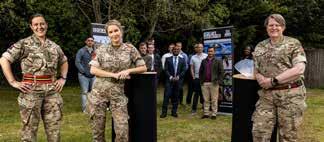

ADR010008
AEG STEMVIEW
CONTENTS
WELCOME MESSAGE
By Catherine Ross
8 SIDNEY POITIER ACTOR, DIRECTOR, DIPLOMAT, COMMITTED ACTIVIST, AND LEGEND

JEBRIL UMO – MY ANGRY BLACK VOICE
CIVIL RIGHTS MOVEMENT IN BRITAIN – A POVERTY OF KNOWLEDGE? By Semper Azeez-Harris
18 WANTED: EFFECTIVE ALLIES WHO TAKE MEANINGFUL ACTIONS
By Lynda Burrell
SCRATCHYLUS – RESETTING THE MINDSET HEALING A FRACTURED SOCIETY IN THESE VERY CHALLENGING TIMES
1968 RACE RELATIONS ACT: REFLECTIONS OF A WINDRUSH DESCENDANT

THE HISTORY OF ENCYCLOPEDIAS ON AFRICAN HISTORY: DISPELLING “DARK CONTINENT” MYTHS By Kwaku
28 TAKING A STAND By Councillor Sanchia Alasia
COMMONWEALTH GAMES 2022 A REVIEW OF THE OPENING CEREMONY IN BIRMINGHAM
36 CHRIS BLACKWELL – THE MAN WHO GAVE AN ISLAND’S MUSIC TO THE WORLD By Kwaku
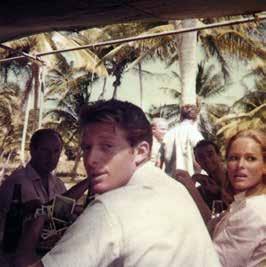
40 WHAT DOES IT MEAN TO BE BLACK IN THE 21ST CENTURY?
By Jebril Um0
41 ROY HACKETT MBE
WHERE IS BLACK AFRICAN LIFE IN LONDON? By Jimi Famurewa
THE ACTIONS OF ONA By Suzette D. Harrison
THE LATE JAMES BERRY –TO TRAVEL THIS SHIP
SLAVERY & THE BANK EXHIBITION AT THE BANK OF ENGLAND MUSEUM
LOUISE DA-COCODIA AND THE DISCRIMINATION FACED BY BLACK NURSES IN THE INFANT DAYS OF THE NHS
BLACK BRITISH JOCKEY ASHLEIGH WICHEARD TAKES THE KNEE BY LYNDA-LOUISE BURRELL
FINDING THE PAST BY KATHY CASIMIR MACLEAN
THE BRISTOL BUS BOYCOTT OF 1963
KEN PITTERSON – FROM RACING ENTHUSIAST TO PADDOCK EXPERT By Catherine Ross
THE WINDRUSH EXPERIENCE EXPRESSED IN MUSIC – FROM 1948 TO 2022 By Catherine Ross
DAL BABU OBE – CHAIR, SEACOLE GROUP
‘GRIME STORIES: FROM THE CORNER TO THE MAINSTREAM’
THE ADVENTURES OF A BLACK EDWARDIAN INTELLECTUAL – JAMES ARTHUR HARLEY
TWO WOMEN: BOTH WITH A PASSION TO COMMEMORATE GLOBAL AFRICAN CONTRIBUTIONS By Kwaku
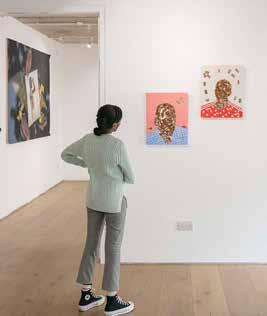
198 CONTEMPORARY ARTS & LEARNING
MAYA ANGELOU: POET, AUTHOR, CIVIL RIGHTS ACTIVIST
YOUR SILENCE WILL NOT PROTECT YOU – AUDRE LORDE
ASSISTANT: Mo Sadegh PRESS & PR: Richard Hillgrove, 6 Hillgrove PR DESIGNED BY: Vivienne Brar ADVERTISING: Ayana Hussein
Thomas
Ross
Burrell
THANKS TO: Stephen Bourne, The Royal British Legion, Mike Bridge, Cherron Inko-Tariah MBE, The RAF, Bishop Grosseteste University and all our contributors, supporters and advertisers. www.blackhistorymonth.org.uk

14 36 54 8 4
12
14
20
22
24
32
42
44
45
46
48
52
54
56
58
60
63
64
66
68
70
72
74
PRODUCTION
SPECIAL
PUBLISHERS: Ian
EDITOR: Catherine
MANAGING EDITOR: Lynda
CONTRIBUTING EDITOR: Kwaku PRODUCTION MANAGER: David Ruiz
BLACK HISTORY MONTH 2022 TIME FOR CHANGE –ACTION NOT WORDS
What a great month for British History! The telling and re-telling of the Black presence in the UK has traditionally covered historical periods way back in time but the immediate past has lots of reasons to commend it as a period full of stories and lessons for Black people that will affect them in the coming decades.
Black History Month is a great time to engage in adventures in learning and for adventures in physical activity. Here are some things to consider, but as you get involved in them, encourage others to join with you. The magazine and website has a lot of articles that point out the need for allies in the workplace and in many other aspects of life. It reminds that steps need to be taken to achieve the change we want to see. Some great examples have been offered by a range of contributors to this issue, sports persons, entertainers, educators, and businesspersons that will help elevate Black people working together and with allies.
This Black History Month also, why not take the opportunity to update yourself on aspects of history and tradition that are becoming more important in the Black community, such things as Nine Nights, the Caribbean wake and the funeral service. Aspects of this celebration of life, an important part of Caribbean culture, are being adopted by other cultures. Things like collecting stories of the contribution of the person to the community helps everyone in appreciating and recognising the contributions of individuals to people and places in the UK. Sometimes it’s the little things people do that have made a difference to individual lives, that have helped unify communities and have just shown that being neighbourly matters. The recent pandemic and the extreme hot weather being experienced this year are challenging communities to look out for and to look after its members.
Learning about Caribbean funeral traditions has become increasingly important to 21st century life as many people of Caribbean descent are forming family units and friendships with others
By Catherine Ross Editor of Black History Month Founder Director, Museumand –The National Caribbean Heritage Museum

who are not of their ethnic group. In dual heritage associations it is such a friendly and loving thing to know things that are important to do, say, and provide when the time comes to saying goodbye. Many of the families who lost friends or family during the pandemic period are still having memorial services, and as those of Caribbean descent come together to do so to acknowledge and celebrate lives, many recall the Caribbean saying often heard at such events, ‘the world has lost a library of valuable experience’.
During the pandemic and since, the issue of Black people not receiving the quality of care, they should expect from the NHS is causing frustration and anger in the community and an increasing number of calls for urgent action to prevent escalating numbers of serious neglect and deaths.
Black people have been battling with such illnesses as sickle cell anaemia, diabetes, cancer, and cardio-vascular diseases and though there are a number of charities and alternative and complementary medicinal methods for dealing with many of these, this Black History Month why not try some of the things that Caribbeans have used from their African traditions. Caribbeans have been drinking ‘bush teas’ for generations
and now many are available in convenient tea bag form or as leaf-blends so there’s none of the need to pick the bush and boil as Caribbeans did ‘back in da day’!! So now we can enjoy an occasional drink of Cerassee or my personal favourite Hibiscus tea daily! Our body’s internal systems will be all the better for it but do check with your doctor if you are being treated for underlying health issues.
Other things we need to be indulging in now that are readily available in supermarkets and stores are the beauty, skin and hair products that Caribbeans have used for generations – aloe vera, cocoa and coconut. These natural and now essential ingredients in commercially produced products mean Caribbeans don’t have to pound, grate, and peel these products, activities not always easy and can often be time consuming. We’ve been using them for generations, they have added to our melanin-rich skin, and as recognised now, darker skin people age more slowly and our skin has a natural glow that have made other cultures warm to and are regular users of what they once called primitive preparations.
On the subject of health, why not add walking to the list of Black History Month adventures. As you walk take time to experience the sights and sounds of the country that Black ancestors have helped build. Probably for the first time enjoy the aspects of history you may not have done before or visit other cities, places or spaces to see where Black people have made a mark. Learning history while improving your health is a great combination activity during a great season of Autumn.
This Black History Month engage in some culinary adventures as well, try food in restaurants, take aways, and from Street Food vendors. However, nothing beats the tradition of being taught at home by a Caribbean elder, so if you are lucky to have one in your family, or you have a friend or neighbour who is from the Caribbean, great, you’re in for a treat. Why not call your time together. ‘Try then Taste’, or ‘Laugh and Learn’, or something fun, as it’s sure to be so…!
Happy Black History Month, a great Time for Change – Action not words!
4 BLACK HISTORY MONTH 2022
black



BLACK HISTORY MONTH 2022 5 6789 P r o s t a t e C a n c e r U K s a r e g s t e r e d c h a r t y n E ng l a n d a n d W a l e s ( 1 0 0 5 5 4 1 ) a n d n S c o t l a n d ( S C 0 3 93 3 2 ) R e g is t e r e d c om p a n y 0 2 6 5 3 8 8 7 Early diagnosis saves lives. Check your risk of prostate cancer in 30 seconds prostatecanceruk.org/bhm-check 1 in 4
men get prostate cancer.
DVSA – Why not join us for a lifetime of safe driving?
The Driver and Vehicle Standards Agency (DVSA) is part of the wider civil service and our remit, as part of the Department for Transport, is to keep Britain’s roads safe.
DVSA carry out driving tests, approve people to be driving instructors and MOT testers, carry out tests to make sure HGVs and buses are safe to drive, carry out roadside checks and monitor vehicle recalls.
DVSA are committed to race equality and being an inclusive employer. DVSA offers a wide range of roles, including apprenticeships across leadership and management, legal, finance, digital, policy, commercial, HR and operational delivery. DVSA apprenticeships are a blend of formal training and on-the-job experience.
If you would like to find out more about working for DVSA and apprenticeships, scan the QR code below. DVSA actively welcome applications from candidates from diverse backgrounds.

Right: A group of DVSA’s Vehicle Standard Assessor Apprentices (VSA’s) celebrating their achievements and successes. Chris Goble a newly qualified Vehicle Standards Assessor (VSA), explains what his apprenticeship means to him: “Joining DVSA as an apprenticeship was daunting at first but I soon settled in and was made to feel very welcome. I have learned so much in my apprenticeship and thank my colleagues for their help and support. I am excited for my future career at DVSA.’’
Below: Stephanie Ezechukwu, Head of Prosecution and Quality, also reflects on her time working for DVSA: “Since joining DVSA in 2021, I have met some amazing colleagues and have been able to make impactful contributions to improve the Agency. I lead a diverse and growing team, so it is really important to me that I am able to develop myself and others.”

Stephanie Ezechukwu, DVSA Head of Prosecution at work in the DVSA
Bring your whole self to work
Bring your whole self to work
Bring your whole self to work
At DVSA, you’ll be part of an innovative organisation that invests in all our people, ensuring we have the diverse skills to help keep everyone safe on Britain’s roads.
At DVSA, you’ll be part of an innovative organisation that invests in all our people, ensuring we have the diverse skills to help keep everyone safe on Britain’s roads.
At DVSA, you’ll be part of an innovative organisation that invests in all our people, ensuring we have the diverse skills to help keep everyone safe on Britain’s roads.
We support and develop our staff. Our passion for diversity and equality helps us create a positive working culture for all.
We support and develop our staff. Our passion for diversity and equality helps us create a positive working culture for all.
We support and develop our staff. Our passion for diversity and equality helps us create a positive working culture for all.
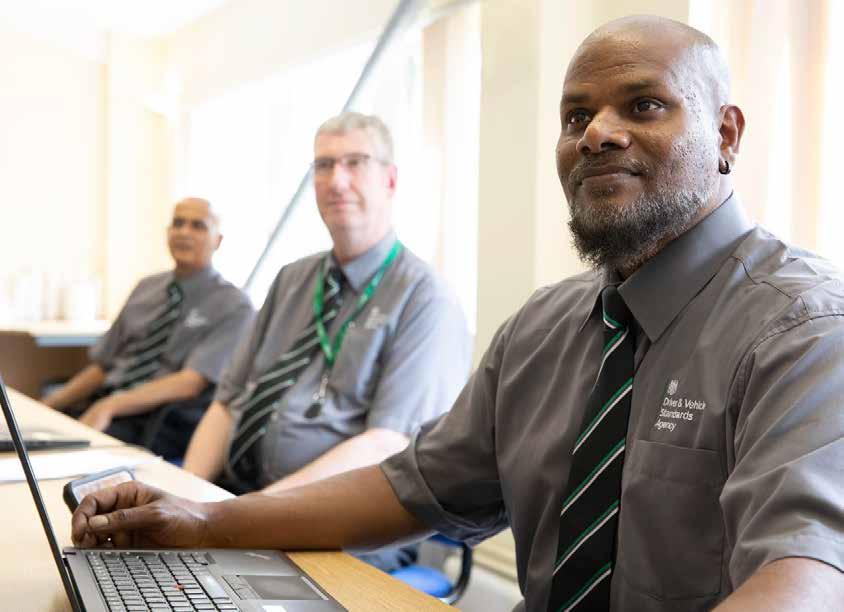
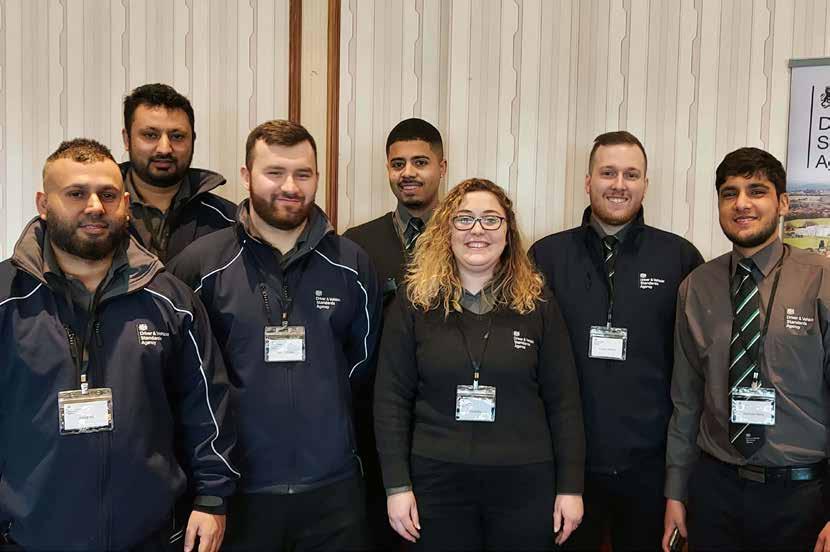
We’re friendly, welcoming and respectful, with lots of opportunities for your professional and personal development.
We’re friendly, welcoming and respectful, with lots of opportunities for your professional and personal development.
We’re friendly, welcoming and respectful, with lots of opportunities for your professional and personal development.
Search for our latest jobs at
Search for our latest jobs at https://careers.dft.gov.uk/

Search for our latest jobs at

BLACK HISTORY MONTH 2022 7
Sidney Poitier actor, director, diplomat, committed activist, and legend
Sidney Poitier will be perhaps best remembered as the first Black actor to win the Academy Award for Best Actor.
Sidney Poitier KBE who died aged 94 on 6 January 2022, was a Bahamian and American actor, film director, and diplomat.
Back in 1964, he was in the headlines becoming the first Black actor and the first Bahamian to win an Academy Award for Best Actor.
And apart from a highly successful film career as a movie star and director, he will also be remembered as a fine diplomat.
Sidney Poitier 1927–2022
We at Black History Month celebrate the life and career of Sidney Poitier who rose along the civil rights movement to become one of America’s leading stars and icons. Poitier was born prematurely in the United States while his parents were visiting from The Bahamas.
While some references give his birth year as 1924, most sources, including Poitier himself, indicate that he was born in 1927.
He grew up on Cat Island, Bahamas, and returned as a teenager to the United States, where he enlisted in the U.S. Army during World War II and served a brief stint in a medical unit.
Upon his discharge, he applied to the
American Negro Theatre (ANT) in New York City. Refused a place because of his accent, he practiced American enunciation while listening to the accents of radio voices and reapplied to ANT six months later.
This time he was accepted, and he began studying acting while appearing in a series of ANT productions.
A long-acting career
In 1946 he made his Broadway debut in Lysistrata.
Poitier’s first credited film role was Dr. Luther Brooks, a Black doctor who treats a bigoted white criminal, in No Way Out (1950). The movie established a significant pattern both for Poitier himself and for the Black actors who followed him.
Poitier pushed the restrictive boundaries set by Hollywood and made inroads into the American mainstream.

Although he had a budding film career, Poitier continued to perform in live theatre and won critical acclaim on Broadway in 1959 with his starring role in Lorraine Hansberry’s A Raisin in the Sun. He also starred in the 1961 film adaptation of the drama.
In The Defiant Ones (1958), Poitier was cast as a prisoner who escapes with a white inmate (Tony Curtis); the two must overcome their racial prejudices in order to elude the police.
The film, which was considered
provocative at the time because of its call for racial harmony, earned Poitier an Oscar nomination for best actor; he became the first African American male performer to earn a nod in the lead category.
He also earned acclaim for his work in Porgy and Bess (1959); he portrayed the disabled Porgy, who loves Bess (Dorothy Dandridge), a drug addict being pursued by a number of suitors.
Poitier made history as Homer Smith, an ex-GI who helps nuns build a chapel in Lilies of the Field (1963). His Academy Award win marked the first time a competitive Oscar had been awarded to an African American male.
Poitier was also just the second Black actor to win an Academy Award (Hattie McDaniel had won a best supporting actress Oscar for Gone with the Wind [1939] but he was the first black actor to grab Best Actor.
Poitier starred in a series of acclaimed films. In To Sir, with Love (1967), he portrayed a charismatic schoolteacher who earns the respect of his students at an inner-city school. Next was In the Heat of the Night (1967), a crime drama that focused on the uneasy partnership that develops between a bigoted white Southern police chief (played by Rod Steiger) and Virgil Tibbs, an intellectual Black Philadelphia detective (Poitier). The film received the Oscar for best picture.
8 BLACK HISTORY MONTH 2022
Opposite: Lilies of the Field; Clockwise from left: A Raisin in the Sun, 1959, with Louis Gossett, Jr. and Ruby Dee; Sidney Poitier, centre supporting the Poor People’s Campaign at Resurrection City, a shantytown set up by protesters in Washington, D.C., in May 1968.
Poitier’s other movie from 1967 was Guess Who’s Coming to Dinner, in which he portrayed the fiancé of a white woman (Katharine Houghton) who takes him home to meet her liberal parents (Spencer Tracy, in his last film, and Katharine Hepburn). The success of the movies made Poitier the top box-office draw of the year.

Often cast playing determined, unflinching heroes, he also redefined roles for African Americans by rejecting parts that were based on racial stereotypes.
Out of such an extensive list of movies, perhaps his most revered films include Lillies on the Field (he won the Best Actor Oscar, a first for Black artists), Best Picture for In the Heat of the Night, Guess Who’s Coming to Dinner and Sneakers
In the movie Mandela and de Klerk (1997) – Poitier portrayed Mandela and co-starred with Michael Caine, who played former South African President F.W. de Klerk, in a story that depicted Mandela’s release from Robben Island and the transition of power between the two men. Poitier was also a director In 1972 Poitier made his directorial debut with Buck and the Preacher, an amiable western in which he played a con-man preacher; his costars were Harry Belafonte and Ruby Dee.
His early directorial movies were not a success, however the comedy Uptown
Saturday Night (1974) was an enormous hit, thanks to the chemistry between Poitier and costars Bill Cosby and Belafonte.
Poitier then reteamed with Cosby on Let’s Do It Again (1975) and A Piece of the Action (1977).
Off Screen achievements
Not only was his film career legendary but many will also remember Sidney Poitier for his off-screen achievements as well.
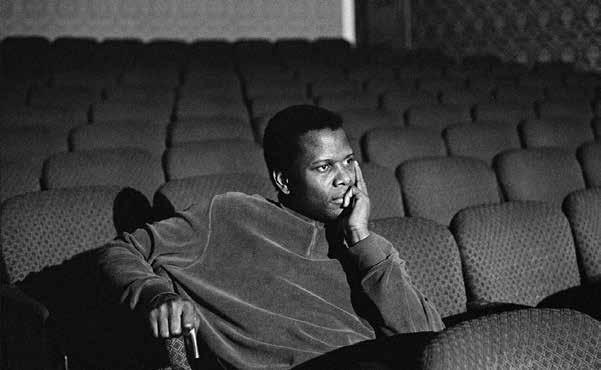
He was an unparalleled actor, a committed activist, and a beloved family member.
He played a visible role in the civil rights movement, marching alongside protesters at Martin Luther King Jr.’s March on Washington in 1963 and traveling the South with fellow activist and actor Harry Belafonte.
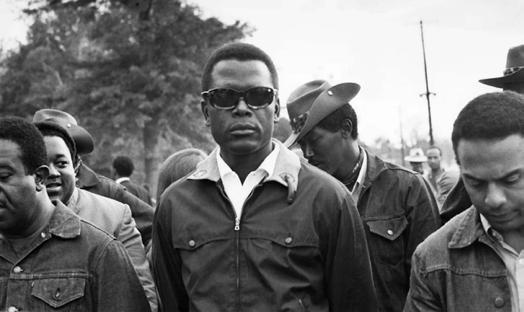
A dual citizen of the United States and The Bahamas, he served as ambassador to Japan for The Bahamas from 1997 to 2007.
In 2009 he was awarded the U.S. Presidential Medal of Freedom.
Poitier chronicled his experiences in This Life (1980) and The Measure of a Man: A Spiritual Autobiography (2000). Life Beyond Measure: Letters to My GreatGranddaughter (2008) was a volume of advice and insights in epistolary form. He also released a suspense novel, Montaro Caine, in 2013.
Perhaps the most important life
lessons he imparted in his autobiography came from his father. “Of all his teachings, the most enduring was the one about the true measure of a man,” Poitier wrote.
“That true measure was how well he provided for his children, and it stuck with me as if it were etched in my brain.”
Many awards and honours
Poitier received several honors and awards during his lifetime. These included a Grammy Award, two Golden Globe Awards, and a British Academy Film Award.
Poitier also received numerous honours during his lifetime including the Academy Honorary Award for his lifetime achievement in film in 2001.
In 1992, he received the AFI Life Achievement Award and two years later received a star on the Hollywood Walk of Fame.
In 1981, he received the Golden Globe Cecil B. DeMille Award and in 2016 he received the BAFTA Fellowship.
In 1995, Poitier received the Kennedy Center Honor.
However perhaps the two most meaningful awards were being the Knighthood awarded to him by H. M. Queen Elizabeth II in 1968 and The Presidential Medal of Freedom, the United States of America’s highest civilian honour, awarded to him by President Barack Obama in 2009.
BLACK HISTORY MONTH 2022 9
I am extremely proud the be the Head of Diversity and Inclusion Reform within the Home Office.

The Home Office is one of the great departments of state with a wide-ranging remit. For me, the essence of our work is around security and safety. That means reducing crime, safeguarding people who may be vulnerable, as an example preventing violence against women and girls. The Home Office is also responsible for policing and immigration, as well as issuing passports. The work we do touches on the lives of many.
To do this well it is essential that the Home Office reflects 21st century Britain, being representative of the communities we serve and the people we come into contact with. That means being accountable for our actions and being truly inclusive in all we do. We must be an organisation that improves the lived experience of all colleagues, whatever their background. My team have a variety of different personal experiences and perspectives. At the heart of our way of working is respect for each other, listening to each other, and seeing how we continue to improve further the experience of our colleagues and citizens.
When I chose to join the Home Office it was because I was keen to be part of the diverse nature of our work which affects every citizen as well as all those who enter the United Kingdom. Next year marks a special milestone for me, as I will have worked in the Home Office for 30 years and in that time seen 13 different Home Secretaries, starting with Ken Clarke and this week welcoming Suella Braverman.
Back in the 1990s I originally joined as an Administrative Assistant, the most junior grade in the Civil Service. My personal experience of working at all levels across the Home Office up to Director level has shaped how I lead. Giving others the opportunities I had is a real responsibility and helping everyone regardless of background to reach their potential.
I was fortunate to be given the opportunity to learn, grow and specialise in a profession; in my case programme and project delivery and being supported to gain qualifications in Business Architecture. That is not an uncommon experience in the Home Office, where investing in our people and their professional development is a key focus for us. This helped me to work in multiple departments over the years in high-profile positions. I led the Greater London Estate Consolidation Programme, and then multiple projects in our major airports. No free flights, but really exciting and valuable work! More recently that’s meant being in the thick of it, heading up work needed to deliver the EU Exit and the Covid 19 early response. I have held multiple leadership positions driving efficiencies, strategic planning and transformation.
I am extremely proud to now be in a role where I lead cultural transformation spanning 40,000 staff across multiple regions, delivering evidence-led D&I reform based on increased accountability, inclusion, and a commitment to be representative of the communities we serve. I work across a complex matrix of
JOIN
SHARON
HEAD OF DIVERSITY AND INCLUSION REFORM

stakeholders to ensure appropriate success measures, using data as a strategic asset when engaging and influencing staff and citizens.
I have been proud to be a Race Champion and a mentor, coach and sponsor to many, which is incredibly rewarding. My only ask of each person that I mentor is that they make a personal commitment to mentor others – “each one, teach one”. I am passionate about ensuring that every individual feels valued, appreciated, and respected regardless of background.
The Windrush review recommendations have helped to shape our approach to ensure diversity and inclusion is future focussed and recognises the breadth of the diversity landscape. We have made significant progress in becoming a listening and learning organisation. I have seen the department work towards righting the wrongs of Windrush. I am proud to be a Windrush volunteer. Whilst some progress has been made, we still have a long way to go and I know that as a Department, that is something we are committed to. D&I needs to be at the heart of everything we do, and that is a key area which we continue to focus on as we build on our successes.
There are so many opportunities and careers available that I would encourage everyone to look at working in the Home Office to see what we do, how we’ve changed and where we are going.
I would encourage everyone (particularly those from ethnic minorities where we have low representation at Director level) to aim high. I would love to see more Black people at Senior Civil Servant level. Increased diversity and the opportunity to bring your knowledge, skills and experience to make a real difference to our work is invaluable. Being representative of our communities can only help us to understand, deliver and make a difference, with inclusion being at the heart of our delivery.
Every day our teams across the UK and beyond deliver outcomes to improve citizens’ lives. Our work is challenging, high profile and rewarding. To deliver it is a team effort, and we rely on talented people with a wide range of skills and experience. And that’s where you come in: whether your skills lie in customer service or accounting, software engineering or making policy, it’s likely we’ll have a role you’ll be interested in. Your ideas and input will mean so much more working with us, because everyone brings their own insights, background and experiences to our work. And it’s this diversity of thinking that is transforming the way we work – and the work we do.
US Interested in working for us?
You can view further information about our roles at: www.civil-service-careers.gov.uk/departments/working-for-the-home-office/ and scan the QR code for our latest job opportunities. 10 BLACK HISTORY MONTH 2022
1. Why did you choose to join the Home Office?
I joined the Home Office after a long spell in the private sector in a job which took me away from home. Whilst it was nice to travel, I wanted to settle down and have a family. I saw an advert for a position in the Home Office which interested me. I realised that there weren’t many people from my background that worked for the Home Office, so I saw joining as making a positive change.
2. How long have you been in the Home Office? 21 years!
3. What is your day-to-day work like?
Every day is busy, different, and exciting in equal measure. I am a Deputy Chief Caseworker working on the EU Settlement Scheme, dealing with cases involving EU nationals and their relatives who wish to settle here in the UK. The cases vary in complexity and can involve vulnerable applicants, fraudulent applications, minors, and other challenges. I also Chair The NETWORK which is the Home Office’s race staff support group.
4. What do you enjoy most about your job?
I love the variety in my work and the commitment and passion of the people I work with. I love working for an organisation that cares for its staff and although we know we are not perfect; we’re striving to make the Home Office a better place for all staff, so that we can serve the public to the best of our ability. Above all, I most enjoy serving the public in the way that I would like to be served. In my NETWORK role, I really enjoy supporting colleagues, Managers, and the wider Home Office – it’s so rewarding!
5. What has your career journey been?
I wanted to be a lawyer, so trained to be a Barrister and Solicitor and practised law in Nigeria for a few years. On my return to the UK, I worked in the private sector managing contracts for a service delivery company for local authorities. In 2001, I joined the Home Office as an Immigration Officer. I’ve had various roles in the Home Office, including operational delivery, commercial, human resources and policy. I am currently a Deputy Chief Caseworker, a role that I do in parallel with my position as the Chair of the NETWORK.


6. What are the benefits of being in the Home Office?
I love the flexibility as it’s allowed me to have a good work-life balance, which I didn’t always have in the private sector. I’m able to spend time with my family, pursue my hobbies, all whilst making a strong contribution in the workplace. The diversity in the Home Office is comparatively good but we are continuously looking to improve.
7. What would you say to someone considering a career in the Home Office?
The Home Office is a great place to work! Senior managers and colleagues care about staff and take their wellbeing seriously. I always recommend the Home Office to people I meet and especially to those who have never considered a career in the Civil Service. I joined the Home Office despite some negative views within my community, and 20+ years later I am still here and enjoying my work as much as ever!
TEEMA
RACE PROGRAMME LEAD –PUBLIC SAFETY GROUP
1. Why did you choose to join the Home Office?
I saw the Home Office as a dynamic department with interesting policy areas. I was particularly interested in working in policy areas that look to protect the most vulnerable in society, something that I have always been passionate about.
2. How long have you been in the Home Office?
4 years
3. What is your day-to-day work like?
Every day is different but my role is focused on making the Home Office an inclusive and diverse environment for ethnic minorities. I help to ensure that the department is representative at all levels) and that as an organisation we understand the diversity and cultural needs of the public we serve.
4. What do you enjoy most about your job?
I love the fact that I represent so many voices and have a focus of implementing positive cultural change within a dynamic and strategic organisation. I get to work with talented colleagues from across the department and have the privilege of holding senior leaders to account. It’s not easy but when you see the tangible impact of your work, there is no better feeling!
5. What has your career journey been?
Believe it or not after I completed university I set out to be a civil servant. Whilst writing my Masters’ dissertation I was able to get on to the Summer Diversity Internship Programme which gave me the first taste of Civil Service life. I joined the Department of Work and Pensions, working in HR and I loved it. After a short time away, I joined the Civil Service full time at the Department for Education working on free schools (new schools) where I opened 3 brand new schools. After 4 years I decided to pure my interest in protecting vulnerable people in society, so I joined the Home Office as part of the Tackling Child Sexual Abuse Unit. I undertook various roles in the unit including international focused work. In January I moved into a brand new role which focuses on internal race diversity.
6. What are the benefits of being in the Home Office?
The number of talented colleagues that make up the department - there is talent at all levels of the organisation. This has enabled me to develop quickly and become a better civil servant.
7. What would you say to someone considering a career in the Home Office?
Be prepared for hard work, but it will make you a better civil servant! I’ve always had the belief that if you can work in the Home Office and thrive, then you can probably thrive in any other government department.
FASIL THE NETWORK CHAIR
BLACK HISTORY MONTH 2022 11
Clenching my jaw with shackles because the moment I open my mouth you say my english is wack. Can you speak African? No, I only speak black. What is speaking black? Speaking black is making sure that when you’re speaking facts you gotta stay on track before they look at you shoot and attack.
Harriet Tubman came from a shack. Dave helped our generation fight back. Don’t stop me now I’m ready to attack.
My voice is only heard when truth has been stirred. There is music in my melanin, yeah I talk hella black. The memory of slave ships drown my mind. Writing these words to help past the time.
Slavery was abolished that’s what I heard on the news but that’s far from the truth because people like me still remain captive to our skin colour of which none of us can choose.
If you’re black then you can fight. It shouldn’t be a privilege to have skin that is white.
When a black man walks, when a black man talks, where a white man walks. Doesn’t fear follow near. Or so they say. Can you hear the whispers from ear to ear?’’ Black doesn’t crack, it just tears, Now tell me why am I living in fear?
Weeping black mothers tears the same tears that keep graveyard grass green. I hate to see black on black crime. Come on bruv we’re all on the same team. They turn us against each other, they
JEBRIL UMO –MY ANGRY BLACK VOICE
divide us, segregate us. Division is how they win but with unity they will crumble. When you hold those sacred sounds on your tongue do you feel less holy. The monkey sounds.
Hahaha. There goes the monkey. Because to you for some weird reason my skin just looks so funky. Loud in laughter silent in our suffering. Black mothers cries. It was just an inhaler. Cap. That’s all lies. But yet you have no respect for her baby boy’s demise. No matter how hard she tries, no matter how thick her thighs or her lips, her son’s melanin still permits you to aim, fire and shoot. Oh shoot another innocent black man killed. Our execution is still stuck on a painful loop. Police sirens sound like amazing grace being sung at a funeral.
How many more times will I have to hear one of my brothers saying mumma i’m fine. Before I hear his scream collide with the sound of your bullet ricocheting through the air as you shoot. You’re just jealous of our roots. Roots that we don’t know because you kept my ancestors hanging from the necks with their toes stroking the ground. Don’t look away, you can’t turn back now.
Our melanin is like a pirate’s sacred loot.
A war on black boys. Walking down the street to hear the riots roar. No wonder as a child we grew up with toys shaped as guns. From the age of six I had learned my rights that was my definition of fun. Well can you blame us?
Starting up all these laws and curfew to tame us.
I want justice for Breonna Taylor, a young black woman shot dead in her own bed.
You’ve gone from whipping holes in our backs to shooting bullets in our children.
Racism ain’t gone my man it’s just hidden.
I’m so tired of running, I’m out of breath. I’m so tired of being judged before you get to know me. I’m so tired of being at an unfair disadvantage. I’m so tired of being tired. I’m so tired of seeing my uncle fired from his job because you say that his nappy hair makes him look uninspired. All because you see black as undesired. But I am not tired of being black. My black voice may be savage at times but I wouldn’t change it for any privilege in the world.
And that is the truth, the truth all y’all lack.
I’m not tired of being black.
ABOUT THE AUTHOR
My name is Jebril Umo. I am a 14 year old black male from south east London. I have always had a passion for writing and it is something that I am good at. Being a young black boy comes with many challenges. However, I always stay resilient to them and I never give up something my mother had taught me from when I was young.


12 BLACK HISTORY MONTH 2022
Everyone
Coca-Cola Europacific Partners (CCEP) is the world’s largest independent Coca-Cola bottler. CCEP GB makes, sells and distributes soft drinks for every occasion and sells more than four billion bottles and cans every year.
At CCEP we have a philosophy that ‘Everyone is Welcome’. This ethos underpins everything we do, creating an environment where everyone is encouraged to ‘Be Yourself, Be Valued, Belong’. We strive to provide opportunities that are open to people from all demographics and backgrounds.
It’s this mantra that means, as a business, we endeavour to challenge the underrepresentation seen in the corporate world. Channelling this mindset when recruiting for those entering the business for the first time is the best place to start.
Having the right mix of talent for our future sustainability is vital – that means working with and fostering talent from all demographics and backgrounds, with a focus on those from black and Asian heritage.
“
would like to see Black people visibly represented at every level of our business, especially in senior leadership roles within the next two years.

With more than 11 million national records within our care, Black History Month 2022 is a vital reminder of our commitment to increasing the use and experience of our collections for more people.
Our collections span 1,000 years of difference, debate and progress. Created from the perspective of state and empire, we hold important records that bear witness to past injustice, and the long and continued fight for racial equality.
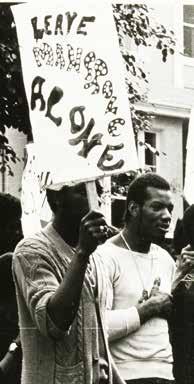
We are proud to play our part in finding greater ways to make these significant records more accessible.

Archives are for everyone because they are about everyone –past, present and future
Find our Black British history resources at nationalarchives.gov.uk/black-history Black Power demonstration and march, Notting Hill, 1970catalogue reference MEPO 31/21 BLACK HISTORY MONTH 2022 13
is welcome
I
” Lou Cenac Senior Manager, People & Culture Business Partner COC1541_Everyones Welcome Advertorial_188x133mm_AW2.indd 1 19/08/2022 17:25
Civil Rights Movement in Britaina poverty of knowledge?


The Civil Rights Movement is emotively charged by historical profound moments and figures.
But as an immediate thought does Civil Rights conjure images of Britain’s own Civil Rights movement to you?
For me (and perhaps you) there are varying images of immense magnitude.
The Klu Klux Klan (KKK) standing over a black victim, Martin Luther King rallying people to protest in peace, Malcolm X rallying people to protest “by any means necessary”, Claudette Covin and then Rosa Parks, churches burning, crosses burning, heavy handed police, Black Panthers, or the gruesome date of August 7, 1930, where a baying mob of thousands in Marion Indiana lynch two men. The stark image of thousands of men, women and children gleefully staring at the camera emboldened by their cowardly lynching of these two men is chilling.
14 BLACK HISTORY MONTH 2022
Black Panther Movement at the Mangrove demonstration in 1970
The images are endless, graphic, disturbing, fuelling outrage, sadness, dis-belief, confusion and more.
But these images are distinctly American. Civil Rights Movement and America seamlessly go hand in hand.
There is (to a degree) this incongruous, paradoxical romanticisation of the movement and America. Black American people (and whites too) standing up for Black Civil Rights.

In this strange, perhaps slightly macabre emotion I almost want to be there in the 60’s Deep South standing in unison with my brothers and sisters in this hugely dangerous period. It was a time where blacks had to fight to be humanised.
But there was a powerful Civil Rights
KEY BRITISH CIVIL RIGHTS EVENTS
1919 Uprisings in London, Cardiff and Liverpool
1931 Dr Harold Moody establishes the League of Coloured Peoples
1948 British Nationality Act; SS Empire Windrush arrives at Tilbury
1958 Uprisings in London and Nottingham
1962 Commonwealth Immigrants Act
1958–1966 Notting Hill Carnival begins (exact date is disputed)
1963 Bristol bus boycott
1965, 1968, 1975 Race Relations Acts
Movement within UK. For me and maybe for other Black British people there is a poverty of knowledge regarding our own movement.
Partly that is due to the ‘American Imperialism’ (if you will) through Western global media (as a whole) on the ideology and ‘ownership’ of ‘Civil Rights Movement’.
Indeed it is fair to say that in many ways popular British media have (to an extent) had a distinct bias to that Americanism of the Civil Rights Movement. This bias has been to the detriment of the British black movement.
There have been some telling British films – think the powerful SUS (2010) starring Clint Dyer. More recently, the talented Sir Steve McQueen directed the
1967 British Black Panther party established

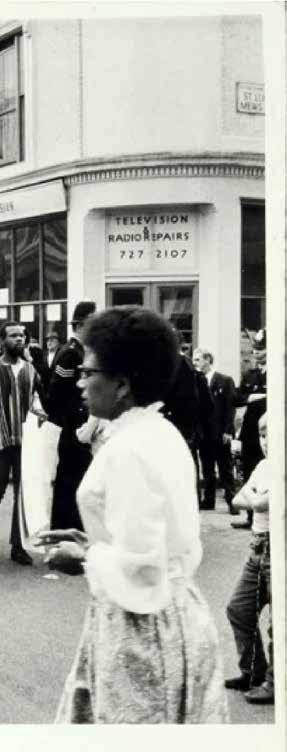
1970 Trial of the Mangrove Nine
1979 Royal Commission on Criminal Procedure (led to repeal of the ‘Sus laws’)
1981 Brixton uprisings and Lord Scarman report
1999 Macpherson Report published following the Stephen Lawrence Inquiry
2011 Riots following the shooting by police of Mark Duggan
telling series Small Axe (2020) examining three events from 1981 – in January, the New Cross Fire which killed 13 black teenagers, March, Black People’s Day of Action, which saw more than 20,000 people join the first organised mass protest by black British people: and the Brixton riots in April. I think there is a poverty of such powerful historical British Civil Rights work.
Perhaps more damningly and maybe harder to digest is an idea.
As blacks (individually) within the UK we are complicit to this poverty of knowledge, regarding our own Civil Rights Movement. We have to a degree been sucked into an inertia of sorts where we do not really push in a concerted, sustained,
BLACK HISTORY MONTH 2022 15
and holistic manner for knowledge regarding the UK Civil Rights movement.
I would strongly argue that an American child today has a deeper, more knowledgeable understanding of the American Civil Rights Movement than a British child would of our own movement.
How many British children could name important events within our Black British history? Or how many could name significant figures? They could however reel off a list of American Civil Rights moments or figures. Or more significant reel off just exactly who Winston Churchill and his importance to the ‘world’ (despite his own racist attitudes) some 60 years after his death.
This is nothing to do with the fact that
perhaps the American Civil Rights Movement was somehow more profound than ours. That is if we want to play the unsavoury game ‘my Civil Rights Movement is better than yours’.
No, the answer to why our movement continues with this poverty will surely be multi-faceted.
For me however as I write this piece, I am conscious of the fact that I have to be careful that I do not come across as speaking for everyone. Not everyone has a ‘poverty of knowledge’.
I am sure there are those reading this who have a deep knowledge of our own movement. That knowledge in turn they have abundantly blessed their children with. I can vividly see the collective raising
of eyebrows at my assertions.
Hopefully to quell your thoughts or criticism of me.
On a personal level I am acutely aware of my inadequacies as a Black British male suffering from a ‘poverty of knowledge’.
I am ashamed in many ways that maybe here I am writing this piece on our movement when I am sure that my poverty of knowledge is shocking.
I know Black History month, the Brixton Riots, Tottenham Riots, Mary Seacole, names like Bernie Grant, Darcus Howe, (despite what people might say) the influential Diana Abbot and more.
But Sir Steve McQueen’s series was particularly telling for me. It showed me how much I did not know. How superficial
Mangrove Nine protest
On 9 August 1970, a group of Black Power activists led 150 people on a march against police harassment of the black community in Notting Hill, London. They called for the ‘end of the persecution of the Mangrove Restaurant’. Between January 1969 and July 1970, the police had raided the Mangrove Restaurant twelves times. No evidence of illegal activity was found during these raids.


Local Police Constable Frank Pulley remained convinced that the restaurant was ‘a den of iniquity’ frequented by ‘pimps, prostitutes and criminals’. At the 1970 march in defence of the
Mangrove, violence broke out between the police and protestors.
The following year nine men and women were put on trial at the Old Bailey for causing a riot at the march. Their names were Darcus Howe, Frank Crichlow, Rhodan Gordan, Althea JonesLacointe, Barbara Beese, Godfrey Miller, Rupert Glasgow Boyce, Anthony Carlisle Innis and Rothwell Kentish. These men and women became known nationally as the ‘Mangrove Nine.’ When all nine defendants were acquitted of the most serious charges after a long 55-day trial, it was widely recognised as a moment of victory for black protest.
16 BLACK HISTORY MONTH 2022
The owners of the Mangrove restaurant after their court appearance at Kensington Petty Sessions on 15 August 1970.
my knowledge was? How little I invested my time to teach my own children the knowledge regarding the history of Blacks in the UK. How my own poverty of knowledge of the British Civil Rights movement was in fact self-induced due to complacency.

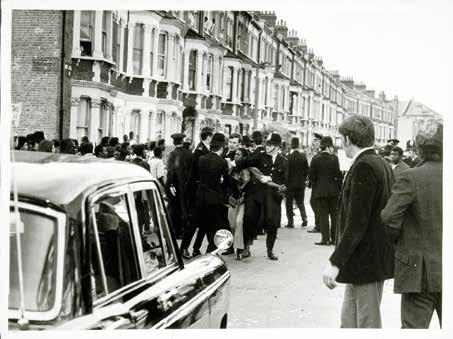
From names who died like Cynthia Jarret (a catalyst for the Broadwater Farm Riots 1985), Derek Bennett, Joy Gardener, and Mark Duggan (and the 2011 UK wide riots that followed his death).
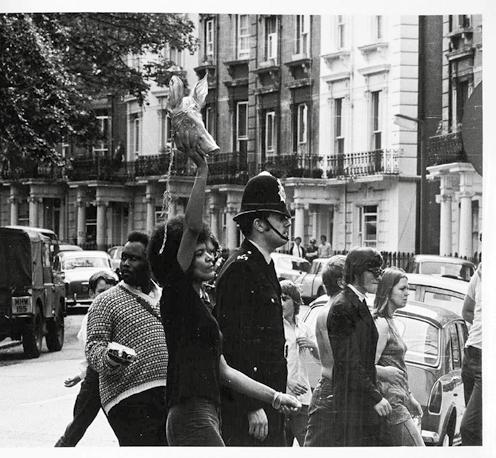
To pivotal moments-think 1967 when American activist and leader of Student Nonviolent Coordinating Committee (SNCC) Kwame Ture (formerly Stokely Carmichael) spoke at a gathering in Camden. He inspired black people living in Britain to ‘organise
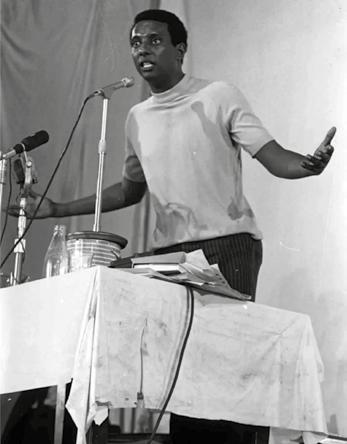
against prejudice and white power’.
My knowledge was and is merely the proverbial ‘tip of an iceberg’. I know dates.
I know names. I know moments of time.
As is always the case things/changes need to start with the individual and for our children at home.
It is not a poverty of knowledge but rather (in may case it seems) a poverty of pushing my own access to that knowledge and then imparting this knowledge to my children. Thankfully, my children are consciously individual.
It is a telling, and painful realisation that my own inertia and ‘poverty of knowledge’ must be addressed.
By Semper Azeez-Harris
BLACK HISTORY MONTH 2022 17
Kwame Ture
WANTED: Effective Allies Who Take Meaningful Actions
I don’t want you to just dress like me, but to call out behaviours that hurt, harm, and hamper my progress at work.
I don’t want you to just speak like me, but to speak up for me when policies and procedures block my progress, and for other Black people who can’t or don’t get seen or heard.
I don’t want you to just live near me, but to oppose the gentrification that destroys our long-established neighbourhoods and our communities.
I don’t want you to just eat Caribbean food, but to support other Black businesses and enterprises, and the communities behind them.
I don’t want you to just listen to Black music, but to listen to, appreciate and recognise those that created it and be an ally to their communities.
I don’t want you to just decolonise the curriculum, but to employ more Black educators and support staff and embed Black history into the curriculum.
I don’t want you to just celebrate Windrush Day and Black History Month, but to challenge inequalities all year round and recognise the power and potential of equality, diversity, and inclusion to create stronger teams, new ways of working and more successful organisations.
I don’t want you to just accept me and be your ‘black friend’, but to be an ally to other Black people and listen to their experiences and opinions, because I don’t represent or speak for all Black people.
I don’t want you to just acknowledge white privilege, but to use the platforms you have to take action and enable a marginalised individual or group to progress, thrive and fully contribute.
I don’t want you to just take nominal steps to improve the status quo by using me as a token Black presence, but to open doors to other marginalised groups and become a more equal, diverse, and inclusive workplace.
I don’t want you to just open up opportunities for change and then leave me to fix things on my own, but for us to work together to find solutions and make our workplace the best it can be for everyone.
I don’t want you to just talk about and enjoy the fun stuff about my culture, but to have some real conversations and get to know the real me, including my ambitions, my concerns, and my potential. My culture offers far more than music, sport, dance, and food – for me and for you.
I want you to know that as an ally, you will be privy to and enjoy rich cultural resources and share the benefits of achievements and contributions that are still being revealed, and those yet to come, still waiting to be discovered. There is a Caribbean saying that perfectly describes the need to work together and support one another’s self-realisation for the benefit of society as a whole… “Today for you, tomorrow for me!”
By Lynda Burrell
18 BLACK HISTORY MONTH 2022
CHANGE … TIME FOR
HP
Every year we welcome a community of interns with great minds, and this year is no different. At HP, interns are our future leaders, a place where they can follow in the footsteps of our CEO, Enrique Lores, who began his HP journey 30 years ago as an intern.
At the heart of our company is diversity, equity and inclusion. They strengthen our culture, unite our teams and inspire new forms of progress in our communities. The benefit of working with a diverse team and creating opportunities for mentorship at HP will have a lasting effect on your career.
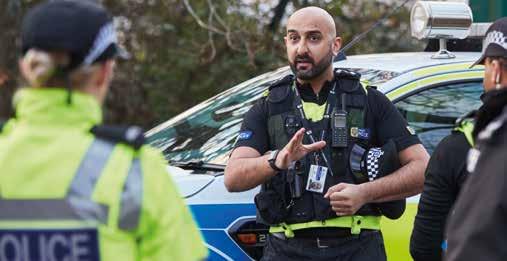

A HP internship will enable you to work on projects that have real lasting impact.
Join our group of diverse thinkers and start your career.

Applications start Autumn

As an intern at HP, you will have
Make a difference
We ensure our interns have substantial projects that make a lasting impact even after they’ve left HP.
Meet people
You will be encouraged to network with team members, stakeholders, and leaders to build


that last a lifetime.
Grow your skills

Whether it be a personal branding workshop or an





grow
finance,

person
host
as

2022
Internships
connections
introduction to
we
a variety of events to help you
as a
and
an employee.
an opportunity to… Apply now jobs.hp.com/students-graduates/?job_ type[]=Apprenticeship&job_type[]=Graduate&job_ type[]=Internship BLACK HISTORY MONTH 2022 19
SCRATCHYLUS
For example, The Colour Bar, it was a crime for Black people to learn to read and write, restriction of movement, work without pay.
Thank goodness for people of colour that came along like Marcus Mosiah Garvey, Malcolm X, John Hendrich Clarke, Rastafari, Emperor Haile Selassie among others who came along and reminded these people of their great Ancestry, History, and the greatness they have achieved and can carry on achieving.
Many organisations were born from this new awakening.
Can you explain how allies are important and their role.
Just like any other organisation representing Justice, the people who are at the forefront of the oppression must be at the forefront of the strive for justice, always with the attitude that if someone proposes to help with and facilitate their cause they shouldn’t dismiss with ego and arrogance they should always exercise grace and due diligence in order to achieve the aims and objectives.
What message do you have for our readers?
As a person that has many reasons to be optimistic about mankind and womankind despite all the suffering and woes of the world Resetting The Mindset’ is key to real change. Big up the people working for others despite the constraints.
As I say The Healing:
‘’ It will be sunny again, it was cloudy then but soon we will be ready to rise,
Looking good feeling good focused on the prize,
We caught up with Scratchylus to talk about this year’s theme for Black History Month 2022; ‘Time For Change Action Not Words #ResetTheMindset’ and hear what he has to say about how real change can be achieved by Resetting our Mindsets
What does ‘Reset The Mindset’ mean to you. Scratchylus: First of all I would love to extend my love and gratitude to all those who have a healing spirit, mood and attitude in these very challenging times, more Love Comfort and Guidance always.
In order to Reset The Mindset we have to have the capacity to heal which takes empathy, overstanding and most importantly not being in denial. We have to rid ourselves of false perceptions, harmful agendas, ignorance and arrogance and replace it with kindness for one another, encouragement, grace, gratitude and respect for your fellow human beings.
The aspiration for change of mindset and understanding injustices seems to be gathering pace in recent years. This has been highlighted by the death of George Floyd, The Windrush Scandal and the negligence that led to Grenfell. From my personal experience although society seems to have become more politically divided it has come together more spiritually. Naturally this is largely to do with the increased interaction between our communities which has laid the ground for tolerance empathy and ultimately healing.
Can you expand on why society over the last 2000 years has been taught largely about slavery, and why there is a lack of understanding regarding Black people’s heritage.
Society over the last 2000 years has been deliberately Institutionalised by the slave masters and their colleagues in order to maintain their wealth and privilege. In order to get everyone on board they had to create negative narratives, negative stereo types along with racist laws and practises to keep the status quo.
After all the pain there’s been the pain we’ve seen and after all that’s said and done,
It’s time to put a smile on their face. It’s time to have some fun.
Scratchylus is an Award Winning International Artist whose mission is to Reset The Mindset , educate , uplift, enlighten and empower through Word Sound and Power. The messages in his music provoke thought and inspire us to do our best work and be our best self.

Scratchylus will be touring Universities Colleges and public and private organisations with his positive uplifting and educational messages as part of the ‘Reset The Mindset: The Healing Tour’.
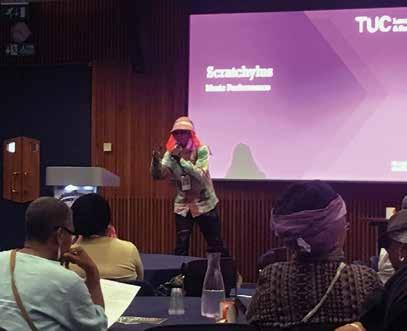
Please do get on board with this important tour .
For further information about the tour and bookings contact: ukuniversitytourbhm@gmail.com
For more info on Scratchylus reverbnation/scratchylus
20 BLACK HISTORY MONTH 2022
Resetting The Mindset Healing a Fractured Society In These Very Challenging Times CHANGE … TIME FOR
and Plumbing & Heating











IS ALWAYS WITH YOU. A TRADE Electrical
Apprenticeships If you’re leaving school or college this year and you’re worried about the cost of university and finding a good job afterwards, a JTL apprenticeship could be a better option for you. With a JTL apprenticeship you can launch a rewarding lifelong career as an electrician or a plumbing & heating engineer, and once fully qualified you can go on to earn an annual salary of £32k or more. Get your career in the trades started today: jtltraining.com/get-a-trade 0800 085 2308 BLACK HISTORY MONTH 2022 21
Reflections of a Windrush Descendant

My
parents and extended family were among the group of immigrants in the 1960s for whom attempts were made to legislatively address the depth of racial discrimination and societal exclusion they faced; for example, being denied public housing, while at the same time being also denied a mortgage or the ability to purchase insurance, all because of the colour of their skin. The Race Relations Acts of 1965, 1968 and 1976 emerged, offered varying degrees of protection against racial discrimination, with each Act strengthening weaknesses in the preceding one.

The Race Relations Act 1965 was the first Act but did not provide any relief to my relatives from any of the fundamental barriers that society had constructed for them (and others). Within months of its enactment, the defects and deficiencies of the Act were obvious; for example, the Act made discrimination in some limited respects a criminal offence punishable by a fine. However, people who discriminated, such as landlords and business owners were prepared to pay damages in civil cases, or a fine in a criminal case, as the price for continuing to subject a section of society to acts of indignity. It therefore could not have remained in place if racial inequality were to have been treated as a serious social problem.
The pressure to address these short¬comings was immediate and extensive, which coincided with the Political and Economic Planning (PEP) report that was published in April 1967. The report documented multiple instances of racial discrimination and concluded that there was substantial discrimination in Britain against non-white immigrants in employment, in housing and in the provision of certain services, such as motor insurance and car hire. The report was largely responsible for the 1968 Act which followed but could also be seen as representative of the process of the changes taking place at the time, particularly in the United States. Consequently, Parliament yielded to pressure and the second Race Relations Act was passed in 1968, strengthening the provisions of the 1965 Act.
The Race Relations Act 1968 prohibited discrimination in both public and private employment, housing and public facilities; this was crucial because these were the spheres in which discrimination against the newly arrived immigrants took place most frequently and had the most significant bearing on most aspects of their
everyday lives. Additionally, discrimination within the terms of the 1968 Act later became known as direct or intentional discrimination.
The Race Relations Act 1968 therefore began to prevent and even dismantle barriers blocking equal access to services, public facilities, housing and employment. However, the legislation being based on complaint system belied its weakness; thus, a new strategy became necessary, which was provided in the Race Relations Act 1976 Its significance was not only tightening up against race discrimination in employment, providing some protection from summary dismissals of black workers from their jobs, as often occurred, but also legislated against direct discrimination. It moved the problems of racial disadvantage away from being deemed to be one solely on the basis of interpersonal relations and laid the foundations for my family to become homeowners and later the more comprehensive Race Relations Act 1976 and consequent policies and regulations that have since advanced equality generally in the UK.
DR VIVIENNE CONNELL-HALL (PHD) Sociologist and Visiting Lecturer in Social History
22 BLACK HISTORY MONTH 2022

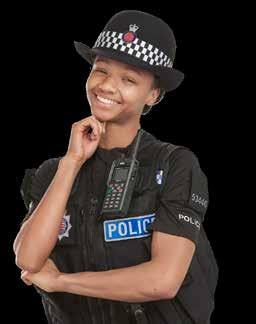




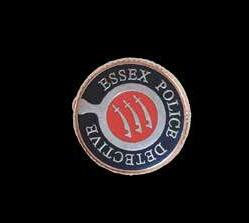



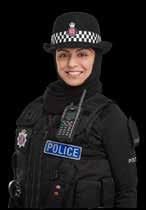

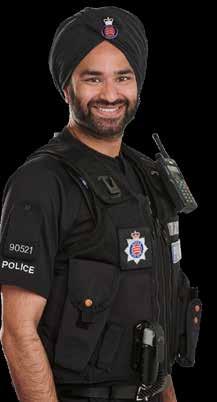

A CAREER THAT Join Essex Police www.essex.police.uk/fitthebill values difference Apply Now BLACK HISTORY MONTH 2022 23
The History of Encyclopedias on African History: Dispelling “Dark Continent” Myths
Last year, Zimbabwean President Emmerson Mnangagwa signed copies of a special edition of an encyclopedia entitled ‘The Africa FactBook’, to be sent to all the heads of states in Africa. These were limited physical copies of an 800 page tome.
The blurb for the encyclopedia in part read: “The Africa Factbook is a response to 500 years of silence whilst others spoke on our behalf.” It is also sub-titled ‘Busting The Myths!’ President Mnangagwa explained the reason for the sub-title, saying:
“The myth that black people of Africa have no history. The myth that the great Zimbabwe walls were not built by us indigenous local people. The myth that Africans have never invented or discovered anything. All these and other myths are solidly busted by scientific facts, implacable sources and astute scholarship.”
His forthright assertions makes it is necessary for us to go back a bit into history. The late 19th British explorer and colonialist Henry Stanley dubbed Africa the “Dark Continent”. Certainly not a term of endearment. Before then, the German philosopher Georg Hegel opined: “Africa is no historical part of the world; it has no movement or development to exhibit.”
Such 19th century thinking helped embed the negative views of Africa that still persist. As if that was not bad enough, British historian Hugh Trevor-Roper in the mid-20th century, 1963, to be precise had this to say:
“Perhaps in the future there will be some African history to teach. But at present there is none; only the history of Europeans in Africa. The rest is darkness.”
What is shocking is that Trevor-Roper was a highly placed Oxford University history don, who was either ignorant, a white supremacist, or both. Because had he cared to read on the subject before mouthing off, he would have discovered that British journalist and historian Basil Davidson had published two books four years prior – ‘Old Africa Rediscovered’ and ‘Lost Cities Of Africa’, which spoke to
Africa’s advanced civilisations before the arrival of the Europeans.
Of course, this besmirching of Africa's history and reputation, and the whitewashing or hiding of Africa’s history and achievements, isn’t new.
One can not talk about the way African history has been treated, particularly by the European power structure, without mentioning the word – epistemicide. This is one of the definitions that can be found on the Quora online site:
“It's a systematic destruction of any indigenous knowledge base. Any knowledge which doesn’t converge with the perpetrator’s knowledge system. The term can, for instance, be used in the context of the British imperial subjugation of its colonies’ traditional knowledge system during the 19th and 20th Century.”
In South Africa, the discovery in 1932 of the Golden Rhinoceros, a 13th century artefact from the southern African Mapungubwe kingdom, was kept hidden by the apartheid South African regime. Because such an intricate artefact made by Africans some 800 years ago, went against the racist apartheid philosophy, which depended on the promotion of Africans as inferior and incapable.

Over in the United States, a revisionist history of Africa was one of the ways used to put down African Americans. To redress the damage done, WEB Du Bois, who is said to have in 1895 become the first African American to earn a Ph.D in history from Harvard University, envisioned in 1909 an
encyclopedia that covered the achievements of Africa and people of African descent.
It took Du Bois over fifty years to begin to realise his dream, when President Kwame Nkrumah facilitated the relocation of Du Bois and his wife to Accra, Ghana in order to work on the ‘Encyclopedia Africana’.
“I want the proposed Encyclopedia to be written mainly from the African point of view by people who know and understand the history and culture of Africans,” wrote Du Bois, as he began work in early 1962 as the Director of the Secretariat for the Encyclopedia Africana Project. Sadly, his work did not get far, as Du Bois died less than two years later, aged 95 years old.
According to my father-in-law, who was an aide to Nkrumah, Du Bois’ death was a double blow. Not only had Nkrumah lost a friend – they had known each for several years within the pan-Africanist movement, but also because Nkrumah was eager to have a book that trumpeted Africa's achievements and boosted the African's confidence. Just like how Nkrumah was using his African Personality philosophy to promote race-pride and confidence.
The Accra-based Secretariat still exists, though it has been perennially hamstrung by lack of funding. Since 1977, it has published three of its target of 20 volumes of the ‘Encyclopaedia Africana: Dictionary Of African Biography’, which provides biographies of personalities confined to a couple of African countries per volume.
However, there are a number of
24 BLACK HISTORY MONTH 2022
BY KWAKU
ambitious publications that cover a wide breadth of Africa’s history, culture, and contributions to world civilisation.
In 1999, the first edition of ‘Africana: The Encyclopedia Of The African And African-American Experience’ was published as a single volume. It was edited by the academics Anthony Appiah and Henry Louis Gates, and has now expanded into a multi-volume edition.
But well before then, UNESCO envisioned in 1964 a series of encyclopedias to widely cover Africa’s history across various periods and disciplines. The aim was “to remedy the general ignorance of Africa’s history”. Since 1980, UNESCO has published eight volumes of the ‘General History Of Africa’ series, with three more planned to complete the collection.
In 2014, the Encyclopaedia Africana Project proposal put forward by Ghana for the “documenting African history towards durable solutions to African challenges including forced displacement”, was adopted by the African Union.
Since then, the ‘People’s Of Countries’ series is one of the Project's planned strands, which aims to provide “a comprehensive compilation and integration of articles on the major ethnic groups of countries, their authentic traditional structures and practices of education, economic, religious etc. and other major social institutions as well as the basis for the integration of all the ethnic groups into a functional state”.
Left: Golden Rhinoceros, a 13th century artefact from the southern African Mapungubwe kingdom.

Right: William Edward Burghardt Du Bois, the American sociologist, historian, civil rights activist and author.
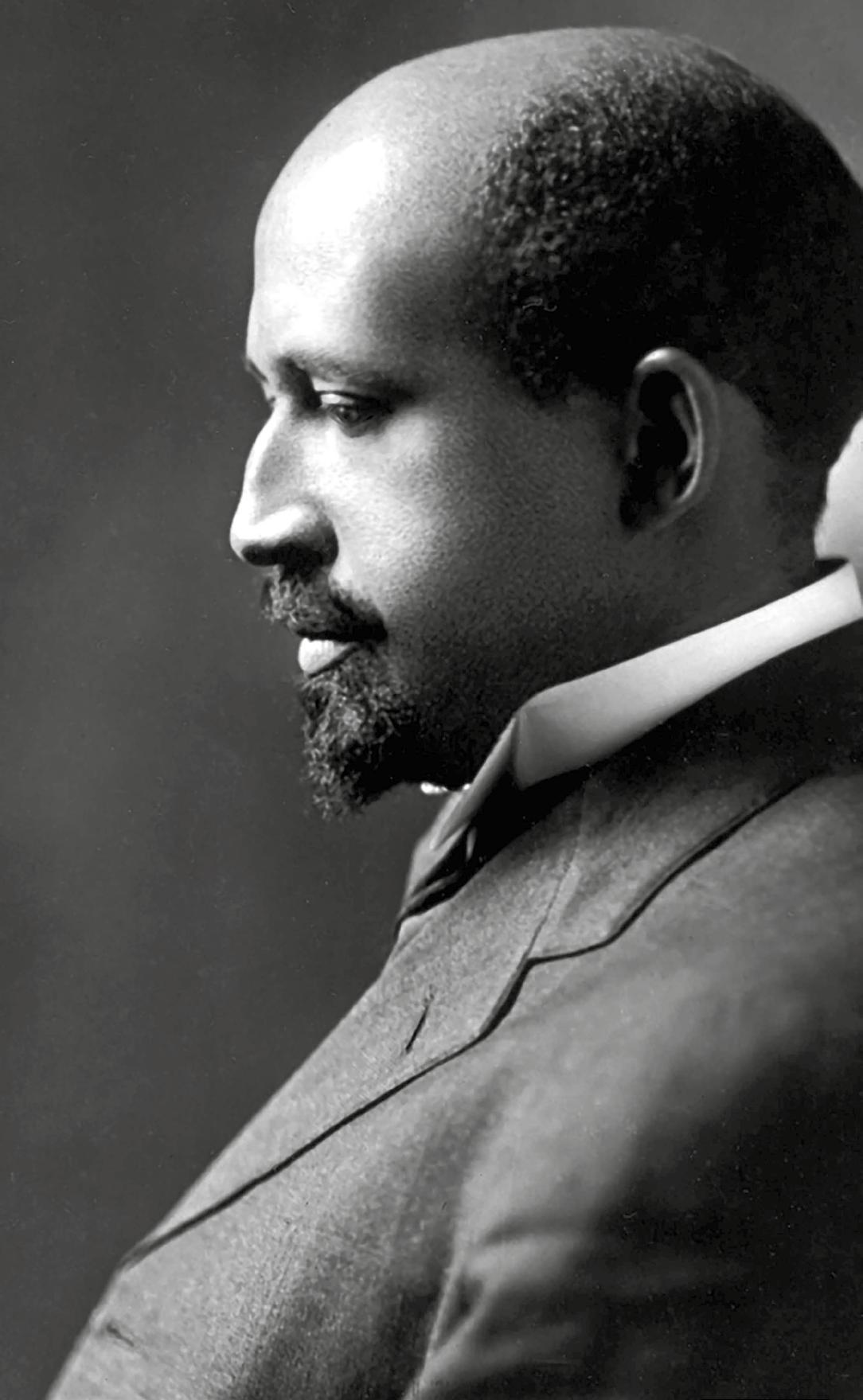
BLACK HISTORY MONTH 2022 25
The truth is that, whilst intellectual capital is in abundance across the African continent, publishers face financial challenges, especially in printing academic tomes. Even being within the African Union sphere, has not gotten The Encyclopaedia Africana Project's two ‘Biography’ volumes to the publication stage.
‘The Africa FactBook’ is partly facing the same fate. The encyclopedia is the brainchild of the Institute of African Knowledge (INSTAK) think-tank, and published by its sister organisation Book Of African Records (BAR) in association with the African Union Commission (AUC). BAR signed a Memorandum Of Understanding with the AUC in 2016 to produce the tome.
However, it probably would not have seen the light of day, had it not been for President Mnangagwa's personal interest in the project. He got the Zimbabwean government to fund the printing of a limited amount of physical copies in 2020. Dubbed the ‘Presidential Version’, although it has some 800 pages, it’s a cut-down version. The complete encyclopedia has 1,184 pages.
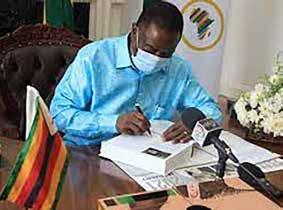
“At the moment we are short of funds to publish the full version of the book,” laments the encyclopedia’s editor Baffour Ankomah, a former editor of the Londonbased New African magazine. “We only published the shorter version last year. So any groups in the diaspora that can help with funding are welcome. The book has been at the printers in South Africa since early June 2021.”
In the meantime the ‘Presidential Version’ has been made available as a free download on the African Union website. It starts with a chapter entitled ‘Ancient Egypt, our roots!’, which asserts ancient Egypt an African civilisation. And rightly so, as European historians and heritage practitioners have sort to divorce it from Africa. For example, the Egyptian displays in the British Museum are in a separate location from that of the rest of Africa.
And with Elizabeth Taylor’s portrayal of Cleopatra of Egypt embedded in many people’s minds as a Caucasian, it’s no wonder a Harrow councillor at a councilfunded African History Month event I co-organised, said in all seriousness: “Next, you'll be telling me Egypt is in Africa!”
Chapters such as ‘The Moors, Africa’s Gift To Europe’ and ‘How Africa Developed Europe And America’, offer an African counter-balance to the prevalent Eurocentric portrayal of African history. It includes detailed profiles on all fifty-five African countries and much more.
There are pieces, such as the tongue in cheek titled ‘Has A Black Person Ever Invented Anything?’ The answer is of course yes, and several inventors of African heritage are listed. However, apart from a few unknown names to me, such as Dr Raphael E. Armattoe (1913–1953), a Ghanaian runner-up for the Nobel Prize in Physiology in 1948, who found the cure for the water-borne guinea-worm disease in the 1940s, I would hope the complete edition provides a more diverse list, including those of the 21st century. That said, this richly illustrated book is an absolutely useful resource for anyone interested in the history of the continent of Africa and its inhabitants.
I marked the last day of August with an event I organised called African History Reflection Day: The Global African People's Forum. It featured a video contribution by Prof Sir Hilary Beckles, the Vice Chancellor The University of the West Indies. In addition to explaining why the concept of pan-Africanism “has to step back”, he said that he no longer supported the concept of an African Diaspora. He’s now advocating for Global Africa, a unifying concept, which makes no distinction between, nor separates, the continent and its Diaspora.
His view has had an impact on the on-going work on the remainder of UNESCO’s ‘General History Of Africa’ series. Because hitherto, the eight volumes thus far published – these are freely available online and in a number of colonalist and African languages – have focused solely on African history located on the African continent. But now, space is being made to include African history of the Diaspora.
The history of the history of African encyclopedias continues. A statement from Prof Beckles’ office points out that: “He is a co-editor of Volume 9, a UNESCO ‘General History Of Africa’ which is called ‘Global Africa’. The volume looks at Africans wherever they are in the world throughout history. The editorial work has been completed and the manuscript is currently with UNESCO. It will hopefully be published soon.”
This shift redresses the defiency which meant that Africans outside of Africa were “no longer part of African history. You are now a part of British history. You're now a part of American history. You're part of Asian history, but you are no longer within the parameters of African history, because you have left the continent.”
So how did the ‘General History Of Africa’ series come about, what have been the challenges and what is the plan, going forward? UNESCO representative in Ghana Abdourahamane Diallo provided the answer at the 2022 African History Reflection Day meeting.
He said that it was the African countries upon joining UNESCO, after attaining ‘independence’ in the 1960s, that “asked UNESCO to help them re-write the story of Africa – that’s what they did.
“The eight volumes were ready in the ‘80s. But to what extent have these volumes been shared? They are not known in the fifty-five African countries, nor in the Global Africa or in the Diaspora. They are not known. They are still to be valorised.
“So UNESCO tried for more than 30 years now. With the member states, there have been lots of resolutions. Even at UNESCO level, but also the Africa Union resolutions with member states committing to include it in their curricula. But still so far we can count on one hand the countries that it's really journeyed in … so the road is still long for the sharing of available information, because it is that information which build the mind, which free the mind, because it's facts, it’s science, it’s not ideology.
“It's history – it’s there. But there’s still a big gap, and we at UNESCO are aware and recently, at the last General Conference of UNESCO, another resolution said that the ‘General History Of Africa’ will be a flagship priority programme for the next eight years to ensure that each member state really commits and puts it in their curricula. So it’s an ongoing battle.”
There has even been the formation of the UNESCO Coalition of Artists for the General History of Africa, which includes British trade poetess and trade unionist Zita Holbourne, in an effort to attract new and also young readers to the history resources, by using arts and culture.
Finally, there’s a much quoted African proverb, which says: “Until the story of the hunt is told by the lion, the tale of the hunt will always glorify the hunter.” However, it would seem like until Africans and African institutions fund the documenting of their history from a pan-Africanist lens, their stories will always be from the perspective of others.
26 BLACK HISTORY MONTH 2022
Zimbabwean President Emmerson Mnangagwa signs copies of a special edition of an encyclopedia
entitled ‘The
Africa FactBook’
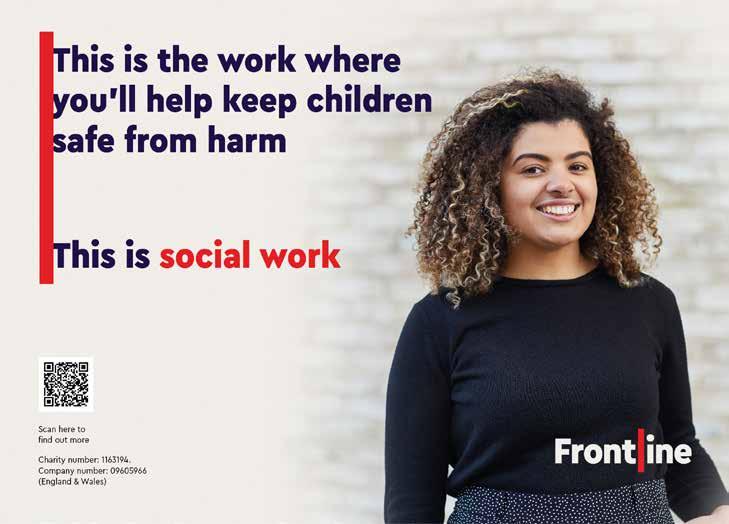



















BLACK HISTORY MONTH 2022 27 VictimSupport @VictimSupport www.victimsupport.org.uk Charity registration: 298028 ©Getty Images victimsupport_uk Leaders in Diversity Award We are proud to stand with you Whether it happened online or in person, recently or years ago, victims of crime can call our free confidential Supportline 24/7: 08 08 16 89 111 You can also access support from us via: My Support Space – an online resource providing a free, safe, secure and confidential space where you can choose how you want to be supported after crime. Registering for an account with My Support Space is quick and easy. Sign up at www.mysupportspace.org.uk/MoJ Live chat – a free, 24/7 service where you can chat to one of our trained supporters. www.victimsupport.org.uk/live-chat You don’t need to have reported a crime to the police to access our specialist support. P2791 Black History Month advert_188x135mm_2022.indd 1 20/05/2022 15:45
Taking a stand
BY COUNCILLOR SANCHIA ALASIA
Theevents of the last year with the pandemic having a disproportionate impact on BAME communities and the murder of George Floyd by American police officer Derek Chauvin, have proved another turning point across the world for race relations. Many Universities have had listening exercises and deep reflection on how they can use these conversations to take real action. The call for action is not a new one, but there has been a shift in the momentum to make real sustainable change in our universities particularly around closing the ethnicity pay gap and the racial awarding gaps for students. There has also been increased impetus to decolonise and make the curriculums that we teach in our universities more inclusive. Statues have been taken down, most notably that of slave trader Edward Colston in Bristol during a Black Lives Matter march, with calls that ‘Rhodes must fall’ at Oxford University. Debates have ensued about how society manages these statues and symbols of colonialism and imperialism going forward.
The UK’s colonial past permeates our nation today and Universities are not exempt. This can be seen as odds with the mission statements of most universities –which are generally to use the power of education to transform lives, communities, businesses, and society. It would be amiss for us not to acknowledge however that racist prejudices, opinions, and actions which are not in keeping with society’s commitment to equality for all, either then or now are a systemic part of our institutions today. As Universities we have a role in acknowledging and highlighting the dark parts of our past to reflect and build a better future. To achieve this, we will need to continually hear from the lived experiences of our staff and students, work together to identify the barriers and take pro-active steps to dismantle them.
The reality is that the lived experiences of BAME staff and students in our universities today show that there is still much to do to tackle systemic racism. There is an overwhelming amount of data from external reports over the years –including the Lammy Report, Angiolini Review, or the Parker Review, which
outline the inequalities that have now resulted in how BAME people are being disproportionately affected in society and which this pandemic and the murder of George Floyd have put a spotlight on. Not just with the higher death rate, but they have also been more likely to lose their jobs and are finding it harder to gain re-employment.
BAME people have to apply for 80 per cent more job roles to get a positive response. UK Black professional representation has been stagnant since 2014, with just 1.5 per cent in leadership positions. Reportedly, on average Black people are paid 23 per cent less than their white counterparts. The ethnicity pay gap remains, and, currently, it is not a legal requirement for employers to collate ethnicity data despite prominent members of the community pushing for it a few years ago. Black women are four times more likely to die from pregnancy or childbirth, that this information has been known for many years, but no concrete action plans have yet been put in place to address this. The list goes on, but despite this, BAME people keep going.
Many Universities for the most part have recognised that they need to do more to make their institutions a welcoming and inclusive place for their staff and students; alongside supporting the advancement of BAME people within.
The Diversifying Leadership will support early-career academics and professional services staff from BAME backgrounds to progress in leadership roles. By working with the participants to explore themes of power and influence, demystifying leadership, and cultural identity. By providing a safe space to learn from others and set fresh personal challenges, the
participants will have some tools to navigate their career aspirations through their institution. Institutions must play their part by alongside sending participants on this programme, working to make real sustainable change in eliminating institutional racism. Frameworks like the race equality charter can help institution’s identity where the pinch points are and what specific actions, they will need to take to tackle them. By examining specific measures that they can take to recruit, retain, promote, and support BAME staff and students, they ensure that when participants have completed the programme, they not only see but really feel their commitment to diversity, equality, and inclusion. Our universities must have a strong and enduring commitment to race equality and recognise the role they can play in dismantling the forces that perpetuate structural inequality and racial prejudice.
Sanchia Alasia is an award-winning specialist in equality diversity and human resource. She currently works at London Southbank University as their Head of Equality, Diversity and Inclusion.

28 BLACK HISTORY MONTH 2022
Diversity



LSBU Group celebrates Black History Month and celebrates being a diverse and vibrant community lsbu.ac.uk/about-us/mission-vision-values/equality-and-diversity We bring brilliant minds together to crack complex issues. Problems aren’t one-dimensional. By collaborating we can find the answers. This is what makes NTU a highly effective learning environment for our students and staff, characterised by fairness, equality of opportunity, and the valuing of diversity. www.ntu.ac.uk/bhm
creates brilliance. BLACK HISTORY MONTH 2022 29
Royal British Legion Stories of Service
The Royal British Legion is the UK’s leading Armed Forces charity. We provide practical, emotional, and financial support to both British and non-British serving and ex-serving British Armed Forces personnel all year round, every day of the week. Our support starts after one day of service and continues through life, long after service is over.
We are also the nation’s champion of Remembrance, striving to bring communities together, helping the nation unite across faiths, cultures and backgrounds to
remember the service and sacrifice of the Armed Forces community from Britain and the Commonwealth, honouring those who serve, and have served, to defend Britain’s democratic freedoms and way of life.
We have worked with Black History Month to explore service and sacrifice and devised online learning resources. Visit: blackhistorymonth.org.uk/royal-british-legion
On these pages we present a handful of inspiring stories of service, past and present.
Able Rate Alexandra Obonyo Royal Navy, 2019 – present
“I am a proud Black African, born and raised in Kenya. I initially came to the UK as a volunteer for the Scouts for a couple of years… I joined the Navy Logistics department, specifically the Writer trade, (HR Admin in the civilian world)… In 2020 I joined Project Kraken which is part of the Navy Digital transformation team. Within this, I do work involved with data collection and its analysis and exploration, which is one of the jobs you can do within the Writer trade, but more intuitive and tech involved.”
“Being part of the Royal Navy
Commonwealth group and a committee member of the Naval servicewomen’s network has exposed me to the most exciting activities and di erent perspectives. One of my proudest moments is when I got a chance to attend the Commonwealth Day in March 2019 at Westminster. I got to be around the Royal Family in addition to di erent people from all parts of the world and witnessing their diverse culture.”
Alexandra is now serving on the aircraft carrier HMS Elizabeth and is exploring how to commission through the ranks and become a Royal Naval O cer.
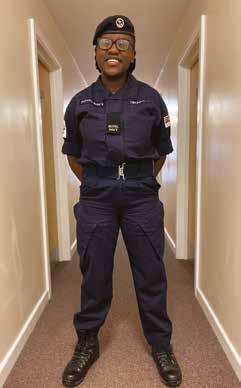
30 BLACK HISTORY MONTH 2022
W01 (RSM) Owen Bernard
Royal Army Medical Corps, 1969 – 1991
Owen came to the UK from Jamaica in the mid-1960s and joined the Royal Army Medical Corps. In April 1982 hostilities broke out in the Falkland Islands between the UK and Argentina. Owen, now a sergeant, was part of the advanced medical team and he recalls arriving at Fitzroy, East Falkland in the early hours of 8th June. “It was foggy, it started to clear and daylight started, and when we look up there were huge mountains and up there, all along the Argentinians were up there, they were observing…”
“Galahad came in and while we were there, everybody was unloading, back and forth, it was clear now, daylight. Suddenly… you could see these traces; you don’t realise it was the planes coming in strafing us. They come in to do a bombing run, we didn’t realise, oh my god! The Argentinians! And I tell you, you could literally see the pilot’s face, they were so low and it was a direct hit. A direct hit on Galahad. And Tristram got hit too. But on Galahad there was a huge explosion, and everyone who could was blasting these planes.”
“We had unloaded all our medical stu . So, we had something set up, basic stu . If it had been before that… it would have been a medical disaster. We had 135 casualties that day. Casualties with all sorts of horrific wounds. But let me tell you, this spirit of the British soldier, in this situation like that, everybody just rallies round and does what needs to be done.”
That morning, 59 men were killed instantly. The 135 casualties were brought to Owen’s medical centre by helicopter. “You don’t panic in situations, you panic afterwards. And this is where posttraumatic stress comes in… You cannot let emotions guide you in situations like that. People will die and your job is to save lives.”
For the fortieth anniversary of the Falklands War, in June this year, Owen joined fellow veterans at a commemorative event at the National Memorial Arboretum, Sta ordshire, and gave a moving address (photo above).

Flight Lieutenant Trevor Edwards
“I consider myself to have been a very ordinary London kid who was trained by the RAF to do very extraordinary things.”
“When you start on a frontline aeroplane, the first thing they teach you is how to fly it, how to get it in the air, how to land it. Flying it in bad weather, all the standard pilot stu , but that is a very quick part of the course. If you have got to that stage, you should be able to fly the plane. The trick comes in managing the systems. My aeroplane was a ground attack machine, so you had to be able to fire the guns accurately… We also had recce capability and air-to-air refuelling, so there’s all sort of skills you have to become competent at.”
Following the Gulf War (1990–1991), Trevor flew missions over the ‘no-fly’ zone in Iraq. He explains “it was to stop the Iraqis using their air force to bomb the civilians and so to have a measure of control over their army as well. …It did turn hot every so often.”
Trevor took part in NATO operations during the Bosnian War (1992–1995) and then became an instructor, teaching the next generation of pilots, before leaving the RAF to join British Airways.

RAF, 1985 – 1997
BLACK HISTORY MONTH 2022 31
Commonwealth Games 2022 A review of the opening ceremony in Birmingham

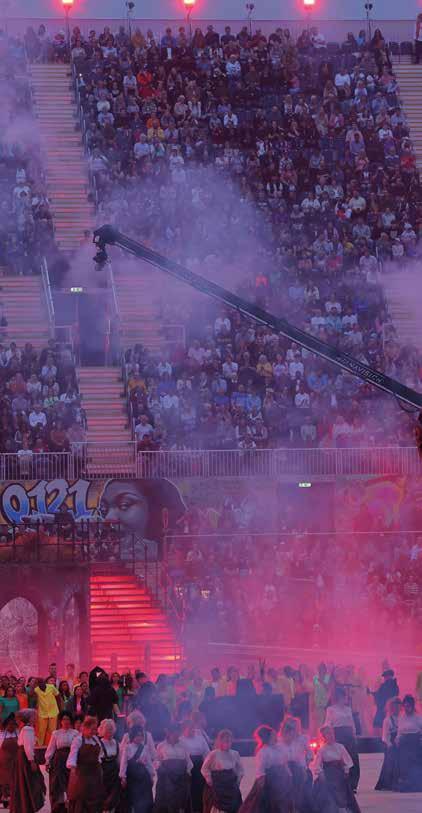
The Commonwealth Games 2022 took place across 15 venues in the West Midlands, with the track cycling at the Lee Valley Velodrome in London. Over 12 days from 28 July to 8 August, Birmingham welcomed 72 teams and around 6,500 athletes and officials; as part of the biggest sporting programme in Commonwealth Games history.
The Commonwealth is home to around two billion people, making up around a third of the global population and a wealth of diverse races, languages, beliefs, cultures, traditions and perspectives. In this review, we take a look back at how the opening ceremony represented Birmingham, and the diversity symbolised by the Games.
The opening ceremony held at Birmingham’s Alexander Stadium on 28 July was a theatrical triumph and a joyous celebration of the history and culture surrounding the UK’s second city. The event was fun, sincere and great family viewing, yet also surreal at times.
32 BLACK HISTORY MONTH 2022
The event included dramatisations of key periods in Birmingham’s history, including the city’s links to the slave trade; and the car industry – one of the earliest forms of employment for members of the Windrush Generation. It also focused on the cultural diversity of modern Birmingham - Britain’s most diverse city. African-Caribbean, Irish and South Asian communities were all involved in the opening ceremony, along with (mostly) brilliant ‘Brummie’ talent including comedians, actors, creatives, musicians and dancers.
The team behind the event was brought together by the Commonwealth Games Chief Creative Officer, Martin Green
CBE, who masterminded the London Olympic and Paralympic Games ceremonies in 2012.

The team was led by Executive Producer, Steven Knight CBE, the creator and writer of the hugely popular TV show, Peaky Blinders; with other members including Production Designer, Misty Buckley, recently nominated for a BAFTA Award for Stormzy’s performance at Glastonbury Festival; Artistic Director, Iqbal Khan, a globally renowned theatre director; novelist and short story writer, Maeve Clarke whose work incudes ‘Whispers in the Walls’, an anthology of new Black and Asian voices from Birmingham; music director, Joshua ‘RTKal’ Holness, an
international rapper and co-creator of a project offering music education and recording facilities to young people and underprivileged groups in the city; and BAFTA Award-winning Broadcast Director, Hamish Hamilton, who has directed and executive produced ceremonies, award shows and concerts worldwide.
Comedian and actor, Sir Lenny Henry, who was born and raised in Dudley by his Jamaican parents, carried the late Queen’s Baton on the eve of the opening ceremony, on the final leg of its journey. He said the experience: “fills me with massive, pride especially when I think of how far it’s travelled over the past nine months. It has crossed land, sea and air to cover every
BLACK HISTORY MONTH 2022 33
corner of the Commonwealth, including my parents’ home of Jamaica, and all the way to Birmingham City Centre (just down the road from Dudley where I got my first humungous break); and carried all the way by inspirational individuals whose stories have blown me away.”
Sir Lenny Henry also introduced the world to “The Great Nation of Dudley” as he kicked off the Commonwealth Games athletes’ parade in Birmingham, saying to the audience: “You are all fantastic by the way…all your little faces smiling at me; black, brown, pink, white, sunburnt from last week.”
Comedian Joe Lycett used humour to shine a light on the government’s muchcriticised approach to immigration, saying: “I’m going to do something now that the British government doesn’t always do, and welcome foreigners and welcome the region of Asia.”
Similar virtual messages of welcome, encouragement and support for the competitors came from other famous faces including Strictly Come Dancing judge, Motsi Mabuse; singer-songwriter Lenny Kravitz; and Sir Mo Farah CBE, the most successful British track athlete in modern Olympic Games history. As the athletes entered the arena, an on-screen Mo Farah told team England to ‘cherish’ the experience. “Go out there, be strong and do the best that you can and enjoy it,
because when the home crowd gets behind you it’s a massive boost.”
Sir Mo recently revealed in a BBC documentary that he was trafficked to the UK as a child and forced to work as a domestic servant. The programme has inspired others to reach out, with calls to trafficking charity, Unseen UK, rising by 20%. Sir Mo’s story also shows the difference one individual can make as an ally. Mo’s ally was his school PE teacher, Alan Watkinson, who recognised his athletic talent and contacted social services after Mo confided in him, helping him to be safely fostered by another Somali family.
Other inspirational moments in the opening ceremony included a speech by Nobel Peace Prize-laureate and activist, Malala Yousafzai, about the importance of education for girls. Pakistan-born Malala and her family have made Birmingham their home, after she was shot by Taliban terrorists in Pakistan for campaigning for girls’ education.
A 10-metre tall, mechanical ‘Raging Bull’, symbolising Birmingham’s iconic Bull Ring Shopping Centre, industrial past and links to the slave trade, was a leading feature of the event. It is now attracting crowds on display in Birmingham’s city centre. The official mascot of the games is also a bull; ‘Perry the Bull’ designed by 10 year old Emma from Greater Manchester,
as part of a national competition.
The Bull Ring Centre’s outdoor market became a go-to place for the Windrush Generation in Birmingham and around the East Midlands in the early 1960s, as at last people could buy foods they would have enjoyed back in the Caribbean, including dried beans and saltfish.
Not far from the Bull Ring Centre is Jamaica Row – which has featured on street plans of the city since the 18th century. The street was part of Birmingham’s market area and the name is thought to show the city’s links to the slave trade. Fruits such as bananas were imported from plantations in the Caribbean, with crops planted and harvested by the enslaved. As well as shops and houses, Jamaica Row was home to a pub called The Black Boy, named after King Charles II, who was dark-skinned and called ‘my Black boy’ by his mother. A sheltered vegetable market opened in Jamaica Row in 1884, and today the historic street known as ‘old Jamaica Row’ is still home to Birmingham’s Open Market, with 130 stalls selling fruit, vegetables and more.
As the Commonwealth Games opening ceremony showed, Birmingham is a unique city full of great stories and vibrant history, made richer by the diversity of its inhabitants.

34 BLACK HISTORY MONTH 2022
Every child deserves a safe and loving home
There are thousands of children in the UK currently waiting to be placed with foster carers or adoptive families. We aim to help as many of them as possible.
Barnardo’s believes in children regardless of their circumstances, gender, race, disability, or behaviour. Our purpose as a charity today is to transform the lives of the UK’s most vulnerable children. We will support them, stand up for them and bring out the best in each and every child. We do this because we believe that every child deserves the best start in life and the chance to fulfil their potential.

In many areas of the UK there is a shortage of foster carers and adoptive parents with the same cultural or ethnic background as the children coming into care.
Black and minority ethnic children who are looked after can be further disadvantaged if their own cultural background is not promoted and nurtured. We believe all children have a right to enjoy their own culture,
practice their own religion and speak their own language. Here at Barnardo’s, we provide a service that recognises and values cultural and religious diversity during every stage of the process and beyond.
We are looking for loving, supportive individuals and families who are passionate about making a difference. If this is you, find out more about fostering and adopting with Barnardo’s today.

Search Barnardo’s fostering and adoption

BLACK HISTORY MONTH 2022 35
Chris Blackwell
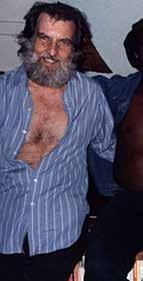
The man who gave an island’s music to the world BY KWAKU
There are few people in the music industry who can say that they’ve been there, seen it and done it all to the same degree as UK-born, Jamaicaraised Chris Blackwell.

Even though lots have been written about him and the Island music empire he co-founded in Jamaica in 1959 – that’s 63 years ago – there’s much new information, particularly intimate, personal stories, to be found in his recently published memoir ‘The Islander: My Life In Music And Beyond’ (Nine Eight Books).
Perhaps of all the interviews I’ve conducted, interviewing this 85 year old music industry veteran was simply the one that I most eagerly awaited. That’s simply because he’s such an amazing industry game changer, for whom “I’ve been there, seen it and done it all” won’t be merely boasting.
Before the interview starts, on introducing myself, Blackwell reminds me of ‘Reebop’ Kwaku Baah, the Ghanaian percussionist of the rock group Traffic. Blackwell co-produced his 1972 ‘Beebop’ album.
Blackwell kicks off his book by describing himself thus: “I am a member of the Lucky Sperm Club. I was born into wealth and position, albeit of a particularly mixed sort endemic to Jamaica. I am Jamaican, but I am also English, Irish, Portuguese, Spanish, Jewish, and Catholic.”
There’s no doubt that this mixture and privilege has held him in good stead. Here’s a man, who in no small way facilitated the rise of several acts across different genres, who we know so well –Millie (ska), Steve Windwood/Spencer Davis Group (R&B), Sparks (idiosyncratic pop), Grace Jones (reggae/dance fusion), Frankie Goes To Hollywood (pop/rock), Aswad (reggae), Hi-Tension (Brit-funk), Kid Creole And The Coconuts (disco) and U2 (rock).
But as big as rock gods U2 may be, the biggest star that Blackwell and Island ever created was Bob Marley (And The Wailers). It’s to be expected that wherever reggae is known in the world, Marley’s songs are bound to be a staple.
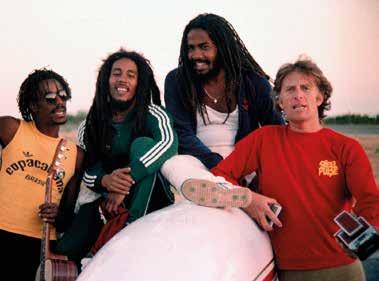
36 BLACK HISTORY MONTH 2022
Phone the Jamaican high commission in London. If you’re put on hold, the music you hear is Marley’s. Even in Ghana, where I’m writing this article, I’ve seen the Roman Catholic Church Archbishop Charles Palmer-Buckle and the erudite “media personality” Kwasi Kyei Darkwa, popularly known as KKD, resort to singing a Marley song to underscore a point during a TV interview!
In other words, the fame and money, particularly following the death of Marley in 1981, is enough to assure Blackwell’s place in the annals of pop and black music history.
Although he’s done more than to give Marley and reggae music to the world, he’s not reticent about what he considers failures. He talks about one such failure. The success of the 1972 released ‘The Harder They Come’ soundtrack and the film, which he backed financially, helped to popularise reggae globally, particularly among European audiences around the world. A decade later, he tried to do the same with go-go music.
Having discovered the highly percussive music genre in the early 1980s, his record company signed some of the genre’s leading exponents, such as Trouble Funk.
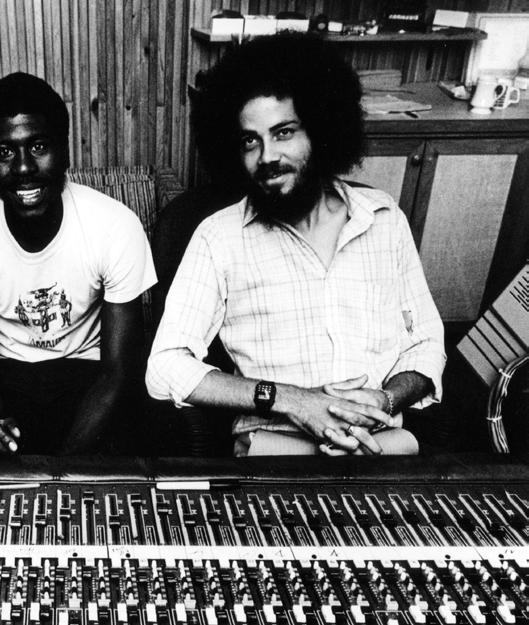
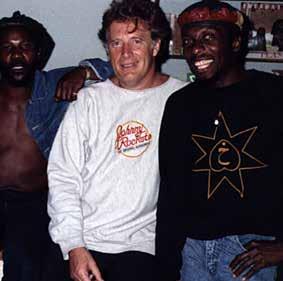
In an attempt to break go-go outside of its strong Washington DC home base, Blackwell then bank-rolled the commercial failure that was ‘Good To Go’, a 1986 released thriller film with a Washington DC go-go music scene background. It was re-titled ‘Short Fuse’ when released on video.
“
I decided to do a movie, and try and do what happened with ‘The Harder They Come’. Unfortunately, the movie was not very good,” recalls Blackwell of his ill-fated attempt to break go-go music globally.
He admits to making a “mess of it” when his co-executive producer Jeremy Thomas had to leave to go produce ‘The Last Emperor’, which won the 1988 Academy Award for Best Picture. Putting more money into trying to salvage the go-go music film bled Blackwell so badly, that he eventually sold Island Records in 1989!
We can now look at his ascendancy. Blackwell was at the start of the emergence of the music industry in Jamaica in the mid-to-late 1950s. Firstly, he operated jukeboxes across the island. When soundsytem men such as Coxsone Dodd and Duke Reid began to run the industry, although Blackwell never operated a soundsystem, he would bring records from the US to sell to the soundsystem operators. Scratching the credits off the labels meant he could charge a lot for “exclusive records”.
However like Dodd and Reid, Blackwell moved into record production and running a record company. Although he had some success locally with his releases of jazz, blues and mento, it was his relocation to London just before Jamaica’s ‘independence’ in 1962, which led to him eventually breaking Island Records and Jamaican music globally.
From operating from his London flat and selling records from the boot of his car, he set up an office at 108 Cambridge Road. This house in Kilburn, north-west London was owned by Lee Gopthal, a Jamaican indian accountant, who eventually went into business with Blackwell as partners in the 1968 relaunched Trojan record company, which became arguably the biggest reggae company in the world, right up its crash in 1975.
Blackwell is well known for not being phased by the dreadlocked Rastafarian musicians he dealt with. This stems partly from the hospitality he experienced from
BLACK HISTORY MONTH 2022 37
Clockwise from top left: L-R Junior Marvin, Bob Marley, Jacob Miller and Chris Blackwell; L-R Perry Henzell, Toots Hibbert, Chris Blackwell and Jimmy Cliff; L-R Chris Blackwell, unidentified, and Compass Point engineer Steven Stanley (right).
some Rastafarians who rescued him, after he had walked for hours looking for help. He landed on a remote part of Port Royal the night before, when his boat run out of fuel.
Also, a number of Jamaicans played some part in Blackwell’s success in London. It was Sonny Roberts, who operated the Planetone record label and recording studio in Gopthal’s property, who introduced his landlord to Blackwell, thus planting the seed which led to the London borough of Brent becoming the capital of reggae in Britain.
Blackwell caused jazz guitarist Ernest Ranglin to come to London. He famously arranged ‘My Boy Lollipop’, the ska hit which reached number two in both the UK and US pop charts in 1964. The singer, Millie, was a teenager whom Blackwell took guardianship of in order to get her out of Jamaica.
That record’s b-side was written by singer-songwriter Tony Washington. Although Washington had come to London independent of Blackwell, he like Millie, spent some time living in Blackwell’s flat. Blackwell’s face lights up when I inform him that Washington’s still around.
“I really liked him a lot,” he beams, before proceeding to tell me a story about how he was helping Washington get a flat. He laughs when he recalls Washington’s answer when he asked him how the flat-hunting was going. Washington’s answer was: “Flat.”
Jackie Edwards, was another Jamaican singer-songwriter whom Blackwell brought over to London, and who for a time was also a “lodger” at Blackwell’s flat. He even used to help distribute some of
Island’s releases, including his own.
However, Edwards contributed in a more significant way by writing The Spencer Davis Group’s Blackwell-produced ‘Keep On Running’ and ‘Somebody Help Me’, UK which were chart-topping singles in 1965 and 1966 respectively.

Although Blackwell had been involved in selling Jamaican music by licensing records from various producers in Jamaica on his Island record label and also through his partnerhip in Trojan, it was the aforementioned crossover successes, coupled with his move into the then emerging British rock scene, which allowed Island to crossover Jimmy Cliff, and particularly Bob Marley & The Wailers, along with a host of others, like Toots And The Maytals, Black Uhuru, Hi-Tension and Aswad (RIP Angus ‘Drummie’ Gaye, who died on 2 September).
In the early 1970s, well before Marley was signed to Island, Cliff had had some success on the Island label, like the UK top 10 ‘Wild World’ (I’d assumed ‘You Can Get It If You Really Want’ had been a crossover hit, until I wrote this article). ‘The Harder They Come’ film and title track cemented his fame. Blackwell describes in some detail in his memoir why their business relationship did not endure.
“He was somebody who had great songwriting ability,” recalls Blackwell, who first released Cliff’s Leslie Kong-produced records in Britain, before guiding Cliff’s career when he left Jamaica to settle in London in the 1960s.
“Look at the songs he’s written. So I think, I’d say honestly Jimmy Cliff is right up there with Bob, I really do. An amazing thing is this – Jimmy Cliff took Bob to Leslie
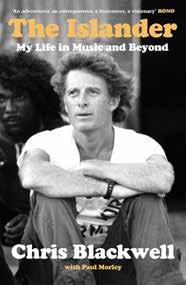
Kong, the Chinese guy who ran a record shop (which turned into a record company) in Jamaica. Jimmy Cliff, you could almost say, or somebody could claim that he ‘discovered’ Bob. He took Bob to Leslie Kong, where he (Jimmy) had already made a record, because I was partners with Leslie Kong in Jamaica.”
When I ask Blackwell what does he think of being described as the man who made reggae a global pop music genre, he answers in somewhat embrassed tones:
“I would never make a claim like that, because it is grew from the work and the talent of all the people who wrote the songs, recorded the songs, promoted them.” he says.
“There’s lots of people. I mean, you know, especially in Jamaica itself. You know, Coxsone, Duke Reid, all the guys they started like that and they had these big sound system boxes. Now that didn’t transfer up to England.”
Well, who can say where reggae and Jamaican popular music might have been, had Blackwell not moved his Island operations to the bigger island, known as Britain.
At the start of our interview, I told Blackwell that I seem to have read somewhere that he used some office in central London during the early days – not the Rutland Gate Mews flat nor the Oxford Street offices. It was possibly in or around Portland Square, I believe. He made a valiant effort to recall. But even though he was most generous with his time, he had not remembered this address at the end of the interview. So if you know the address, this anorak would be interested to hear from you.
38 BLACK HISTORY MONTH 2022
Kwaku is a historical musicologist and the International Reggae Day UK convener.
Black History Month is soon approaching and South Yorkshire





looking forward to having an Uplifting Event in honour
those

Men and Women who have contributed to the very fabrics of our
Society.
A time to reflect on the great achievements of those in our communities who have work tirelessly and creatively to achieve their potential. Some of who have had to push through the struggles and climb obstacles in order to succeed. All who left us a model to follow and Inspired generation after generation. A celebration of our historic heroes and modern day heroes.
time for all of us to come together to learn lessons
that positive changes can be made for the present
future.
With more than 11 million national records within our care, Black History Month 2022 is a vital reminder of our commitment to increasing the use and experience of our collections for more people. Our collections span 1,000 years of difference, debate and progress. Created from the perspective of state and empire, we hold important records that bear witness to past injustice, and the long and continued fight for racial equality. We are proud to play our part in finding greater ways to make these

Archives are
for everyone
because they are
about
everyone –past, present and future
significant records more accessible. Find our Black British history resources at nationalarchives.gov.uk/black-history Black Power demonstration and march, Notting Hill, 1970catalogue reference MEPO 31/21 Setting
the
bar
high,
removing barriers, promoting excellence. We recognise and value the importance of building an inclusive culture and environment where our whole University community feel they belong, are treated with respect and are supported to reach their full potential. Learn about our work and progress on race equality and opportunities at the University: sheffield.ac.uk/inclusion/race SOUTH YORKSHIRE POLICE TASTING A SLICE OF BLACK HISTORY OCTOBER 2022
Police are
of
Black
British
A
from the past so
and
Email: Race_Inclusion_Equity@southyorks.pnn.police.uk BLACK HISTORY MONTH 2022 39
What does it mean to be black in the 21st century?
To be black means to devour greasy fried chicken, to be loud and love to party.
That is the first thing that comes to most people’s minds when they think of a black person.
Hundreds of years of pain, suffering and heritage limited to just 28 short days of the year all in the name of inclusion and diversity. Learning about my people once every blue moon like I’m not Black every second.
We’re taught that it was Thomas Edison who made the light switch when it was a darker man who made that light flick.
I was 9 years old when I realised my life would be different to most. Sometimes I feel the melanin in my skin is like a lethal dose, making me a target to those who don’t look like me. Knowing I have to work twice as hard as the people I know I’m better than ‘cause I need to do double what they do so I can level them.
The only time you’ll see thousands of white people cheering for the black kid to win is in a stadium.
The loud thud of my heart when I hear a police siren because I’m scared, I’ll become a statistic. One in every thousand black men is killed due to police brutality.
Those are the odds we’ve been given to beat.
It’s “I’m not racist because I don’t use the N-word,” but when you see a black man on the train you clutch your purse just a little bit tighter because we strike fear into your hearts. But the same situation is ok for a white boy. For example, a black man without a criminal record is less likely to get a job than a white felon or maybe it’s because we’re lazy? And we don’t work hard enough but 400 years in the same field, literally is an incredible resume.
A classmate once told me when I was speaking on slavery that the past is in the past that I should just let it go.
Yeah right. This isn’t Frozen and my name isn’t Elsa, we can’t just freeze and forget all that happened.
This isn’t a movie; my life isn’t a hashtag that happens once a year.
The only thing you should be letting go of is that gun you have aimed at my face because you believe I’m armed. That is my reality.
Oh, I’m making you uncomfortable. I’m sorry, try a cramped slave ship. 12.5 million Africans transported to the Americas like an amazon parcel to work for the white man. Out of that number only 10.7 million disembarked alive.
Let me put that into perspective for you. That is 125 percent of the population of London being forced into a backbreaking life without the liberty of choice.
Being paraded around like a zoo animal because of the melanin in my skin.
Now tell me, are you still feeling uncomfortable?
But it’s fine I guess, because slavery’s over now, right?
By Jebril Um0
40 BLACK HISTORY MONTH 2022
CHANGE … TIME FOR
He described his early years in the UK as a “dog’s life”, due to the difficulty in finding employment and housing.
“Housing was the biggest problem, because they was strictly against us,” Roy had previously told the Guardian.
Roy Hackett MBE
Thecivil rights activist Roy Hackett, who was one of the lead organisers of the Bristol bus boycott, has died at the age of 93 in August.
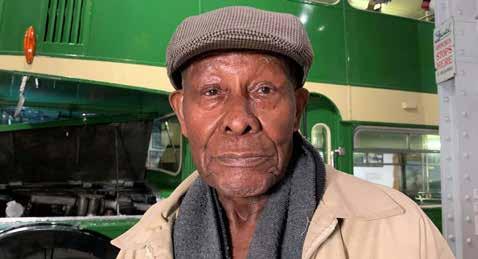
The 1963 campaign, which lasted four months, mobilised people across the city to stop using Bristol Omnibus Company buses because of its refusal to hire black and Asian people. At the time, a “colour bar” in Britain meant that people from minority ethnic backgrounds could legally
be banned from housing, employment and public places.
The protests that followed not only forced the company to change its policies, but paved the way in passing the Race Relations Act of 1965 and 1968. Roy was appointed an MBE in 2020.
Roy, who once said he was “born an activist”, grew up in Trench Town in Kingston, Jamaica. He moved to Britain in 1952, living in Liverpool, London and Wolverhampton, before settling in Bristol.
Roy helped organise the bus boycott alongside Owen Henry, Audley Evans, Prince Brown and Paul Stephenson. Partly inspired by the US civil rights movement, and the successful bus boycott in Montgomery, Alabama, in which Rosa Parks refused to give up her seat, the group marshalled the city’s 3,000-strong Caribbean community into action.
The boycott, which campaigners announced at a press conference on 29 April 1963, is thought to be the first of its kind in Britain.
Roy went on to co-found the Commonwealth Coordinated Committee, which set up Bristol’s St Pauls Carnival in 1968. The group’s campaigns applied pressure on the local council to act on housing and employment. The committee still runs today as the Bristol West Indian Parents and Friends Association.
In 1959, Roy married his childhood sweetheart Ena, who arrived in Bristol in 1958. He leaves behind three children.
As one of the top film schools in the world, we want to effect meaningful change in the film, television and games industries by ensuring The National Film and Television School reflects the full diversity of our country through our staff and student body.
We strive for systemic change that allows people from all backgrounds to tell their stories and the stories from their communities.
Find out more about our world leading training for film, television and games at nfts.co.uk

Generous scholarships and bursaries are available.

BLACK HISTORY MONTH 2022 41
(19 September 1928–3 August 2022)
Where is Black Africanlife in London?
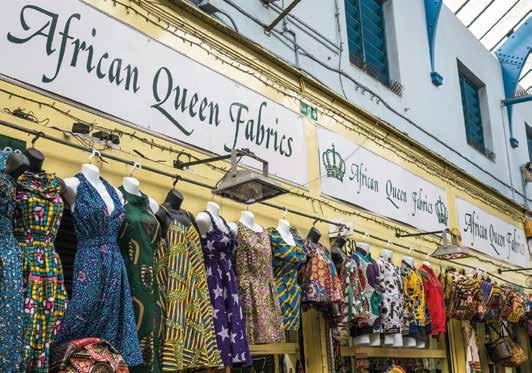
If
you know the modern city, then you will know that it is at once everywhere and nowhere; both an undeniable fact of the landscape and something unlikely to be set down on an Underground map or marked by official signage. Head north and you can find it in the strip-lit glare of tutoring businesses on Tottenham High Road, or out in Hayes, heralded by green Dahabshiil signs advertising money transfer to Somalia. In the south, it is the woman clicking her way to a Thamesmead community hall, in party heels and sparkling Nigerian native wear. Or the Brixton Street preacher, imploring an ambivalent passing crowd to repent through a speaker intended for karaoke. Black African presence can be glimpsed in the whir of seamstresses at work in tiny doorway operations off Dalston’s Ridley Road Market, smelled in the spice- prickled puff of barbecued croaker fish drifting on the Old Kent Road air and heard in the eavesdropped snippets of Nigerian Yoruba, Ghanaian Twi, Ugandan-accented, Swahili and Sierra Leonean Krio ricocheting on the street. Once, this life would have been tucked away and out of sight. Hidden in the form of private card games among turn-of-the-century Somali seamen, interwar hostels established for West African students and prayer meetings in the council flat front rooms of the 1970s. But now, it spills out and bursts forth. Now, this African London is kinetic and ever-
expanding, stretching out and beyond the city’s hazy border like something that cannot be wholly contained. Not just as people but as architecture. As listed former cinemas, bingo halls, pubs and banks that now bear the names of newly planted Pentecostal churches and stand as looming monuments to a quiet sort of urban conquest. Yes, if you know the city then you will know that modern Black African presence is an inescapable reality, strewn in every corner. But look for scholarship, exploration or historical record of this life and things become a little less clear. History books about Black British settlement – whether they are the scattering of publications released throughout the latter half of the twentieth century or the swelling post-2010s wave that coincided with a broader period of reappraisal and re-education with regard to race – tend to focus on modern Africans as a subcategory of a larger Black whole; one thread woven into a predominantly Caribbean social tapestry.
The second great wave
In fact, Black UK residents directly drawn from Africa have only existed in an official sense for just over 30 years. Until the 1991 census introduced ‘Black African’ as an option on its identity menu, we were not considered worthy of specific categorization. One reason for this is the simple fact of numbers: Black Africans, at that particular point in British history, did
By Jimi Famurewa
not have the same immigrant population size or cultural presence as AfroCaribbeans. But another is that – given the nascent Black British community was generally forged in the fires of a hostile, structurally racist post-war society –political solidarity was more important than quibbling over the specific source of your Blackness. It is only in the last 40 years that ‘Black’, both as a term and a political idea, has fully ceased to apply to South Asian Brits. The thinking that created this glomming together of ethnicities is obvious enough: in the face of landlords, employers and police whose bigotry didn’t specify, a certain monolithic solidarity was vital.
But I think this phenomenon as it applies to Black Africans – namely, the surprising absence of modern Africans in many of the official chronicles of Black British life – is a by-product of something else: the wider collective attempt to move the conversation about Black settlement and presence in the UK away from the symbolic enormity of the Empire Windrush. Because, of course, beyond its status as the undoubted creation myth of Black life in the UK, this ship’s 1948 arrival was the continuation rather than the beginning of Britain’s Black immigrant narrative.
Peter Fryer’s seminal 1984 book Staying Power opens with the arresting statement that ‘There were Africans in Britain before the English came here’. The fact is that whether it was the North African soldiers who established a third-century Roman settlement near Hadrian’s Wall, the African merchants who were fixtures in Georgian London, or the Black political agitators and intellectuals who turned the metropole into their home, pulpit and playground in the 1930s, Blackness in Britain has a history and a lineage beyond the mythic midcentury arrivals that followed 1948’s British Nationality Act.
Fryer and the other historians who have stood on his shoulders – not just Staying Power but the likes of Black Tudors by Miranda Kauffman, Black Poppies by Stephen Bourne and, perhaps most impactfully, Black and British by David Olusoga – have given us an important rebuke to the postcolonial view that Black Britons are recent arrivals with no
42 BLACK HISTORY MONTH 2022
significant claim on the land. Or that they are interlopers who can simply be told to go back where they came from. ‘We are here, because you were there,’ as the British-Sri Lankan novelist A. Sivanandan put it, with enviable economy.
Yet, to my mind, this noble effort to excavate the pre-Windrush history of Black Britishness has, however inadvertently, somewhat diminished the attention paid to more recent stories. In looking further back, we perhaps miss the social shifts happening right under our noses. This is not to suggest that significant moments from the last 50 years of Black history in this country – from the trial of the Mangrove Nine and the tragic death of

Stephen Lawrence to the Covid-masked social uprising of 2020 – have gone unexamined. It is rather that the breadth of Black experience, and the increasingly dominant presence of Black Africans, hasn’t always been reflected in how we look at race and Britishness today. Even Olusoga himself, right near the close of Black and British, acknowledges this point – that there has been a shift in the demography of Britain’s Black population that has not been fully recognized. The Black Africans who have come to Britain since the 1980s are, in Olusoga’s words, part of ‘a second great wave of Black migration … that has largely gone unnoticed’.
Settlers: Journeys through the Food, Faith and Culture of Black African London by Jimi Famurewa is published by Bloomsbury Continuum on 13 October at £18.99. Use code SETTLERS20 for 20% discount.


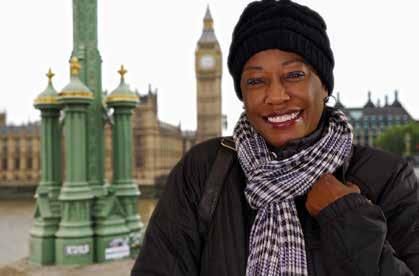
BLACK HISTORY MONTH 2022 43
The Actions of Ona
Suzette D. Harrison
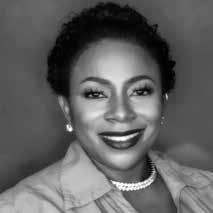
Today I received an email from my publisher asking if I’d be interested in writing an article for Black History Month. My initial response was a soft sigh, and thoughts of the energy the task would require. Not to mention, the creativity of thought. I’m a writer. This is my passion, (part-time) profession, and God given purpose. I just recently finished a 332 page novel to be released 6 September. Passion aside, writing can be exhausting. Right now, my mind is on hiatus. Writing an article seemed laborious. But then I clicked on the link my publisher provided and visited BHM.
Beautiful pictures dominated the screen, pictures of people who share my brown skin. A soft smile kissed my lips as I began to scroll the homepage content. The first words my eyes latched onto were the ones quoted above where the editor declared her intent to move people from words to action. That made me stop and think about the protagonist of my upcoming novel: Ona Judge.
For those who aren’t familiar with her, Ona Judge isn’t a fictional character. She was a “real” woman. Born in June 1774, she lived on Mount Vernon as the enslaved property of the Martha Washington. As in the wife of George Washington, the United States’ first president! While my nation’s founding fathers were fighting for freedom from British dominance and penning such indelible words as “all men were created equal” publicly; privately, many held others in bondage under the cruelty of human slavery. Yes, even George and Martha Washington.
When I first learned of Ona Judge’s existence, I was fascinated. By her life. Her experiences. Her great escape from Mount Vernon – a place owned by the nation’s most powerful person.
Miss Ona was the daughter of Betty Davis, the plantation’s seamstress, and Andrew Judge, an English tailor and indentured servant. It’s unknown if the relationship between her parents was consensual or not, but Ona was the
product. She was a young girl when her work about Mount Vernon transitioned from serving in the nursery, fetching water or gathering kindling to that of being a lady’s maid for the plantation’s mistress. Living in the “big house” brought her into close proximity and constant contact with the Washingtons, persons who held her in bondage and logged her name in ledgers, as they did livestock or other inanimate objects. But somewhere in Ona’s psyche existed the truth of her value, that she was more than a commodity. Clearly, some place in her soul intuited its worth, that she deserved to be free. Her daring actions prove that she believed in her inalienable right to be more than another person’s property.
when Ona Judge put her convictions into action. As the Washingtons ate dinner at the presidential home in Philadelphia Pennsylvania, Ona slipped away. She escaped into the night, becoming a “fugitive slave.” With the aid of others she’d befriended in Philadelphia’s Free Black community, she sailed away aboard the Nancy to Portsmouth, New Hampshire.
Martha Washington was distraught, the President was livid upon discovering Ona’s “great deceit,” and had notices of her absconding published in newspapers, as well as posted about the city. A ten-dollar reward was placed on Ona’s head. Agents acting on behalf of George Washington managed to locate her, and attempted to persuade her to return. Ona refused. She knew her worth. She chose to be free, even when freedom meant an impoverished, uncertain living. She employed her skills as a seamstress, a domestic, showing her willingness to be self-sufficient. She lived without the comforts of presidential royalty in exchange for liberty.
Ona Maria Judge married a sailor, Jack Staines, and bore three children with him. She suffered loss, and loneliness. Her husband (only after six years of marriage) and two of her three children preceded her in death. Yet, when interviewed by two different sources in her eighties, we gather that she never regretted the free life she lived or her decision to boldly escape bondage.
These interviews are rare treasures in which a formerly enslaved person’s words are captured for our enlightenment and awareness. They’re priceless, allowing us to hear Ms. Ona’s experiences directly from the source, not another conduit. For me, these interviews were an invitation into her sacred space, an opportunity for sitting, hearing, and learning. Admiring. Reverencing. How this woman at the age of twenty-two managed such a great escape from the nation’s most powerful persons – for me – is breathtaking. I sit in awe and honor her name. Ona Maria Judge Staines.
Grab a copy of My Name is Ona Judge and immerse yourself in the life of this fascinating young woman!
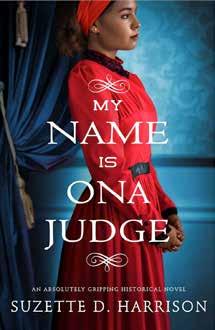
44 BLACK HISTORY MONTH 2022
It was a spring night, 21 May 1796,
The late James Berry To Travel This Ship
The Late, James Berry, OBE, Jamaican poet settled in Britain in 1948, in the first post-war wave of Jamaican emigration, later becoming one of the first Black writers in Britain to achieve wider recognition. In his poem To Travel This Ship he recreates the journey aboard the SS Empire Windrush.


The arrival of the SS Empire Windrush in June 1948 at Tilbury Dock marked the beginning of post-war mass migration. The ship made an 8,000 mile journey from the Caribbean to London with 492 passengers on board from Jamaica, Trinidad and Tobago and other islands.
He died in London on 20 June 2017 after suffering from Alzheimer’s disease.
To Travel this Ship
To travel this ship, man
I gladly strip mi name of a one-cow, two-goat an a boar pig an sell the land piece mi father lef to be on this ship and to be a debtor.
Man, jus fa diffrun days
I woulda sell, borrow or thief jus fa diffrun sunrise an sundown in annodda place wid odda ways.
To travel this ship, man
I woulda hurt, I woulda cheat or lie, I strip mi yard, mi friend and cousin-them To get this yah ship ride. Man – I woulda sell mi modda Jus hopin to buy her back. Down in dat hole I was I see this lickle luck, man, I see this lickle light.
Man, Jamaica is a place
Where generations them start out Havin notn, earnin notn, And – dead – leavin notn. I did wake up every mornin and find notn change. Children them shame to go to school barefoot. Only a penny to buy lunch.
Man, I have follow this lickle light for change. I a-follow it, man!
Heritage is for everyone, and so are jobs in the heritage sector.
At Historic England, we’re always looking for new ways to promote England’s historic environment; from local landmarks to hidden histories. We recruit all year round across a broad range of roles.
Find out more at HistoricEngland.org.uk/careers
BLACK HISTORY MONTH 2022 45
Slavery & the Bank exhibition at the Bank of England Museum
The
exhibition in the Bank of England itself explores the history of transatlantic slavery through its connections with the Bank of England and the wider City of London. Founded in 1694, the Bank of England was a private bank that provided financial services to individuals, other companies and the Government. Many City merchants and financiers would invest profits from riskier trade ventures into Bank of England stock, which was a safer investment. A significant enough investment in Bank stock qualified the holder for election as a Director or Governor. As a result, these offices were held by wealthy and successful businessmen.
The exhibition acknowledges that the Bank of England was founded and came to prominence at a time when London was becoming the centre of a global empire, and Britain was at the forefront of the transatlantic slave trade. For over 300 years, the slave trade tore more than 12 million African people from their homes and families in Africa. Several of the Bank’s founding figures were involved in the trading of enslaved Africans to the Caribbean and America –some directly, and many with commercial interests in slavery, banking and finance businesses.
The exhibition reflects on how the wealth created through transatlantic slavery shaped the development of Britain and tells the bank’s own story of some of the different ways it had a connection with the trade. It’s a complex tale and the institution has attempted to present a clear picture of the extent of these historical connections.
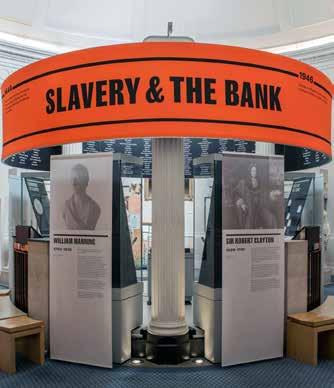
The work behind the exhibition gained momentum in early 2020 when a small number of colleagues in the Bank of England Ethnic Minority Network began an internal project to highlight the Bank’s links to transatlantic slavery. The Black Lives Matter protests of 2020 then showed unmistakably the public desire for institutions to be open about their history and connections with slavery and colonialism. As public attention turned to the question of who we
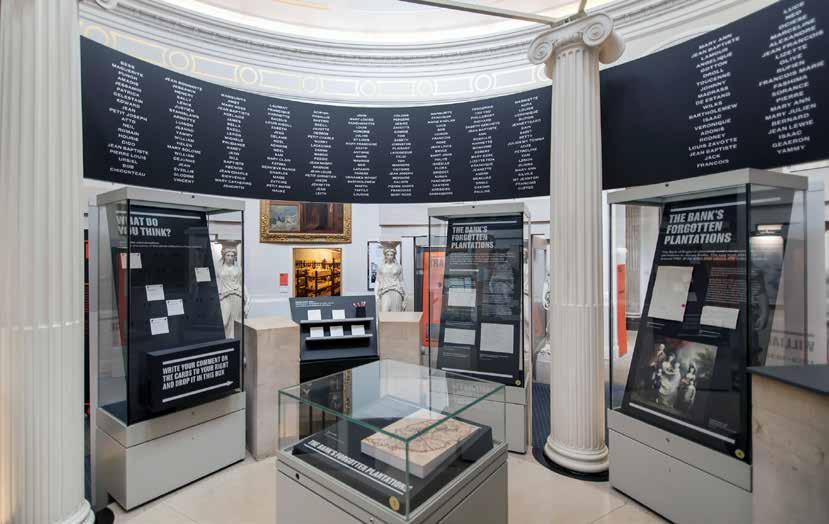
46 BLACK HISTORY MONTH 2022
commemorate in our public spaces, the bank began to look more closely at the figures on their own walls.
The resulting exhibition examines the different ways that individuals were involved, from owning plantations to trading in products produced by enslaved people. It also looks at the Bank’s place in the wider financial system at a time where enslavement was considered a legitimate trade, to the extent that people were treated as a form of property that could be used as collateral for a loan. Through research, documents were uncovered relating to the Bank’s ownership of two plantations in Grenada in the late 1700s. The Bank came into possession of the plantations, and the enslaved Africans who worked there, after they were put up as security for a loan that defaulted.
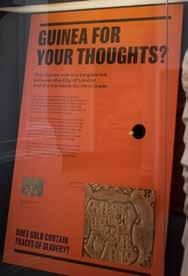
Visit the exhibition for the full story, view some of the objects and stories from the exhibition on Google Arts & Culture or join the team for their free curator-led tour of the ‘Slavery & the Bank’. exhibition. Tours take place at 12.00pm lasting approximately 20 minutes, and no booking is necessary. Arrive 10 minutes early to avoid queues as you enter the museum.
The exhibition is open now until 28 April 2023 from Monday to Friday 10.00am to 5.00pm, with late openings until 8.00pm every third Thursday of the month. Entry is free, and no need to book ahead!
Be inspired Be valued Be the difference
Community has spent decades supporting, advising and bringing together working people from across the UK.

We’re a proud campaigning union. Together we are tackling racism in workplaces across the country whilst also pushing for better policies for Black workers.
Becoming a Community member makes all the difference. From advice, guidance and a strong workplace voice, to a benefits package tailored to your needs.
To join Community, visit community-tu.org/join today!

www.avonandsomerset.police.uk/jobs
We’re a modern trade union and we’re here to help you.
BLACK HISTORY MONTH 2022 47
Louise Da-Cocodia and the discrimination faced by black nurses in the infant days of the NHS


The summer of 2023 sees the 75th anniversary of two key moments in British history – the first wave of post-war mass immigration with the arrival of HMT Empire Windrush on 22 June 1948 and the establishment of the National Health Service (NHS) on 5 July 1948.
There would appear to be no obvious connection between the two, and yet, in its days of infancy, the NHS heavily relied on many of those who stepped off of the boat in Tilbury, their children and also the thousands who arrived in the years to come – all dubbed the ‘Windrush generation’.
When the Windrush docked in Tilbury, she brought with her approximately 492 people – most of whom were men, but also women and children – from the Caribbean, mainly from the islands of Jamaica and Trinidad. Invited by the British government to help ‘rebuild’ Britain after the destruction of war, the Windrush generation provided a much-needed labour force for industries across the country. Just two weeks after their arrival, the NHS began its work and, to compensate for the shortage of staff, in 1955 a recruitment call for nurses was sent out to sixteen British colonies and former colonies. In the years that followed, an influx of women from the Caribbean came to England to train as nurses. Such was the desperation for staff that in the 1950s there were few qualification requirements – some claim that a ‘good’ educational background was all that was needed. Though by the 1960s, the requirement for a GCE and O-Levels added a restriction on who could qualify to train.
One such woman who answered the call was Louise Da-Cocodia (1934–2008). She arrived in Britain in 1955 to begin her training as a nurse at St. Olave’s hospital in London. The Ahmed Iqbal Ullah Race Relations Resource Centre, the collections of which are held in Manchester’s Central Library, holds the transcripts of an oral history project called ‘Roots Family History’. For this project, post-war first and second generation Caribbean immigrants, then living in Manchester, were interviewed
about their experiences and how they adapted to life from one island to another. Louise’s interview is one of many in this project, and with such an eventful life it is no wonder that hers is one of the lengthiest, taken in two parts. She discusses her experience as one of only a few black women at the time training to be nurses in the NHS, by then only in its seventh year, the difficulties and discrimination she and her peers faced, but also the pride that she took in her work.
Born in the Saint Catherine parish of Jamaica on 9th November 1934, Louise raised her fare for the ship across the Atlantic through family and friends. In her interview, she says that the nursing profession was so acclaimed in Jamaica that the nursing school in Kingston had a three year waiting list. While some left the Caribbean with the hope of gaining employment upon their arrival in England (many were not successful), Louise applied to a number of hospitals before she left
the island, and was successful in two, accepting the offer from St. Olave’s. In 1958, three years after she began her training she became qualified as a State Registered Nurse, at a time when there were few black nurses in the NHS. In regards to this imbalance, Louise said that while over the years more women from the non-white colonies and former colonies (e.g the Caribbean, Africa and Asia) came to Britain for the purpose of training as a nurse, the majority of the nursing staff in the 1950s and 60s were English and Irish, though she claims that few English women wanted to do the ‘hard’ and ‘dirty’ work of nursing. Louise enjoyed a 31-year-long career as a qualified nurse in the NHS, having trained in several fields including general nursing, midwifery and health visiting, before retiring as the first black senior nursing officer in Manchester in 1989.
Louise always took pride in her work and strove to expand her knowledge and training, but nevertheless, she was,
48 BLACK HISTORY MONTH 2022
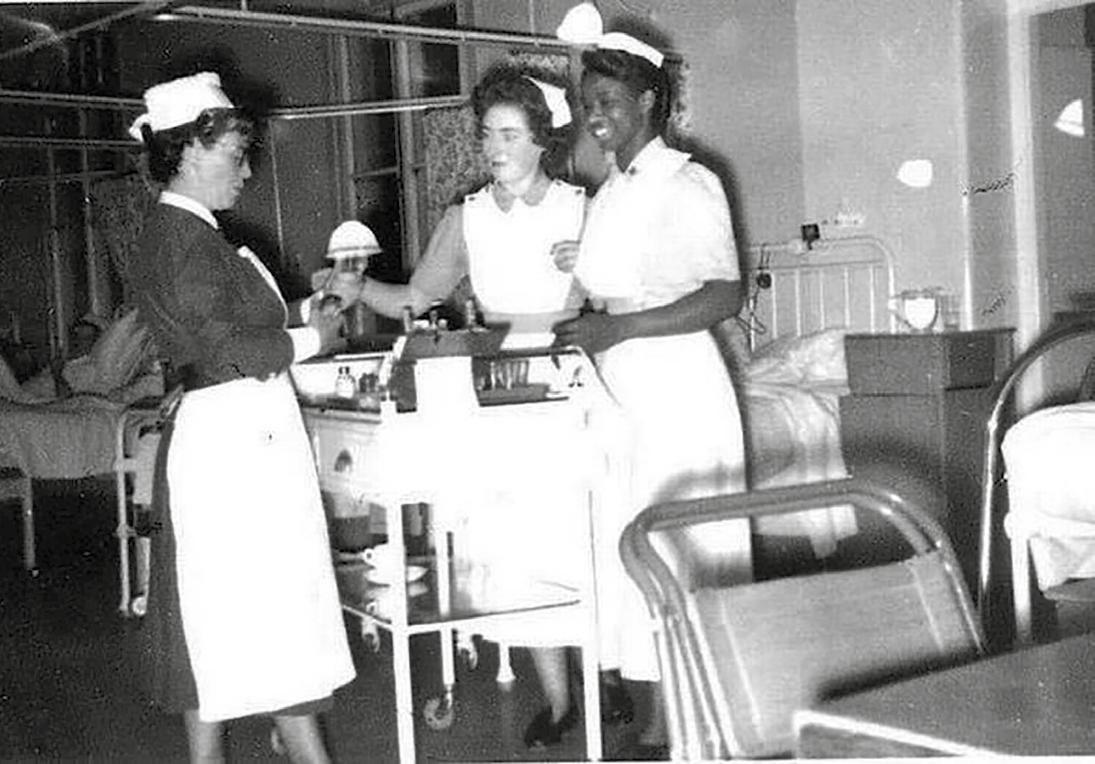




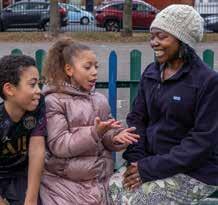


www.fosteringinbrightonandhove.org.uk 01273 295444 BrightonHoveFostering bhcc_foster fosteringbrightonhove Brighton & Hove City Council need foster carers from our Black, Asian and mixed-race communities. Allinformationaboutfosteringcanbeprovidedinotherlanguagesifrequired. foster make a difference We need people who can meet the cultural needs of our children, and make a positive difference to their lives. 7620 BLACK HISTORY MONTH 2022 49 Louise and fellow nurses dealing with patients on the wards.
unfortunately, one of the many black women who was subjected to discrimination based on the colour of her skin – though those who have talked about their experience in the early years of the NHS have often noted how this was not recognised as racism at the time, and was accepted as the norm. The transcripts from Louise’s interview show that, as a qualified black nurse, she received hostile treatment from her white colleagues who resented her position, saying such things as “those black so and so’s, coming here and giving us orders.” With the shoe on the other foot, black women were expected to “take a lot on the chin” with no feeling of companionship from their white peers. Louise also recalled how the white nurses she worked with often got preferential treatment, in that they were given the easier jobs, while black nurses like herself would typically be asked to do the ‘worst’ work, such as cleaning soiled sheets and emptying bedpans. But to complain about this treatment would be “telling tales”.
The prejudice that black nurses received extended beyond that from their colleagues, but also from the patients that they were providing care for. Typically
coming from older patients, racial comments and ignorance were often regular features in the work of nurses like Louise; some would object to their treatment being given by black nurses, while others became hysterical that they had merely been touched by black hands, or often they just carried the ignorant belief that Jamaica and the West Indies were in Africa.

Arriving in 1955, Louise was among the first wave of Caribbean women to start training in Britain when there were fewer restrictions on qualifications. However, looking back at her time in the early days of the NHS, she recounted how there seemed to be regulations in place to limit the intake of black women in training schools, and therefore limit the number of black nurses in the NHS. This extended beyond Louise’s observation, as shown in two articles from the Manchester Guardian, both written in 1955. The first, published on 2 March (Historical Newspapers Manchester Libraries), describes an incident whereby which Cefn Coed Mental Hospital in Swansea denied employment to ‘six coloured nurses’. The article states there was an “abdication [of] authority” as the
existing nurses at the hospital voted against the employment of the six women, perhaps in fear of immigrant promotion over themselves, though it was claimed that it was to favour local women first. The women were later employed in Birmingham instead, where there was a shortage of nursing staff and a commitment to up to forty student nurses from any part of the Commonwealth, regardless of their background. Mr. David Rhydderch, who was chairman of the management committee of Rubery Hill and Hollymoor Mental Hospitals in Birmingham, said of this incident that “there can be no compromise on the colour bar” and there is no place for such “least of all in nursing.” Similarly another article, dated 19 November, mentions that Storthes Hall Mental Hospital in Yorkshire would not take on black nurses, as they believed that the employment of “foreign nurses [was not] any solution to the problem of under-staffing.”
According to Louise, this limitation on black nurses meant that, in later years, she noticed that most of the black women in the NHS were kitchen or cleaning staff, partly because of the educational requirement. While she also says that more black women worked in general nursing as State Enrolled Nurses, with few reaching the status of Sister or manager – Louise was the only black midwife during her training at St. Thomas’ hospital.
Despite the discrimination she and others faced, Louise achieved great success in her nursing career and became committed to the black community in Manchester. Serving on regional Race Relations Board committees in the 1960s and 70s, the discrimination that she experienced inspired her anti-racism campaign which she described as “the commitment to bridge the gap which has led to blacks being treated as inferior.” Her services to nursing was recognised in 1989 with an honorary Master’s degree awarded by the University of Manchester and was later made a MBE in 2005 for her services to the people of Manchester.
The National Health Service is indebted to women like Louise, who travelled thousands of miles from their homes, families and cultures, to train as nurses not long after it was established, at a time when it was struggling to find staff. These women committed their lives to nursing, often doing the hard and dirty work that others would not do (like geriatric and/or psychiatric care) – all the while separated from their loved ones and enduring racism and discrimination – and the NHS is all the better off for it.
50 BLACK HISTORY MONTH 2022
Louise qualified as a Staff Registered Nurse in 1958
Find a fullfilling career in the RAF
Service Bio – AS1 Morris Sibanda
Born on the 5 January 1987 in Harare Zimbabwe. I moved to the UK with my whole family in February 2001 and settled in Hereford. I attended St Mary’s RC High School, and this is where I found out about Air Cadets and joined when I was 15 years old.
I joined the RAF in July 2018 as an ASOS (Air and Space Operations Specialist). My current posting is my first within the Air Force. I have managed to settle in my role quite comfortably and have been pushing myself and my peers as much as I can. Since I have been to this section, I have been on Exercise Tartan Spirit in Prestwick Scotland, supporting 24 Squadron and 47 Squadron with AMPA (Advanced Mission Planning Aid) for their exercise and Op Cattalo in Duqm Oman on the drawback from Afghanistan.
Going on Operations helped me learn more about the wider Air Force and taking a lot of responsibility helping all the tasks and crew to fly in and out of Afghanistan. My Operation was cut short due to Op Pitting becoming a priority, so everyone on Op Cattalo had to come back home earlier than scheduled. This was a great learning experience for me overall and would like to do something like that again. I have also extended my tour by an extra year to take full advantage of working in a Corporal role in MSC (Mission Support Cell).
I have been validated in Flight Planning, Data Input and MSC (Mission Support Cell), which helped me be a part of the standards team and look after the Trend Analysis for the section. I like challenging myself around work and in personal life so I’m always pushing myself. I am looking to go on a deployable Squadron after my time here at RAF Brize Norton, to give me a wider role and understanding in Trade Group 7, in deploying and exercise and giving me more responsibilities.
Outside the RAF I manage music artists; making their music and getting it released and promoted to radio, tv etc, and try break the artist. This has been a passion for me from the age of 16. I love traveling and meeting new people and I am very outgoing.
PASCAL SERGEANTZGAMBO
BA(Hons)
FInstLM MCMI RPTAG
Zgambo joined the Royal Air Force in October 2007 and passed out of Recruit Training Squadron at RAF Halton in January 2008. On successful completion of trade training at the Catering Training Squadron at RAF Halton, he qualified as a Logistic Air and Ground Steward and was subsequently posted to RAF Benson. During his service at RAF Benson, he completed a short VIP tour of Buckingham Palace as a personal steward to the Royal Household’s Chief of Staff. In April 2010 he attended the Advanced Caterer Course at RAF Halton. In July 2010 he was posted to 3 Mobile Catering Squadron based at RAF Wittering. During this time, he undertook a tour of BFSAI Falklands as the Junior Catering Accountant within the Tri-service Catering and Rations Squadron for a period of five months. In June 2012, he deployed to London in support of Op Olympic for a period of four months. In October 2015 he was promoted to Cpl and subsequently posted to the Defence School of Logistics at Worthy Down Barracks as a Caterer Instructor, teaching basic students and mentoring advanced students on their promotion course. During this tour, in October 2017 he was awarded the late Sqn Ldr Penny Lowe Caterer of the Year Trophy in recognition of his service and efforts to TG19’s training delivery. On completion of this tour in December 2017, he was posted within the Food Services Training Wing as the TG19 Apprenticeship Centre’s Internal Quality Assurer. He was promoted to Sgt in December 2019 and he is currently at the Airmen’s Command Squadron as a Defence Trainer on the Junior Management and Leadership Course. He is a staunch supporter of the Royal Air Forces Association (RAFA), devoting most of his spare time to RAFA as an Honorary Welfare Officer. In July 2018, he was awarded a long service medal by HRH the Queen at Buckingham Palace in recognition of his service and devotion to the Confederation of Service Charities. Passionate about championing Diversity and Inclusion across Defence, he currently sits on the MOD’s Race Network as the only Non-Commissioned Officer reporting directly to the Chief of Defence Staff. He is currently pursuing an MSc in Professional Education Practices with Plymouth University. He is single and currently resides in Nottingham.
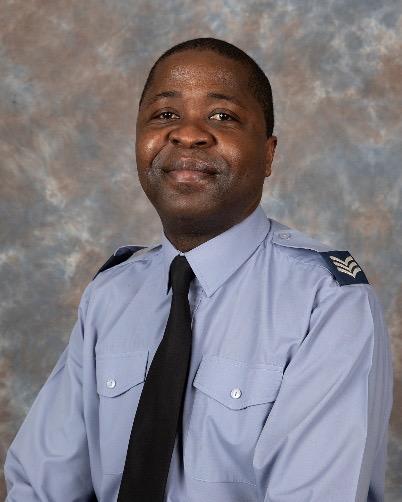

There are lots of diverse roles on offer at the Royal Air Force. Meet two of the individuals working in these exciting jobs …
Please visit our website raf.mod.uk/recruitment/aboutthe-raf TO FIND OUT MORE
BLACK HISTORY MONTH 2022 51
Black British jockey Ashleigh Wicheard takes the knee
 BY LYNDA-LOUISE BURRELL
BY LYNDA-LOUISE BURRELL
On 28 July 2022, day three of the Goodwood Festival, Black British jockey, Ashleigh Wicheard took the knee in support of Black Lives Matter, before racing to victory in the Markel Magnolia Cup – an all-female charity horseracing event. This powerful message has not been seen before at the Goodwood Racecourse in Chichester, West Sussex.
Ashleigh is a work rider for horse trainer, Neil Mulholland, riding out the stable’s horses and taking them to races. Mulholland describes Ashleigh as “a fabulous person to have around, she knows the job inside out and is an asset to the team.”
Ashleigh won the Markel Magnolia Cup on Dark Shot, a horse trained by Scott Dixon. The charity race was established 11 years ago to create an inclusive community in support of women, their ability, and wellbeing. Since then, the race has raised over £2 million for charity. This year, the Cup supported The
Brilliant Breakfast initiative in aid of The Prince’s Trust. The Brilliant Breakfast is a nationwide fundraising event, run every year for a week in October. It brings people together over breakfast, to raise money for young women on The Prince’s Trust programmes across the UK.
Describing her Magnolia Cup win as an ‘absolute thrill’, Ashleigh said: “I’ve been thinking the race over in my head for so long and this was the dream outcome. I don’t think it’s quite hit me yet.”
The 36-year-old jockey has been involved with horseracing for around 12 years on and off and hopes that her success will encourage other black women to follow in her footsteps. “If I can be a role model for black women and get more of them into the sport then I’ll be very happy. That is my goal.”
Ashleigh is also helping to promote diversity in racing through the Women in Racing programme. She explained why her victory in the Markel Magnolia Cup means so much:
“This is a sport that I am invested in. I have been trying hard to promote diversity, by being a face in the paddock. That’s a good start and I think things are starting to change. When the Magnolia Cup came along, I felt it was a really good platform for me to be able to do something on a big stage. Winning this race is probably the most impactful thing I could do. You can talk about it and read about it, but actions speak louder than words.”
Outside of racing, Ashleigh supports children and young people with autism and social, emotional and mental health issues in specialist schools, and works with a charity helping rehabilitate young offenders after their release from prison. She is a qualified Master Practitioner of Neuro Linguistic Programming, and trained in Equine Facilitated Learning. “Horses are amazing at holding a space for people with or without mental health issues, they have the capacity to support good mental health by keeping people in the present, rather than dwelling on past issues or becoming anxious about what is to come.”
Reflecting on her decision, made in advance, to take the knee and support Black Lives Matter before the race at Goodwood, Ashleigh shared: “I thought very carefully about taking the knee. I’d like to think me taking the knee will make more people aware and improve things.”
Her fellow riders also took the knee alongside her in the paddock, in a show of solidarity and support, as Ashleigh made a ‘black power’ salute.
52 BLACK HISTORY MONTH 2022
“I didn’t want to put pressure on the other girls in case they weren’t keen on the message. But they were so supportive. What an amazing group of women.”
“I was more anxious about that [taking the knee] than riding in the race, to be honest, because I know with those kind of statements, they can be met with negativity as well as positivity. I just hope that it was a positive message that gets portrayed from this.”
Following the murder of George Floyd in 2020, the act of taking the knee has become a symbolic anti-racism gesture across various types of sport. For Ashleigh, the gesture was also designed to raise awareness of the current inequalities in horseracing and her goal to encourage more black women into horseracing.

“It’s not going to happen overnight and I’m fully aware of that, but I’d like to think me
taking the knee will make more people aware and improve things as a result.”
Ashleigh described her Markel Magnolia Cup win as ‘unbelievable’ and revealed how she’d worked hard and given up her holidays to achieve a good result. There’s a message in that for everyone who wants to be a winner in whatever they do perhaps, and definitely in all Ashleigh’s incredible achievements, both on and off the racetrack.

BLACK HISTORY MONTH 2022 53
Finding The Past
By Kathy Casimir MacLean
I was fortunate that I grew up in an extended family in Dominica with my maternal great grandmother, Marie Lucie Olivaccé who continuously told us stories of the family and her past. She spoke of her parents who had eloped from Martinique to escape censure from her mother’s family. They disapproved of their white daughter’s relationship with a man of mixed heritage. She told stories of her life growing up in the village of Soufriere. My mother and my aunts would join in and talk of their childhood, their celebrations, scrapes and escapades. There was also sadness; the death of my grandmother in childbirth, how my mother had become an orphan; the nephew who was poisoned, the babies lost. My twice great grandfather, Peter Léger, was the local Registrar as well as an estate owner so I knew what was described was a life of a family of some importance and privilege.
My research into his life began with a visit to the Schomburg Center for Research in Black Culture in New York where my grandfather’s documents (The JRR Casimir Papers 1919 – 1981) are held. There I found a wealth of material related to Casimir’s UNIA activities, his interests in Black history, rare publications and his poetry. Much of this was already in the public domain via Martin’s writings and the Marcus Garvey UNIA Papers.
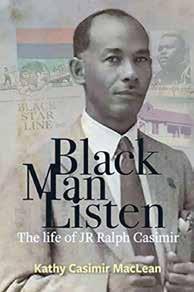
I had known my grandfather as a relaxed and elderly man and was surprised by what I now learnt. I needed to know much more to understand his ideology and motivation. Many of his books and some papers had been donated to the Roseau Public Library in Dominica after his death, so this was my next port of call. What I found added to my knowledge of his interest in literature and writing poetry and of those he corresponded with, including Langston Hughes and Sylvia Pankhurst.
I have always been lured by the past. Researching and writing Black Man Listen, a biography of my Dominican grandfather, J R Ralph Casimir (1898–1996), confirmed that it is important to know about our ancestors and to teach our children about their heritage. I want my children and grandchildren to know who their ancestors were, how they lived their lives and their stories.
In contrast, I grew up knowing a lot less about my father’s family. I had gleanings of my grandparents’ history, but it was much later that I became aware of my paternal grandfather, Ralph Casimir’s activities and his importance to Dominica’s own story. I had known that he wrote poetry as it occasionally appeared in the local newspaper and then when I was studying in Bristol, he would send me his latest poetry anthology. However, it was not until the 1990s when I read in the Dominica Chronicle, the serialised version of A Pan African In Dominica by Tony Martin, a Professor at Wellesley College, that I knew the extent of his connection to Marcus Garvey and the Universal Negro Improvement Association.
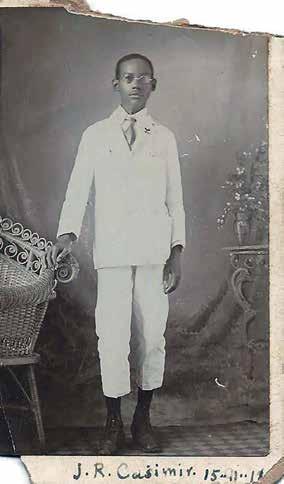
In 2012, I was invited to speak about my grandfather’s poetry at the Nature Island Literary Festival in Dominica. In preparing for this event, I discovered that he had compiled Dominica’s first poetry anthologies and that his political activities and involvement had gone beyond the brief period of UNIA activity on the island, (1919 – 1923). At the end of my talk, there were people in the audience who wanted to share their memories of my grandfather. Those who did, spoke with warmth, affection and respect and I realised his story needed to be told.
But there was something missing from the picture, it was then that my father casually mentioned that he had a file with some more personal family papers. This was pure gold as amongst it all was a diary that Casimir had kept up to 1925. There were also letters from his mother and brother.
54 BLACK HISTORY MONTH 2022
Black Man Listen – The Life of JR Ralph Casmir by Kathy Casimir Maclean
is published by Papillote Press, 2022, £8.99)
Throughout the documents that I came across were references to him having been a councillor and involved in other local political activity, however I could find little concrete detail. My next step was to research newspapers published during the relevant period. I found not only articles relating to Casimir’s political activities but the context in which they took place, how they were received by those in power. I also interviewed my aunts and his friends to acquire a rounded view of the man. Black man Listen: The Life of JR Ralph Casimir is the result of my research.
I am endlessly curious about my ancestors and even before I had decided to write a book, I would spend time on Ancestry websites. Family trees fascinate me and from an early age I would construct them with my great grandmother. Through research I have been able to build a more accurate picture of my diasporic family history. In the Ellis Island records, I have found that my maternal grandfather’s family emigrated to the USA from Kassa in Hungary and through DNA testing found my elusive maternal great grandfather.
Researching my family is a personal interest. I have a yearning to know of the past lives linked to me as they are part of who I am. When one traces one’s genealogy one finds connections to events and people who shaped the past, history is our story because our families were there. However, I know that as I am a descendent of enslaved people, I can never really know the whole story of my African ancestry as there is no documentation to tie me to my African family genealogy, their cultures and traditions.





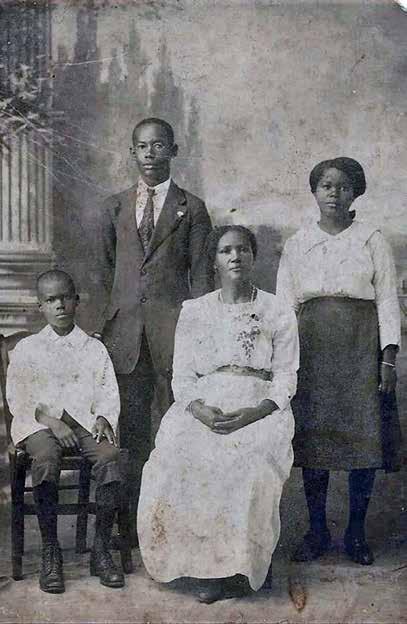
BLACK HISTORY MONTH 2022 55
The Bristol Bus Boycott of 1963 arose from the refusal of the Bristol Omnibus Company to employ black or Asian bus crews in the city of Bristol, England.

In common with other British cities, there was widespread racial discrimination in housing and employment at that time against “coloureds”. Led by youth worker Paul Stephenson and the West Indian Development Council, the boycott of the company’s buses by Bristolians lasted for four months until the company backed down and overturned the colour bar.
The boycott drew national attention to racial discrimination in Britain, and the campaign was supported by national politicians, with interventions being made by church groups and the High Commissioner for Trinidad and Tobago. The Bristol Bus Boycott was considered by some to have been influential in the passing of the Race Relations Act 1965 which made “racial discrimination unlawful in public places” and the Race Relations Act 1968, which extended the provisions to employment and housing.
Background
Bristol in the early 1960s had an estimated 3,000 residents of West Indian origin, some who had served in the British military during World War II and some who had emigrated to Britain more recently. A large number lived in the area around City Road in St Pauls. They suffered discrimination in housing and employment, and some encountered violence from Teddy Boy gangs of white British youths. This community set up their own churches and associations, including the West Indian Association, which began to act as a representative body.
One of their foremost grievances was the colour bar operated by the Bristol Omnibus Company, which had been a nationalised company owned by the British government since 1950, and operated through the Transport Holding Company. Although there was a reported labour shortage on the buses, black prospective employees were refused work as bus crews, although they were employed in lower paid positions in workshops and canteens.
The Bristol Bus Boycott of 1963
The boycott drew national attention to racial discrimination in Britain, and the campaign was supported by national politicians, with interventions being made by church groups and the High Commissioner for Trinidad and Tobago.
The Bristol Evening Post and the Western Daily Press both ran series on the colour bar, which was blamed by company management on the Transport and General Workers’ Union (TGWU), which represented bus workers. Local union officials denied that there was any colour bar, but in 1955 the Passenger Group of the TGWU had passed a resolution that “coloured” workers should not be employed as bus crews. Andrew Hake, curator of the Bristol Industrial Mission, recalled that “The TGWU in the city had said that if one black man steps on the platform as a conductor, every wheel will stop.”
The bus workers’ concern, apart from racism, was that a new competitive source of labour could reduce their earnings. Pay was low and workers relied on overtime to get a good wage. One shop steward said, “people were fearful of an influx of people from elsewhere (on the grounds it) would be reducing their earnings potential.”
Boycott
Four young West Indian men, Roy Hackett, Owen Henry, Audley Evans and Prince Brown, formed an action group, later to be called the West Indian Development
Council. They were unhappy with the lack of progress in fighting discrimination by the West Indian Association. Owen Henry had met Paul Stephenson, whose father was from West Africa, and who had been to college. The group decided that the articulate Stephenson would be their spokesman. Stephenson set up a test case to prove the colour bar existed by arranging an interview with the bus company for Guy Bailey, a young warehouseman and Boys’ Brigade officer. When Stephenson told the company that Bailey was West Indian, the interview was cancelled. Inspired by the refusal of Rosa Parks to give up her seat on a bus in Alabama and the ensuing Montgomery Bus Boycott in the United States in 1955, the activists decided on a bus boycott in Bristol.
Their action was announced at a press conference on 29 April 1955. The following day they claimed that none of the city’s West Indians were using the buses and that many white people supported them. In an editorial, the Bristol Evening Post pointed out that the TGWU opposed apartheid in South Africa and asked what trade union leaders were doing to
56 BLACK HISTORY MONTH 2022
counteract racism in their own ranks. When reporters questioned the bus company about the boycott, the general manager, Ian Patey, said:
“The advent of coloured crews would mean a gradual falling off of white staff. It is true that London Transport employ a large coloured staff. They even have to recruitment offices in Jamaica and they subsidise the fares to Britain of their new coloured employees. As a result of this, the amount of white labour dwindles steadily on the London Underground. You won’t get a white man in London to admit it, but which of them will join a service where they may find themselves working under a coloured foreman? … I understand that in London, coloured men have become arrogant and rude, after they have been employed for some months.”
Support
Students from Bristol University held a protest march to the bus station and the local headquarters of the TGWU on 1 May, which attracted heckling from bus crews as they passed through the city centre, according to the local press. Local MP Tony Benn contacted then Labour Opposition leader Harold Wilson, who spoke out against the colour bar at an Anti-Apartheid Movement rally in London. On 2 May local Labour Party Alderman Henry Hennessey spoke of the apparent collusion between bus company management and the TGWU over the colour bar. On 3 May, the ruling Labour Group on the city council threatened him with expulsion, despite his honourable service of over forty years.
Tony Benn, Fenner Brockway and former cricketer Learie Constantine also condemned the bus company. Constantine was then serving as High Commissioner for Trinidad and Tobago. Constantine wrote letters to the bus company and Stephenson and spoke out against the colour bar to reporters when he attended the cricket match between the West Indies and Gloucestershire at the County Ground, which took place from the 4 to 7 May. The West Indies team refused to publicly support the boycott, saying that sport and politics did not mix. During the game, local members of the Campaign Against Racial Discrimination (CARD) distributed leaflets urging spectators to support the action.
The local branch of the TGWU refused to meet with a delegation from the West Indian Development Council, and an increasingly bitter war of words was fought out in the local media.
Four young West Indian men, Roy Hackett, Owen Henry, Audley Evans and Prince Brown, formed an action group, later to be called the West Indian Development Council.
Ron Nethercott, South West Regional Secretary of the union, persuaded a local black TGWU member, Bill Smith, to sign a statement which called for quiet negotiation to solve the dispute. It condemned Stephenson for causing potential harm to the city’s black and Asian population. Nethercott launched an attack on Stephenson in the Daily Herald newspaper, calling him dishonest and irresponsible. This led to a libel case in the High Court, which awarded Stephenson damages and costs in December 1963.
The Bristol Council of Churches launched a mediation attempt, saying
“We seriously regret that what may prove an extended racial conflict arising from this issue has apparently been deliberately created by a small group of West Indians professing to be representative. We also deplore the apparent fact that social and economic fears on the part of some white people should have placed the Bristol Bus Company in a position where it is most difficult to fulfil the Christian ideal of race relations.”
This in turn was criticised by Robert Davison, an official at the Jamaican High Commission, who stated that it was “nonsense to describe a group of West Indians as unrepresentative when no representative West Indian body existed.”
At a May Day rally, held on Sunday 6 May in Eastville, local Trades Council members publicly criticised the TGWU. On the same day Paul Stephenson had organised a demonstration march to St Mary Redcliffe church, but there was a poor turnout. Some local West Indians said they should not ripple the water and, according to Roy Hackett, they may have feared victimisation. The dispute led to what has been described as one of the largest mailbags that the Bristol Evening Post had ever received, with contributors writing in support of both sides of the issue.
Resolution
The union, the city Labour establishment and the Bishop of Bristol, Oliver Stratford Tomkins, ignored Stephenson and tried to work with Bill Smith of the TGWU to resolve the dispute. Learie Constantine
continued with his support for the campaign, meeting with the Lord Mayor of Bristol and Frank Cousins, leader of the Transport and General Workers Union. In addition, he went to the Bristol Omnibus Company’s parent, the Transport Holding Company, and persuaded them to send officials to talk with the union. The company chairman told Constantine that racial discrimination was not company policy. Negotiations between the bus company and the union continued for several months until a mass meeting of 500 bus workers agreed on 27 August to end the colour bar. On 28 August 1963 Ian Patey announced that there would be no more discrimination in employing bus crews. It was on the same day that Martin Luther King made his famous “I Have a Dream” speech at the March on Washington. On 17 September, Raghbir Singh, a Sikh, became Bristol’s first non-white bus conductor. A few days later two Jamaican and two Pakistani men joined him.
Aftermath
In 1965, the United Kingdom Parliament passed a Race Relations Act, which made “racial discrimination unlawful in public places.” This was followed by the Race Relations Act 1968 which extended the provisions to housing and employment. The enactment of this legislation has been cited by some as having been influenced by the Bristol bus boycott. Robert Verkaik, Legal Affairs Correspondent for The Independent newspaper, said “Few doubt that without Mr Stephenson’s efforts it would have been difficult for Harold Wilson’s Labour government to bring in Britain’s first anti-discrimination laws.” In 2003, as part of Black History Month, BBC Radio 4 broadcast a programme about the boycott.
Unite, the successor to the Transport and General Workers Union, issued an apology in February 2013. Laurence Faircloth, the union’s South West secretary said of the union’s stance at the time, “It was completely unacceptable. I can well accept the sense of injustice and pain that has been felt because [of] what happened in Bristol all those years ago.”
In 2009, Stephenson was awarded the OBE for his part in organising the bus boycott. Bailey and Hackett were also awarded OBEs. Roy Hacket died in August this year.
BLACK HISTORY MONTH 2022 57
Ken
Racing Enthusiast to Paddock Expert
By Catherine Ross
When a hobby you love can become a career, work becomes even more enjoyable. You have no trouble getting out of bed, you don’t mind the travel and you enjoy talking about it to any and everyone. Such is the current life of Ken Pitterson.


What’s even more exciting is what Ken does. He’s a Paddock Expert, which means he helps spot and shares information with horse racing punters before a race which horse, he thinks is a potential winner, basing his decision on assessment of the horses’ fitness and behaviour in the parade ring.
Ken may be the only Black, Paddock Expert in the UK, but he’s not interested as being known as the only, or the first black Paddock Expert, he just wants to be a successful and long established one. He’s really enjoying being part of the horse racing scene, from paddock to the parade ring to the track. In my interview with him, he indulges in a moment of reminiscing about the start of the illustrious career that he has carved out for himself. It all began as a group of four friends who went to the horse racing meets together, even if was not always profitable. It was the fun of it that was uppermost, that mattered, not the money. After a while though the demands of life got in the way and from four friends travelling together for a fun afternoon, the number became three, and then dwindled to two and then Ken found himself, the only one left. He had to decide, ‘Was it worth going on his own’? It wasn’t too difficult a decision though for Ken was taken under the wing of John Hunt and Ollie Bells who taught him about what to look for in the paddock and on the track. Ken did rise in the racing world, but it has not been easy. He’s had to learn a lot and he’s had to learn it quickly. Over time Ken got to know more people and his interest in many aspects of the sport grew. As his knowledge and his experiences increased so have his opportunities to work in a variety of roles. At about the time that his mentor retired, Ken was asked to write a column for a racing newspaper, The Weekender, and before long, he was asked to do a two-month trial working for William Hill Radio, but Ken’s work as a broadcaster has continued now for more than 20 years. His voice has become recognisable, and his opinions and observations sought and appreciated.

Though through Covid his work was brought to an end with the Weekender, he continues his work as a Racing Blogger.
Ken makes appearances on TV too and has a following within and outside of the UK. His opinions and observations matter, and he appreciates the acknowledgement he receives because his rise in the racing world has not always been easy. His visibility in the horse racing scene is still a thing to be commented on because of his colour but he is always sought out by regular racecourse goers.
What most regular racegoers tend to look for in choosing a

winner is the name of the horse, or the colours worn by the jockeys, or a look at the race card, or lucky omens. Some even look at the pile of statistics that are available, but Ken Pitterson has an additional technique, He observes the horse, in the paddock, and in the parade ring before they go on the track. Some things I picked up and will remember are the tips that remind me about people, and how I judge them! Watch out for any irritability and jumping about when jockey is mounting it, and if the horse is rearing and its tail swishing before a race for example. He also advises to pick a horse that strides around the paddock purposefully. Horses that take short strides is a slow walker and doesn’t have any bounce. suggests they are tired, and that’s before they get going!
Ken says he wants to be known for his success at picking winners and for the tips and guidance he gives and gets right, rathen than be known for his colour. It’s humbling though he says to be considered a role model, but is quick to point out that though he appreciates interest in his work, what he’s done is attainable by anyone prepared to put in the work. Work in the racing fraternity is like that in many others, it requires an ability to get on with people and to build effective work relations. He points out what he says is the obvious, that there will be good day and bad days, but he says it’s important that people remember that.
He advises anyone wanted to work in racing to do so, to give it a go, to give it a try as there are so many jobs to consider, from in the media – journalist, and presenter for example to being in the stables as handlers for example. Living near a racecourse or being able to get access to one in close proximity means you get to be at the races regularly, and as is true in a lot of areas of life, when you show up, so does luck so make a point of being present, being there.
What Am I Living For? Equal Justice In partnership with At St Martin-in-the-Fields, Trafalgar Square, London WC2N 4JH 020 7766 1100 • www.smitf.org with Bryan Stevenson The inspirational human rights lawyer from US comes to London to explore the destructive inequalities of racism and the fundamental need for equal justice. Monday 7 November, 7.00pm Tickets and information: www.smitf.org/lectures 58 BLACK HISTORY MONTH 2022
Pitterson – From
ENGINEERING CONSTRUCTION – BUILDING A BETTER FUTURE.
Imagine a world where there was no heat to warm our homes, no clean water to drink and no petrol to fill our cars. Without Engineering Construction our world would look and feel very different.
Engineering construction is the industry that looks after the UK’s, and the wider worlds, critical infrastructure. They design, construct and maintain the industry sites and process plants responsible for production of oil, gas, chemicals, water and food, and power generation.
The Engineering Construction Industry Training Board (ECITB) is an arms-length Government body that works to attract, recruit and train the skilled workforce required by the engineering construction industry to keep the world moving.

ABOUT ENGINEERING CONSTRUCTION
Engineering construction makes up more than one-fifth of the total UK economy and supports the nation’s critical infrastructure. 190,000 people work in engineering construction in the UK, contributing around £100 billion to the economy. Workers design, test, install, maintain, repair, commission and decommission industrial facilities from wind farms to nuclear power stations to sports stadiums. Engineering construction will be at the heart of the revolution as we start to make serious progress towards the energy solutions needed to tackle climate change.
If you want to find out more about working in the Engineering Construction Industry the following links are a great place to start: ecitb.org.uk/apprenticeships-careers/careers-engineering-construction
REAL ENGINEERS, REAL STORIES CHINWE ODILI – PROJECT ENGINEER – KENT
My name is Chinwe and I work as a civil engineer, managing the integrity of offshore assets all over the world. In my line of work, I have been involved in Oil & Gas and offshore wind. These projects have been highly dynamic in terms of the opportunities given from both a technical and project managerial perspective. In the past, I have been involved in tenders, bids, design work and risk-based inspection planning. I suppose having a view of the lifecycle of a project from the conceptual stage right up to the integrity management stage has been truly rewarding.

My interest in engineering was sparked by a book by Henry Petroski called ‘to engineer is human’ and of course, a visit to Legoland. The former enabled me to piece the world together differently and look at building blocks to solving problems. This is because in fact, this is what engineering is. It comes from the latin derivative ‘ingeniator’ which means to devise or contrive. As a child, I was very interested in solving problems i.e puzzles, sudoku and maths challenges. And Legoland made me see a realm of opportunities, it was a fun way for a novice like myself to see the basics of real structural engineering, loading, constraints and foundations on such a small scale.
For me, it was the starting point of my dream to build high-rise structures in the future.
Fortunately, I was able to find like-minded individuals who wanted to merge this passion for engineering with a push for diversity in all STEM related fields, and this emerged through the Innov8 group founded by the ECITB. Since its conception the group has focused on many key areas such as the energy transition, a critical first step to achieving Net Zero and the retention, attraction and diversity of people in Engineering careers. As such, this group has encouraged me to reflect on the contribution Net Zero has made to my career. This has been positive in the greater depth of opportunities available to me as the company I work for has been commissioned for an even greater number of offshore wind and carbon capture projects. I have also found clients with oil and gas plants, at life extension stages, come to us with solutions to limit their carbon footprint. Exciting times, as this already dispels the notion that oil and gas contractors are disinterested in sustainability and Net Zero. In summary, I would tell my younger self to expect more than just wearing a High Vis vests, a safety helmet and picking up building blocks with my bare hands. I would tell myself to expect to see the world through a digitally and virtually changing landscape where all things are possible. Newsflash, little Chi, well there is just more than one way to be an engineer!
BLACK HISTORY MONTH 2022 59
THE WINDRUSH EXPERIENCE EXPRESSED IN MUSIC FROM 1948 TO 2022
BY CATHERINE ROSS
The Windrush experience began with Caribbeans being invited to Britain to help rebuild the country after World War 2. Receiving an invitation from the British Government on behalf of the King, many responded positively and journeyed over 4,000 miles to England’s ‘green and pleasant land’, where the streets were reputedly paved with gold.
Among the very first Caribbeans to arrive in Britain aboard the SS Empire Windrush was Aldwyn Roberts, a Trinidadian Calypsonian better known as Lord Kitchener. He composed and sang a song that expressed the sentiments of many of his fellow passengers – ‘London Is The Place for Me’.
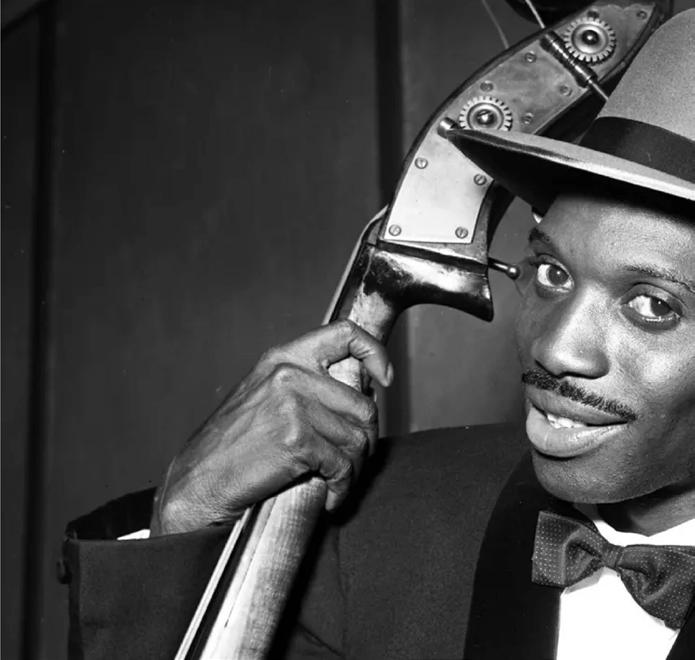
“Well believe me I am speaking broadmindedly I am glad to know My Mother Country I have been travelling to countries years ago
But this is the place I wanted to know London that is the place for me”
The expectations of many Windrushers that they would be welcomed with open arms in the country they had been invited to by the King soon came face to face with a different reality. By 1959, many of the Windrush arrivals were singing the ‘Teddy Boy Calypso (Bring Back The Cat-O-Nine)’ by Lord Invader and his Calypso Rhythm Boys, a song that spoke of racial attacks around the UK led by Teddy Boys. The lyrics are hard-hitting and call for corporal punishment to stop the violence.
“The only thing to stop those Teddy Boys, From causing panic in Great Britain, The only thing to stop those hooligans, From causing panic in England, Well I hope that the Government, See they need another kind of punishment, I say one thing to cool down this crime, Is to bring back the old-time cat-o-nine.”
It wasn’t just the Teddy Boys of course, Windrushers often faced racism in school, at work and on the streets. Lord Kitchener
summed it up in his song ‘If You’re Brown’, with lyrics that are a far cry from the hopes and dreams he brought with him in 1948.
“It’s a shame, it’s unfair, but what can you do
The colour of your skin makes it hard for you
You can tell the world you still will get no place
Every door is shut in your face
So boys, if you brown they say you can stick around
If you white, well everything’s alright If your skin is dark, no use to try You got to suffer until you die.”
Despite the hardships the Windrush Generation faced, the religious faith of many has remained strong and music has been a big part of that. It has been said that in the 1950s and 1960s, you could tell the streets where Caribbeans lived because of the Jim Reeves, Pat Boone and
60 BLACK HISTORY MONTH 2022
Harry Secombe songs playing all day on a Sunday – including songs like ‘Take My Hand Precious Lord’ and ‘What A Friend We Have In Jesus’. In the first 20 years of living in the UK, newly arrived Caribbeans in many places around Britain were denied access to established places of worship. They had to worship at home before establishing their own Black churches, all of which continue to thrive today.
Many Caribbeans intended to stay in England for just a few years and then return home, but plans often changed when they fell in love with people in Britain, including those from different Caribbean islands to their own. The soundtrack of the fifties and sixties included songs like ‘Moon River’ by Danny Williams, ‘Welcome To My World’ by Jim Reeves, and ‘What Do You Want To Make Those Eyes At Me For?’ by Emile Ford and The Checkmates. Calypsos from ‘back home’ were also popular too including songs like ‘Jean & Dinah’ by the Trinidadian Calypsonian Mighty Sparrow, aka Slinger Francisco.
The sixties brought the ska beat to Britain with songs by artists like Prince Buster and The Blue Beats giving hope to many Caribbeans. Jamaica achieved independence from the UK in 1962 and Prince Buster’s hit ‘Independence Song’ was hardly off the turntables, with many Caribbeans hoping their island would soon be next.
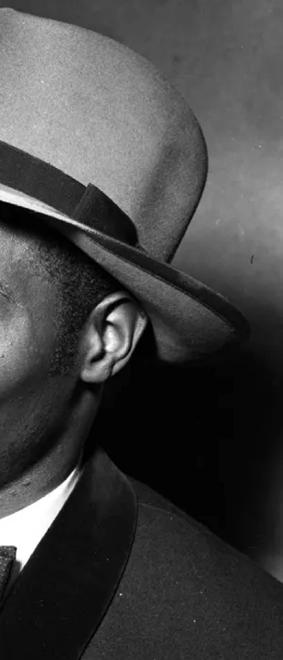
“This is the new talk
All callin over town
The independent people are swingin the news around
It’s for Jamaica, where I stand
So please join in my happy band
Let’s all together, sing this independent song.”
Britain’s love affair with Jamaican music was visible to all. Millie Small’s ‘My Boy Lollipop’ was riding high in the UK charts, helping to launch the iconic Island Records into mainstream popular music. Trojan Records launched in London in 1968, with songs like Desmond Dekker’s ‘Israelites’ and Dandy Livingstone’s ‘Rudy, A Message To You’ resonating with young people from all communities.
By the 1980s, many of the Windrush Generation’s descendants had become prolific writers, poets, and musicians. Jamaican music had helped to blend Jamaican patois with London English, laying the foundations for what’s known today as Multicultural London English.
Dub poets like Linton Kwesi Johnson and Benjamin Zephaniah led the way, sharing the experience of many Black people in spoken word over reggae rhythms, including issues like police brutality and racism. Johnson summed it up in his poem ‘Sonny’s Lettah (Anti Sus Poem) in 1979:
“It was de miggle a di rush hour
Hevrybody jus a hustle and a bustle
To go home fi dem evenin’ shower
Mi an Jim stan up waitin’ pon a bus
Not causin’ no fuss
When all of a sudden a police van pull up
Out jump tree policemen
De whole a dem carryin’ baton
Dem walk straight up to me and Jim
Mama, mek I tell you wa dem do to Jim?
Mek I tell you wa dem do to ‘im?
Dem thump him him in him belly and it turn to jelly Dem lick ‘im pon ‘im back and ‘im rib get pop Dem thump him pon him head but it tough like lead
Dem kick ‘im in ‘im seed and it started to bleed
Mama, I jus couldn’t stan up deh, nah do nuttin”
The 1980s also saw the death of Bob Marley, and the emergence of new homegrown styles of Jamaican music like Dancehall, pioneered by the sound systems of artists like Tippa Irie and Ragga Twins. The Windrush Generation was more inclined to look back, but their British born children were looking forward and reimagining Jamaican music from a British perspective. Inspired by roots reggae bands like Birmingham’s Steel Pulse, Windrush descendants had no intention of being treated like second class citizens.
“We once beggars are now choosers
No, no intention to be losers
Striving forward with ambition
And if it takes ammunition
We rebel in Handsworth revolution.”
Movements like 2-tone brought ska and reggae together with punk, via bands like The Specials, while reggae influenced everyone from The Clash to UB40.
The decades that followed saw the continuing evolution of homegrown musical styles influenced by Jamaican and British music, including Jungle, 2-step, and Grime. We also called out cultural appropriation, with some white artists accused of raiding Black (and other non-white) cultures, without recognising the artists and cultures that made their success possible.
Fast forward to the present day and Calypso is still going strong of course. In 2020, the Caribbean Calypso Challenge saw professional and amateur Calypsonians from across the Caribbean diaspora share their extempo rhymes on Covid-19 – from messages of hope, to tips on things like handwashing and social distancing.
Reggae and ska is still the music of protest, with British band Captain SKA protesting against Theresa May in the run-up to the Windrush Scandal with the song ‘Liar Liar GE2017’. Their song ‘The Windrush’ was released in 2018. With the phrase “one down, one to go” it called on Theresa May to follow in Home Secretary Amber Rudd’s footsteps and resign – as it was May’s ‘Hostile Environment’ policy and the changes that she made to the law which had led to the Windrush Scandal, a scandal which saw some members of the Windrush Generation and their descendants wrongly deemed ‘illegal immigrants’ and threatened with
BLACK HISTORY MONTH 2022 61
ALDWYN ROBERTS
deportation. In 2019, Captain SKA released the song ‘Nigel Farage Is A Racist’ in protest against Brexit-inspired racism.
The unlawful killing of George Floyd in the US rocked the world, with protests declaring ‘silence is violence’. Black people and their allies stood up to systemic racism and demanded the decolonisation of the UK, but there’s a long, long way to go. Music continued to be part of the resistance, with Black Lives Matter UK urging people to play ‘The Harder They Come’ by Jamaican reggae legend Jimmy Cliff at 7.00pm on 4 June 2020 – in protest at the disproportionate impact of Covid-19 on BAME communities and Black people on the front line in health and social care. Jimmy Cliff’s inspirational songs were a big part of many Black people’s lives in the 1970s, with Windrushers often choosing to have ‘Many Rivers To Cross’ played at their funerals. The lyrics tell of struggles which many experienced, but just as they managed to survive by willpower and pride in self and their origins, so too will those who come after them.
“Many rivers to cross and it’s only my will
That keeps me alive
I’ve been licked, washed up for years And I merely survive because of my pride.”
Another song that’s often included in the funeral playlists of many Caribbeans is Bob Marley’s ‘Three Little Birds’ – with the words giving hope to their family and friends, just as the three little birds gave the Windrush Generation hope.
“Don’t worry about a thing ‘Cause every little thing is gonna be alright Singin’ don’t worry about a thing ‘Cause every little thing gonna be alright.”
It’s been quite a journey for the Windrush Generation since they and Lord Kitchener arrived at Tilbury Docks in 1948. They have experienced so much and faced such a lot of hardships, despite contributing and achieving so much for Britain. Perhaps Jamaican reggae dancehall artist Buju Baton has it right in
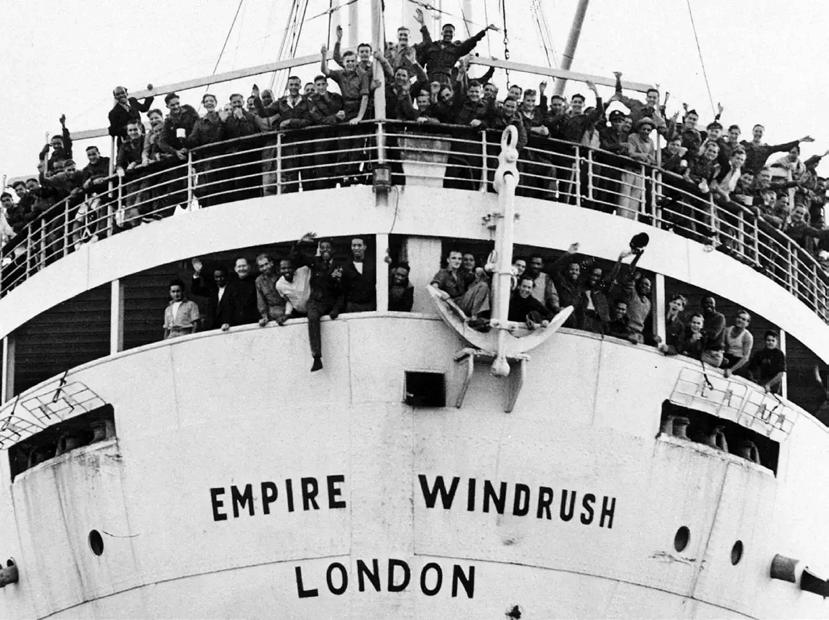
his 2020 song ‘Blessed’, with its message that no matter what, in time, the Windrush Generation and their descendants all agree:
“We ago mek it, mek it
Win the prize and tek it, tek it
We ago mek it, mek it
Four corner, global
We ah strive and ah reach fi we goal
Dem ah fight and spite through dem in control
Dem ah real asshole, but a long time
We ah fight fi a slice of di bread
Dem ah scream and ah dream and ah wish we fi dead
But ah God have we head ah nuh just now
We ah scream and ah cheer fi di team
Dem ah plan how fi bench we and dem rule supreme
Like ah dem one fi clean
Well imagine we ah try move out of di shack
Dem ah cry and ah spy and ah try stop we clock
Guess ah who have we back
Tell dem seh we bless
Tell dem we bless, tell dem we bless, tell dem we bless
Tell dem we bless, tell dem we bless, tell dem we bless”
62 BLACK HISTORY MONTH 2022
DAL BABU OBE CHAIR, SEACOLE GROUP
understands what it’s like to be the only one in room. We also want to be a group of action; BAE staff and patients are looking at us to provide challenge on discriminatory practices and racist treatment.
But this isn’t news, is it? Let’s go back to 1948; the birth of the NHS. The architect of the NHS, Bevan, described it as “a great and novel undertaking”, with services free at the point of delivery transformed the health of our nation and ensured service was accessible to all. It was not long before the success of the NHS led to a crisis of staff shortages (sounds familiar) so who did they turn too?
The Caribbean…
I remember the first meeting of the Seacole Group in a NHS Canteen in Kings Cross, London. Cherron (vice chair) was a former Civil Servant who worked in Whitehall, Mehboob was a former Council Leader, Cedi was an NHS Chair, and I was a former Chief Superintendent. We were Non-Executive Directors on NHS Boards making crucial decisions for the NHS.
Named after the Black nurse, we wanted to form a group that took action. A group which strengthened BAE NED representation and provided a representative voice on NHS Boards so that matters of race are raised, discussed and solutions explored.
Why is this important?
Even at the table where the decisions are being made, Black, Asian and other ethnic staff (BAE) experienced racism, isolation and gaslighting. The five of us recognised the need for a national network representing BAE non-executive directors and thus the Seacole Group was born. This is a network that provides a safe space for members to unload and pour out in an arena with people who ‘get it’; who
Enoch Powell, the health minister travelled to the Caribbean to lead a massive recruitment drive to recruit doctors and nurses to the NHS. Promises of a warm welcome, well paid jobs and plenty of homes, lured thousands of people from the Caribbean to the UK. Who knew that in less than a decade in his new role as immigration minister, would see him deliver his “Rivers of Blood” speech in 1968?
Despite the lack of warm welcome (from both people and the weather), despite the refusal to house them (no blacks, no Irish, no dogs) and despite receiving overt racist behaviour and comments, these Doctors and Nurses became the bedrock of the NHS and continue to be. Sadly, their contribution is not properly recognised and their representation in management and on NHS Boards is poor. The 2018 NHS Providers board membership and diversity survey found that though the national BAE profile is 14% of the population, BAE individuals made up only 7.7% of NHS provider boards.
At the same time, health outcomes are worse for people from diverse racial groups. For example, Black women are four times more like to die during child birth than white women and one in four Black men contracting prostate cancer. And let’s not forget about the impact COVID had on the people from ethnic minorities.
The Workforce Race Equality Standard (WRES) 2021 Data Analysis Report for NHS Trusts published on 7 April 2022, highlights the experience of black, Asian and other ethnic (BAE) people working in the NHS. It
provides an overview of the data on nine WRES indicators and where possible, comparison against data from previous years. 2021 report findings demonstrated a failure in the practical application of our NHS commitment towards ensuring workforce race equality. There remains a significant gap between NHS commitment and the continuing health inequalities and experience of staff.
There is some good news. We’ve seen an increase in the number of very senior managers of black, Asian and other ethnic (BAE) origin and a steady decline in the number of black staff being referred to the disciplinary process. But there has been a fall in the number of BAE executives and racial disparity persists in 50% NHS organisations.

Overall, progress on race in the NHS continues at a glacial pace and there is still so much to do to reach equitable outcomes for people from diverse racial groups. This is why the Seacole Group is so important. Our members understand what it’s like to be the person around the board table raising matters regarding race inequalities (expected to be the expert on race). The Seacole Group will continue in its effort to speak out on race inequalities through our working groups, masterclasses and strategic partners.
Our group has grown exponentially, and our collective voice is increasing. We need more people, especially those from African and Caribbean backgrounds taking up non-executive Board Positions in the NHS and other sectors. Our recent report on NED recruitment gives insight into the process experienced by black and Asian NEDs. Bringing substance, insight and lived experience to the conversation and decision making process.
We heard the commitments and the rhetoric following the murder of George Floyd. We know fine words butter no parsnips! Now is the time for change. We owe it to those pioneer Nurses and Doctors who responded to the UK’s calling.
For more information about the Seacole Group, visit our website: seacolegroup.co.uk or follow us on Twitter @SeacoleG
Dal Babu OBE
Chair, Seacole Group
BLACK HISTORY MONTH 2022 63
‘GRIME STORIES:
THE CORNER TO THE MAINSTREAM’
Grime may be huge in mainstream culture now, both in the UK and around the world, but it wasn’t always that way. ‘Grime Stories: from the corner to the mainstream’ is a new free exhibition at the Museum of London, exploring the music, the people, and the places behind the early days of the genre and its rise to popularity.
Co-curated by early grime documentarian, Roony ‘RiskyRoadz’ Keefe, the exhibition focuses on grime’s roots in East London and the community that founded it; as well as what’s happening in the scene today. Keefe’s now-legendary DVD series, Risky Roadz, helped to document the evolution of early grime featuring the likes of Skepta, Kano, Wiley and JME, at a time before social media and Spotify; alongside DVD series like Troy ‘A+’ Miller’s Practice Hours.
Keefe explained: “Grime is a culture in itself and uniquely houses London’s attitude and DIY spirit. In two decades, it has given so much back, not only to the city, but to an international audience. Grime’s influence has changed music forever. This Museum of London display makes me feel proud to see grime’s
legacy acknowledged, knowing how far the scene has come and how essential it is to London’s culture. Grime continues to push boundaries and ‘Grime Stories: from the corner to the mainstream’ will bring its history and pioneering work to a whole new audience.”
Around two decades ago, in the early noughties, grime music emerged in the underground music scene, flourishing through pirate radio stations like Rinse FM and Déjà vu FM, and record shops including Rhythm Division. The story goes that the name grime first came from journalists describing the sound of the music as ‘grimy’, then shortening it to ‘grime’. The electronic sound evolved out of

garage and was influenced by elements from a range of different genres, including jungle, hardcore techno, dancehall, hip-hop and rap. The lyrics told the stories of grime artists’ everyday lives in London in their own words.
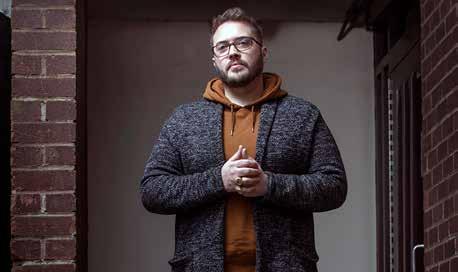
The exhibition’s curators have worked alongside many of those who were there at grime’s infancy, to create a ground-breaking display that not only tells grime’s backstory, but also shines a light on its future.
Highlights include a series of newly commissioned films exploring the black and working class community at the heart of grime’s ingenuity and influence; a large scale illustration from artist
64 BLACK HISTORY MONTH 2022
FROM
Willkay depicting the changing face of East London; personal artefacts from early grime MCs and producers including Skepta’s keyboard; and an installation recreating grime pioneer Jammer’s basement. The basement of Jammer’s Mum’s London home was the birthplace of the now-legendary ‘Lord of the Mics’ filmed grime clashes, starting with Wiley versus Kano.
The newly commissioned films include Keefe touring East London in a black cab with Jammer, Ruff Sqwad’s Rapid and Slix, and Troy ‘A+’ Miller from Practice Hours, reflecting on the music, people and places behind grime; and a film exploring new, emerging talent in London today, discussing the future of
grime and the impact of the city’s gentrification.

Dhelia Snoussi, the Museum of London’s Youth Culture Curator explained the importance of place in the exhibition, including the street corners and estates of east London.
“Grime stories: from the corner to the mainstream tells the story of grime in the fabric of London’s history: one of place and community, all built without the support of mainstream radio and friends in high places. The global success of the scene could not have been achieved without the social and physical infrastructure underpinning grime music. By honing in on significant landmarks that nurtured the music,
Grime Stories explores the relationship between sound and place and questions what the sonic consequences of urban gentrification might be for music in East London.”

Free tickets for the exhibition can be booked in advance, or picked up at the door on the day of your visit. The exhibition is suitable for all ages but the film content includes some strong and racially charged language that some may find upsetting. Warning notices are included to signpost this in the display.
Find out more and book your museumoflondon.org.uk/museumlondon/whats-on/exhibitions/grimestories
BLACK HISTORY MONTH 2022 65
The Adventures of a Black Edwardian Intellectual –James Arthur Harley
Athrowaway remark made by a tourist guide to Pamela Roberts while on holiday in New Zealand led her to discover James Arthur Harley archives in a battered suitcase in Shepshed, Leicestershire. The discovery has taken her on a five-year journey following Harley’s footsteps, visiting Antigua, Barbuda, America, Kentish villages, and coastal towns in England. The result – Roberts’ meticulously researched new book – The Adventures of a Black Edwardian Intellectual – The story of James Arthur Harley, Signal Books, 2022, tells Harley’s hitherto unknown story.
Scholar, reverend, politician, and perhaps aristocrat… who was James Arthur Harley?
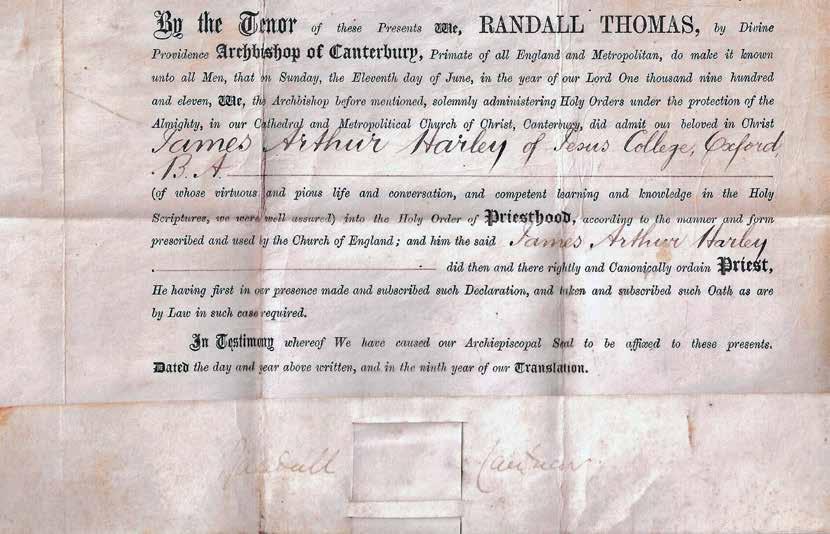
The son of a white landlord, Henry James Harley, and a black seamstress mother, Josephine Eleanor Lake. Harley was born on May 15, 1873, in the village of All Saints, Antigua. A poor island boy who dared to dream … and James Arthur Harley dreamed big.
His early education took place at the Mico School, noted as the best school on the island. He completed further studies at the Teacher’s Training college at Spring Gardens. He qualified as a teacher, later becoming a headmaster; however, his childhood vocation was to become a priest in the Protestant Episcopal Church (the American version of the Anglican Church). He left Antigua in 1899 for America to attend the oldest Seminary of the Episcopal Church and a leading centre for theological education in the Anglican Communion
– The General Seminary in New York.
He arrives on the cusp of the 20th century in 1899, an era steeped in horrific racial prejudice. In 1896, three years before his arrival, Plessy v. Ferguson’s historic case had implemented the overt racial separatist laws in the South of Jim Crow –separate but equal.
The GTS turns him away irrespective of personally addressed references to the Dean. He is directed with insistence to Kings Hall, Washington DC.
Despite his protest, Harley travels to Washington and learns Kings Hall, based at Howard University, is a college to train black clergymen. He enrolled on a Law course instead of theology and began the start of an academic career.
Harley takes a series of jobs to support himself at Howard, including a Sunday school teacher and choirmaster at the pinnacle church for the Washington black elite, St Luke’s, where he meets his future wife, Josephine Marchita Lawson.
Josephine’s parents, Jesse and Rosetta Lawson, the founders of Frelinghuysen University, provided adult education classes. They skirt the peripheral of Washington’s black elite society, protected from the harsh realities and daily humiliations of Jim Crow, but never entirely accepted into their elite circle.
In the proceeding years, Harley navigated the double complexities of the hostilities of white America and faced and dealt with African Americans’ resentment towards him as a colonial man of mixedrace heritage. He competed as an outsider against overt racism and financial difficulties to accomplish an esteemed education at Howard, Yale, Harvard, and Oxford Universities, with qualifications in law, theology, and Semitic Languages.
Subhuman, sub-species, a savage race, the perception of black people in Edwardian Britain and taught elements of the first Diploma of Anthropology course undertaken by Harley at the Pitt Rivers Museum, the University of Oxford in 1909. Harley made history as the first black student to achieve the Diploma.
After an eight-year long-distance relationship, Harley married Josephine in July 1910. They settled in the parish of his first curacy Shepshed, Leicestershire. A curate at St Botolph Church under the direction of the incumbent vicar, Reverend William Franklin Hepworth. Harley packed
66 BLACK HISTORY MONTH 2022
the church; people came to listen to his sermons, much to the disdain of some folk who considered the church to be packed with scum when he preached. Harley cited Hepworth’s disdain towards him as jealousy. Harley’s sermons were described as eloquent and inspiring. He inaugurated a men’s service, a men’s Bible class, and an English class for the study of Shakespeare and roused the population to the ‘true meaning of life.
St John’s Church in the rural hamlet of Chislet, Kent, became Harley’s second curacy under the direction of Rev Kent. He clashed with Rev Kent on several occasions, which required the interventions of Rev Randall Davidson, the Archbishop of Canterbury. His efforts brought people to the church from across the scattered parish; however, a similar pattern began to emerge.
On June 11, 1911, Harley finally realised his vocation when he was ordained at Canterbury Cathedral. He officiated over christenings, weddings, and burials in the parish of Deal at St Leonard’s Church for a further three years. On August 4, 1914, Britain declared war on Germany. Harley answered Kitchener’s call – on the home front. He trained at Goldsmith and Kings College, London, to become a skilled munitions worker. Harley returned to Shepshed to work in the munitions factory, where he finally settled.
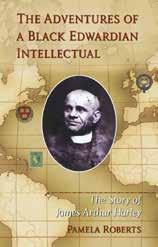
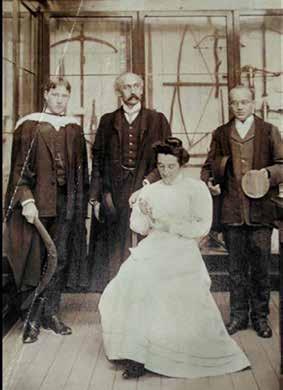

Harley reinvented himself as a local politician, his campaign centring on the Council’s wasteful spending and higher taxes.

He was elected to the Shepshed Urban District Council. In 1928, outspoken, provocative with an unorthodox style, one of his first proposed motion to his all-white fellow councillors informed them via the following motion:
In view of the unfair completion, undue influence, sly bribery, and insidious corruption tainting the atmosphere of so many local government bodies in nearly every nook and cranny in England. This Council calls upon any Councillor who
works for or trades with the Council at any time to ignore the disgraceful practice of the present: to remember the excellent custom of the past, and to resign his office of Councillor in common honesty rather than remain on the Council to grab all he can for himself while in office, by his office, and through his office surreptitiously.
Harley’s self-appointed role as scrutiniser of the Council continued through his weekly produced newspaper – The Charnwood Bulletin
Harley suffered a heart seizure on May 12, 1943, at age sixty-nine. On his seventieth birthday, May 15, 1943, he was buried at Leicester’s Oaks-in-Charnwood Cemetery. Fifty-four years after his death, his legacy continues. John Rippon wrote: A road is to be named after one of the most remarkable people ever to live within our circulation area. Shepshed Town Council has recommended that the new development be called ‘Harley Close’. Here, Here! I say. For a memorial to the Rev. James Arthur Harley is long overdue. When I was Echo’s Shepshed reporter, plenty of folks around could still remember the multi-talented West Indian. So colourful were the stories that I was promoted to write a long feature article headed ‘Was fiery M.A. Shepshed’s man of the century?’’
Pamela Roberts is an awardwinning creative producer and historian. The author of Black Oxford: The Untold Stories of Oxford University’s Black Scholars, her work as Founder and Director of Black Oxford Untold Stories has raised the profile of many black scholars from the turn of the twentieth century. She is a Fellow of the Royal Society of the Arts, a Fellow of the Royal Historical Society and an Eccles Centre Visiting Fellow at the British Library.
BLACK HISTORY MONTH 2022 67
Left: Harley’s ordination paper. Below, clockwise: Harley at Pitt Rivers Museum; dressed as a curate; Harley’s campaign poster.
TWO WOMEN: BOTH WITH A PASSION TO COMMEMORATE GLOBAL AFRICAN CONTRIBUTIONS
Kwaku provides a personal reflection of history advocate Oku Ekpenyon and human rights activist Epsy Campbell Barr, and explains why conscious Africans, allies and Afriphiles urgently need to engage with them.
renamed Routes of Enslaved Peoples, will form part of the World Heritage Project linking the key global sites associated with the trafficking and enslavement history.
It will give public recognition and acknowledgement to millions of Africans who were victims of the so-called Slave Trade, or the Trans-Atlantic Trafficking Of Enslaved Africans. The Enslaved Africans Memorial Garden will be located in the Rose Garden of Hyde Park.
Ekpenyon, born in post-World War II London of indeterminate age who was “a very young child at the time of the Queen’s coronation in 1953,” is a soft-spoken, elegant and determined lady. She’s a former history teacher, who in 2010 was awarded an MBE for ‘voluntary service to the history of Black British people’. Her father, who migrated from Nigeria in 1928, has a well-documented history, which belies the centrality of British African history ascribed to Windrush.
EE. Ita Ekpenyon was a headteacher in Nigeria who came to England to study law. Whilst financial challenges put paid to his legal aspirations, he managed to act in a number of British films in the 1930s-40s with the likes of Paul Robeson; contributed to editions of the BBC’s ‘Calling West Africa’, which is lesser known than its ‘Calling The West Indies’ counterpart; helped outdoor a British Army tank paid for by a Nigerian chieftaincy; and was an ARP (Air Raid Precaution) warden in the borough of Westminster, from 1940 until World War II ended in 1945.
She is the founder and chair of Memorial 2007 (M2007). It aims to erect Britain’s first permanent national memorial and garden to honour the millions of enslaved Africans and their descendants. The memorial, which is supported by UNESCO’s Slave Route Project, now officially
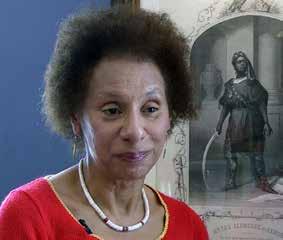
“Our ancesters deserve a good site,” says Ekpenyon, reminding me of the fact that the planning permission for the M2007 memorial in the prime central London location lapsed in November 2019, because they could not raise enough funds to unveil the memorial
She and her M2007 trustees aim to re-apply for the planning application, but they need your support.
The M2007 idea came about after Ekpenyon, then a London secondary school history teacher who rose to be head of history, took a group of students on an educational visit to the Tower of London. Afterwards, a girl of African heritage asked her: “Where is our history?”
It was not until 2002 that she found the time to found a small voluntary group with a vision to have a monument in place in London during the 2007 bicentennial commemoration of the 1807 Act that abolished the Trans-Atlantic Trafficking Of Enslaved Africans.
Sadly, the five year window came and went, and although there were numerous Abolition and Enslavement activities in 2007, some derisively called Wilberfarce or Wilberfest, the M2007 memorial was not one of them. However, M2007 became a registered charity in that year.
Also, a campaign she launched in 2005 resulted in Royal Mail issuing a set of stamps in 2007 to commemorate the bicentennial. “The set featured the African Abolitionists Ignatius Sancho and Olaudah Equiano, alongside some of the white Abolitionists, such as William Wilberforce and Grenville Sharp.”
She co-founded in 2007 the Ira Aldridge Bicentenary Project to mark the centenary of the the birth of the eponymous African American Shakespearean actor. She produced the group’s educational pack, and they produced a play about Aldridge at the Old Vic, which the actor performed at in the 1820s, when it was known as the Royal Coburg Theatre. Three years prior, in 2004, Ekpenyon managed to get Aldridge’s portrait unveiled in the south-east London theatre.
The history advocate also unveiled in 2007 an English Heritage Aldridge blue plaque on the Shakespearean actor’s former south London home, interestingly in Hamlet Road!
Seeing the importance of the M2007 project in recognising the historic contributions made by Africans in Britain, and which continue today with their descendants, I’m supporting it, and I think it behooves every African in Britain to do their bit to make the M2007 memorial a reality.
The ambition must be to get it done before the United Nation’s International Decade for People of African Descent ends in 2024.
It is a laudable but hard sell. Because even with the likes of Lord Boateng, Baroness Lawrence, and the late Kate Davson, the great-great-greatgranddaughter of the abolitionist Wilberforce and great supporter of M2007, as patrons, and a host of politicians, academics, historians and celebrities expressing their support, progress has been slow.
There’s a Change.org petition asking financial help from the Prime Minister and the Ministry of Housing, Communities & Local Government, now called Department for Levelling Up, Housing and Communities. The petition has garnered over one hundred thousand signatures. It’s a simple thing to add one’s name, bearing in mind the higher the number of signatures, the better the demonstration of the support for the project.
68 BLACK HISTORY MONTH 2022
BY KWAKU
Whilst still trying to get funding from the government, which has funded memorials for World War I, the Holocaust, and even the Srebrenica genocide victims, Ekpenyon thinks this is a project that can be funded by a “do for self” attitude, like what underpinned Marcus Garvey’s UNIA (Universal Negro Improvement Association) projects a century ago.
“Realistically speaking, the government is not interested,” says Ekpenyon matter of factly. Indeed, M2007 had the support of Boris Johnson when he was London Mayor, and a maquette of the statue was displayed in City Hall in 2008.
At the time, Johnson was fulsome in his support for the M2007 project, saying: “It is important that this era in our history is never forgotten. Hyde Park is a fitting site for a permanent memorial to the millions who lost their lives and the courageous people who fought to end the brutal trans-Atlantic slave trade.”
Sadly, no cash or any meaningful support came when he joined the government in 2016. Not even when he became Prime Minister in 2019.
But Ekpenyon is sanguine, as she has set her sights on Britain’s African communities. The £4m or so needed for creating the statue and maintaining the park site for years to come can be achieved, if “we’re self-realiant – we need to work as a community to raise the money ourselves,” she urges.
Ekpenyon is exploring a variety of potential donors, including the Church of England, with whom she’s engaged in “ongoing talks.”
To make Ekpenyon’s twenty year dream a reality, please support financially by going to the Memorial2007.org.uk Donate page. As a registered charity, donations by UK tax payers attract a top-up from the government’s Gift Aid scheme, which Ekpenyon wants eligible donors to use. “It all adds up, as it maximises one’s donation by 25%,” enthuses Ekpenyon. Also, sending a cheque or bank transfer means the charity receives the full donation without deductions.
If you need a reminder as to why you should urgently help, here’s Ekpenyon’s reminder: “The wealth created by enslaved Africans in the Caribbean contributed to putting the ‘Great’ into Great Britain, and yet there is no recognition in this country of their input. That is why they are deserving of a memorial.”
Epsy Campbell Barr, born in the early 1960s in San José, is a stylish economist, environmentalist, womanist, human rights activist, and a politician who served as the First Vice-President of Costa Rica from May 2018 to 8 May 2022. She was the second African woman Vice President in the Americas, following Viola Burnham’s 1985–1991 term in Guyana. The third is Francia Márquez, a human rights, environmental activist and lawyer, who in August of this year became the Vice President of Colombia.
Epsy’s grandparents were immigrants – her maternal grandmother relocated from Jamaica as a child. A co-founder in 2000 of the Citizens’ Action Party (PAC), she ran for president in 2010 and 2014, and was a deputy in the Legislative Assembly from 2002 to 2006 and 2014 to 2018. She’s a graduate of universities in Costa Rica, Spain and the US.

Most of this was unknown to me until the last year, when I discovered she was part of the Costa Rican government that was responsible to getting the United Nation’s General Assembly, with the support of fifty-two countries, to pass the motion that adopted 31 August as the International Day for People Of African Descent (IDayPAD) in December 2020.
I then retweeted to let her and her political colleagues know that the African advocacy project I lead, TAOBQ (The African Or Black Question), has been marking 31 August as African History Reflection Day (AHRD) since we commemorated in London in 2014 the centenary of the founding of the Marcus Garvey-led UNIA-ACL (Univeral Negro Improvement Association-African Communities League).
I was impressed to find out that IDayPAD, like AHRD, was inspired by the same thing – the Declaration of Rights of the Negro Peoples of the World, which was unanimously adopted at the First International Convention of the Negro Peoples of the World convention held in New York in 1920.
So it was a no brainer to invite Barr as a special guest at this year’s AHRD event. The first thing she said in her introduction was that she was “an activist.” This was what she chooses to characterise her, more than the Vice Presidency, which brought her much fame.
The importance of commemorating 31
August, which is a Costa Rican national holiday, she says: “helps to make visible the reality of people of African descent around the world … our culture, contributions, and the vindication of our rights as people, to contribute to those who came before us.”
Costa Rica has several UNIA chapters and two Liberty Halls. In 2016, the Black Star Line building in Limon, also known as Liberty Hall, was destroyed by fire. Although the government has put up some funds, it’s not enough to cover the rebuilding of what is a listed national heritage property.
I asked Barr if it was OK for us to galvanise Garveyites, global-Africanists and all interested, to explore setting up a crowd fund to contribute towards the cost of the rebuilding. Watch the BHM Magazine website for an update on an online meeting with Barr to discuss this issue.
Finally, Barr, who’s a member of the UN Permanent Forum of People of African Descent, says its members are open to networking with African communities.
Interested persons can engage with the Permanent Forum in person or online at the following formal sessions, firstly on 5–8 December in Geneva. The second session will be 30 May–2 June 2023 in New York City.
Oku and Epsy come from different generations and different continents. In addition to being born in their country’s capital to families of migrant stock, these high achievers share something else in common – their passion to highlight and commenorate global African history, and it’s connection to Britain and the world, respectively.
BLACK HISTORY MONTH 2022 69
Kwaku is the coordinator of TAOBQ (The African Or Black Question), which is convening a Zoom roundtable meeting on Saturday 3 December 2022, 3.00–6.00pm entitled ‘International Decade For People Of African Descent 2015–24: What Practical Gains Can We Make From The Last Two Years Of IDPAD’
198 CONTEMPORARY ARTS & LEARNING

A unique space in London, and so much more than a Black art gallery in Brixton

Steeped in radical history spanning over 50 years, Brixton’s Railton Road is home to 198 Contemporary Arts & Learning - a centre for visual arts, education, and creative enterprise. In 1988, founders Zoe Linsley-Thomas and John ‘Noel’ Morgan took over an unused shop unit on what was known as Brixton’s ‘front line’ after the uprisings and opened one of London’s first Black art galleries.
Initially showing artists from the African Diaspora, Zoe started reaching out to local primary schools to give children tours and activities around the creative arts. Soon the education programme was born, and 198 began offering training to local hard-to-reach youth, supporting them into further education and careers in the arts.
She worked the phones and fundraising appeals allowing her to grow the organisation by taking over a further two unused shop units, expanding the gallery and opening a dedicated education space, creating not only a space for
70 BLACK HISTORY MONTH 2022
local and international Black & Brown artists but also a site for education, enterprise and creative expression.
After its first exhibition ‘Contemporary Art by Afro-Caribbean Artists’, 198 went on to hold a space for many creative practitioners and hosted first exhibitions for some of today’s established names, such as Rotimi Fani Kayode, Denzil Forrester, Hassan Aliyu, and Barby Asante. 198 survived and thrived over the next three decades, navigating the highly challenging fundraising landscape and continuing to evolve its artistic and educational programmes. After obtaining the freehold to their site in 2015, the organisation raised capital funds for a major construction project, building two new floors on top of the original structure. This has opened a plethora of new ways to support the local community and contributed to making the building more flexible and self-sustaining.
In 2017, the organisation began working with Carver Haggard; a local architectural design and research practice, to develop the brief and design through joint workshops and live projects. The organisation went on to receive planning permission and GLA funding in 2018 and the project broke ground in early 2020, just as Brexit and Covid started to have an impact. Nevertheless, the building was completed on time and on budget and opened to the public as soon as Covid allowed, with a group show of Congolese artists: ‘Breaking the Mould: New Signatures from the Democratic Republic of Congo’. In 2022 the new building won the RIBA regional award for Urban Design.
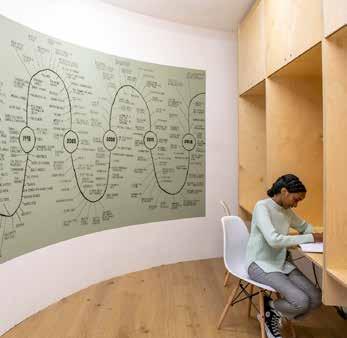
Recently, with the possibilities of the new building the artistic program has flourished and showcased an array of talent. This September 2022 marks a year since the reopening of 198 Contemporary Arts & Learning, which has since shown works by upcoming and more established artists alike: including Amartey Golding, Pearl Alcock, Eva Sajovic. Part of the approach is to work with various curators and collaborators from the likes of Marlene Smith, British artist, and curator and one of the founding members of BLK Art Group, and Christine Eyene, art critic, art historian, and curator. This October the gallery welcomes back Ben F. Jones for ‘The Bigger Picture’, after showcasing his earlier works in 1994 for his show ‘In the Spirit’.
Nearly a year since its regeneration we asked what the new building means for 198 and the local community. Director Lucy Davies explains: “The Ben Jones show is an example of our work to support Black and Brown artists throughout their careers. We have long relationships with our artists
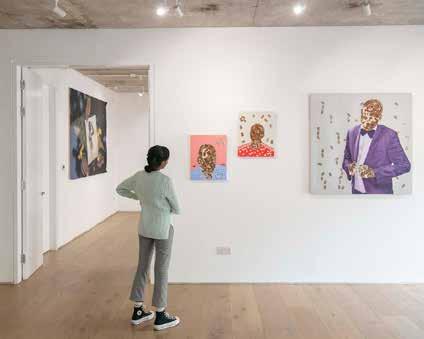
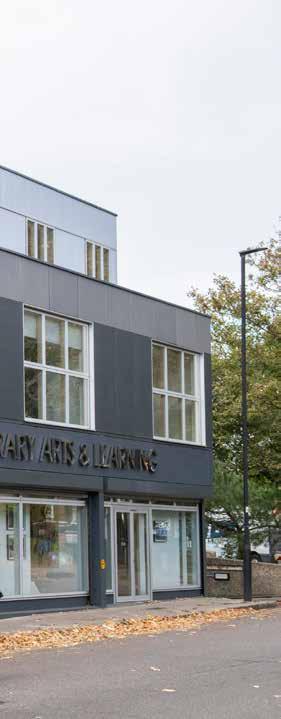
and curators, often starting with them in their early careers and providing them with a safe space while they grow. We are a strong community of people with the common desire to support and celebrate the creative expression of people of colour. Our new building has given us fantastic exhibition space, and a whole floor dedicated to creative learning, as well as a floor of workspace for rent that helps us to build financial sustainability.
“The strength of our concept is to provide services to creatives throughout their life stages: we begin by introducing children to the potential of a future in the creative arts, then provide skills development to support young people as they develop their voice, and ultimately offer them a space to exhibit or start an enterprise. It’s like a spiritual home for your creative life.” Davies cites the Womxn of Colour Art Awards as a good example of 198’s work to uncover artists to watch, and provide opportunities for those who are so often marginalised. “We work to develop and provide an outlet for emerging Black and Brown voices in the arts and creative fields. We also bring the wisdom and experiences of our elders into the mix. For example, with oral history events like ‘A Life in Activism: An Audience with Leila Hassan Howe’ where she talks about her involvement with the struggles for racial equality and social justice, dating back to the black power era.”
According to 198’s chair, poet, activist and recording artist Linton Kwesi Johnson: “198 is a unique space in London as it is so much more than a Black art gallery. We have an enviable reputation for promoting excellence in the arts and continue to be committed to local relevance.”
BLACK HISTORY MONTH 2022 71
M aya was born Marguerite Johnson in St Louis, Missouri, on 4 April 1928, the daughter of a nurse and nightclub habituee, Vivian Baxter Johnson, and a doorman and Navy cook, Bailey Johnson. Her parents soon divorced and her mother, unable to cope with two small children, sent Maya and her brother Bailey Junior to live with their grandmother, who kept a general store in the Black section of Stamps, Arkansas. The name Maya came from her brother’s childish way of saying “My-a sister”.
Personal trauma
Angelou spent much of the next 10 years growing up in one of America’s poorest regions, experiencing first-hand the racial segregation and prejudice of the Deep South: an experience brought vividly to life in her first volume of autobiography, I Know Why the Caged Bird Sings, published in 1970. At the age of seven, on a visit to St Louis, she was raped by her mother’s boyfriend. When she told her family what had happened the man was arrested, tried, released from jail and shortly afterwards murdered – probably by her uncles, her mother’s brothers. For the next five years she didn’t speak.
“I was a volunteer mute. I had voice but I refused to use it,” she later recalled. “When I heard about his murder, I thought my voice had killed a man and so it wasn’t safe to speak. “After a while, I no longer knew why I didn’t speak, I simply didn’t speak.”
Extraordinary career
But, though mute, she read voraciously and was ultimately persuaded to speak
again by a friend of her grandmother who recognised her passion for poetry and told her that, to be experienced fully, it had to be spoken aloud. Angelou later recalled her saying: “You will never love poetry until you actually feel it come across your tongue, through your teeth, over your lips.”
Later she went to live with her mother in San Francisco (and renewed her relationship with her father, also living in California).
At the age of 15 she badgered one of San Francisco’s streetcar companies into making her the city’s first female cable car conductor. At the age of 16 she gave birth to her only child, a son, after a loveless one-night stand undertaken largely in a spirit of inquiry. Before long she had embarked on an extraordinary career that included stints as a dancer, waitress, prostitute and pimp. She became an actress and singer, recorded an album of Calypso songs, appeared on Broadway and travelled to Europe in a touring production of Porgy and Bess.
Along the way she acquired two or possibly three husbands (she was always a little vague about the facts), and took her surname from the first, an aspiring Greek musician called Enistasios Angelos.
In 1961 she worked for a time as northern co-ordinator for Martin Luther King’s Southern Christian Leadership Conference, then followed a South African freedom fighter, Vusumzi Make, to Cairo, where she became a journalist. Later she took her son to Ghana, where she met the Black activist Malcolm X. She returned to the United States in 1965 to work with him, but he was killed shortly afterwards. A few years later Martin Luther King too was assassinated.
“I along with a number of young people at the time had been disenchanted, and felt angry and protested inequality,” she later
told the BBC when she recalled her time with Martin Luther King and Malcolm X.
“But until the Civil Rights movement came along there was no clear way to oppose the inequities. “I was very sure that between the two men, and the women, between the followers of both groups, we would certainly have a land where all the people, all the faith groups, all the Adams and Eves would have a chance to stand for a while in the sun. When those two men were killed we all stumbled about like blinded moles. It was really disastrous for Black Americans.”
Academic career
It was around this time that her friend, the writer James Baldwin, helped persuade her to write her first volume of autobiography. It was a best seller, and six more volumes followed over the decades.
She began publishing poetry as well, wrote a feature film screenplay, wrote and presented a 10-part TV series about the Blues and Black Americans’ African heritage, and played Kunte Kinte’s African grandmother in the ground-breaking TV series Roots, about the Black experience of slavery.
In the 1980s she added another string to her bow, becoming an academic and professor of American studies at Wake Forest University in North Carolina, a prestigious white university. In the kitchen of her home there (one of several she maintained, including one in New York’s Harlem) she practised another skill for which she was renowned, cookery.

By now she was perhaps the world’s best-known Black female writer and one of America’s best-known Black women.
Bill Clinton acknowledged her status when he asked her to read a poem at his inauguration in 1993. Called On The Pulse of the Morning, it included the lines:
72 BLACK HISTORY MONTH 2022
MAYA ANGELOU Charismatic and passionate, warm and wise, formidable without being forbidding, American author and poet Maya Angelou was a role model and an activist who recorded and celebrated the experience of being Black. Black History Month looks back at her extraordinary life. POET, AUTHOR, CIVIL RIGHTS ACTIVIST (1928–2014)
In 2010, Barack Obama awarded her the Presidential Medal of Freedom.
Shortly afterwards she recalled that Martin Luther King, in the 1960s, had predicted that America would have a Black president in 40 years: she hadn’t believed it possible and had supported Hillary Clinton’s bid for the Democratic nomination (the two were long-standing friends). Throughout her life she was a superb phrase- maker, on the page and in the flesh. She had the knack of speaking – in the Southern accent she retained all her life and with a characteristic slow, deliberate delivery – in complete and grammatically perfect sentences.

She was a commanding figure, standing six feet tall, and immensely striking.
Of all her achievements, perhaps the most impressive was her own character. Life, she believed, was to be lived. “The excitement is not just to survive,” she once said, “but to thrive, and to thrive with some passion, some compassion, some humour and some style.”
BLACK HISTORY MONTH 2022 73
“History, despite its wrenching pain, cannot be unlived/But if faced with courage need not be lived again.”
YOUR SILENCE WILL NOT PROTECT YOU AUDRE LORDE CHANGE … TIME FOR
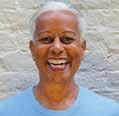
We believe that language is key to understanding and talking about societal issues, particularly in relation to being a person of colour.
Our journey has led us to explore a range of definitions and this book contains a selection of these, together with our own interpretations that allows us to reflect on the differences that exist in contemporary society. (Extract from the foreword of My Little Black Book)
Deciding to write My Little Black Book – A Blacktionary: A glossary of terms and phrases, in 2021 was no accident. After the tragic event of George Floyd’s death in May 2020, businesses felt they were in the spotlight and uncertain of the right steps to take. Our corporate clients asked us to help them navigate the language of race through the lens of Black people.
During our research it became apparent that compiling a glossary would be a starting point to provide understanding and support to organisations and for anyone who needed it. It was also a way to remove the excuse ‘I don’t know how to’.
The workplace is where change can happen and fast. It’s also a place where uncomfortable conversations need to be had and what better way than a pocket sized Blacktionary to get conversations going. It takes courage to admit that you need help and even more to have conversations that are difficult.
For instance, one of our phrases, Code Switching is defined as: adjusting one's style of speech, appearance, behaviour and expression in ways that will optimise the comfort of others in exchange for fair treatment
We place the phrase in context: Adjusting ourselves to different situations is something that most of us do consciously. Think about a time when you were in a social setting and you felt that the topic of conversation was excluding you. Initially, you probably showed interest by nodding or making the odd comment in agreement. This is code-switching and we all do it.
However, for some people codeswitching is a regular way of life. Many people of colour will be used to codeswitching and do so by trying to ‘fit-in’,

hoping that by making others feel comfortable, they will be treated more fairly.
While we all like to belong to groups be they social, familial or professional, fitting-in takes many forms. We may feel the need to dial down our accent, alter the way we dress, change our hairstyle or hide tattoos. Much depends on the dominant culture which may be explicitly or implicitly stated.
Understanding what code-switching is and its impact, allows organisations to gain an insight into what behaviours Black employees are having to display in exchange for fair treatment
When we think of the future, we like to imagine a world where the voice of women is truly heard and understood. Where there is equality and equity,
hand-in-hand so that any outcome is equal. Think of how many more female owned businesses there would be that would go beyond a three-year start-up phase. Where investors and financial institutions encouraged women-owned businesses to innovate to stimulate new markets. And for women in corporate companies, that their talents were honestly recognised and rewarded. Yes, things are changing but not fast enough. We are reminded of the great singer Aretha Franklin’s cover song of Sam Cooke’s 1964 Civil Rights anthem ‘A Change is Gonna Come’.
Jane Oremosu and Dr Maggie Semple, OBE – co-authors of My Little Black Book –A Blacktionary. Available from i-cubedgroup.co.uk and independent bookshops.
MEET THE AUTHORS –DR MAGGIE SEMPLE OBE AND JANE OREMOSU
Maggie: There are a few things I know about myself. I’m curious, I have a high tolerance for ambiguity, I like storytelling and I view the world through multiple lenses. The combination of these attributes enables me to be action focussed with a strong desire to create change and not just one change. For example, in the mid-2000s I was a Civil Service Commissioner. I was appointed a member of the Queen’s Counsel Panel in 2017, and in 2020 I initiated the Black British Voices Project.
Of course, creating change is not a solitary pursuit. Effective action requires an inner motivation and belief that things must change and for the better. But the art is how you inspire others to join you. For me, being seen for taking small and regular actions, being visible about belonging to a wider community of interest and being prepared to respectfully challenge others, are three ideas.
Jane: Moving to the UK as a young woman, having lived most of my life in Lagos, Nigeria provided different cultural contexts and perspectives with which I viewed life through. I realised early on in my career that change is an inside job and begins first with ourselves. How we treat ourselves determines how we treat others. This has been my foundation for action, be the person that you want to see.
Working with corporate organisations to facilitate behavioural change can be daunting especially when it means challenging the status quo. However, creating that space for organisational introspection, though initially uncomfortable for those involved, is ultimately rewarding as it leads to a better understanding of how thoughts, words and actions can impact others negatively or otherwise. This for me is most fulfilling in my role as a change maker.
74 BLACK HISTORY MONTH 2022


PROUD SPONSOR OF BLACK HISTORY MONTH 2022 Our partners are organisations and companies who are actively seeking to recruit from minority groups, regardless or race, gender, ethnic origin, disability or sexual orientation. www.diversitydashboard.co.uk BECAUSE RACE EQUALITY MATTERS
ENGINEERING
SECURITY AND RESILIENCE OPERATIONS

INTELLIGENCE
MEDICAL SERVICES
ROLE
LOGISTICS
PEOPLE OPERATIONS
AIR & SPACE OPERATIONS
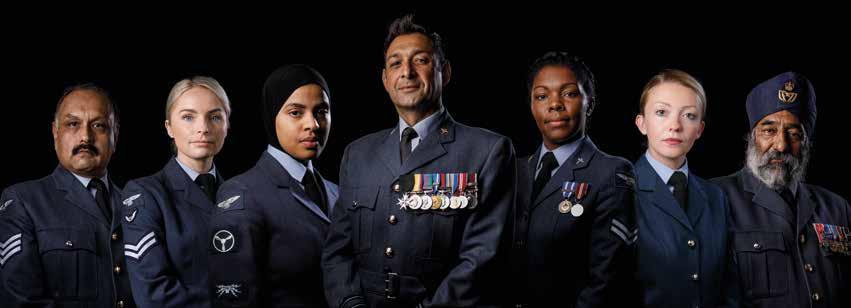
Operations
Operations
LEGAL
FIND YOUR
Excellent starting salary and career progression Guaranteed job after successful training Gain civilian-recognised qualifications
Engineering Officer Aerosystems Aircraft Technician Avionics Aircraft Technician Mechanical Vehicle and Mechanical Equipment Technician Weapon Technician General Technician Workshops RAF Electrician Survival Equipment Specialist Photographer CYBERSPACE Engineering Officer (Communications and Electronics Cyberspace Communication Specialist Communications Infrastructure Technician Joint Cyber Unit*
RAF Regiment Officer RAF Police Officer Personnel Training Officer RAF Regiment Gunner RAF Police Physical Training Instructor Firefighter
Legal Officer
Intelligence Officer Intelligence Analyst Intelligence Analyst (Linguist)
Medical Officer – Doctor Nursing Officer Medical Support Officer Medical Support Officer – Environmental Health Medical Support Officer – Physiotherapist Medical Support Officer – Pharmacy* Dental Officer Registered Nurse (Adult) Registered Nurse (Mental Health) Student Nurse RAF Medic Environmental Health Practitioner Operating Department Practitioner Radiographer Biomedical Scientist Pharmacy Technician Dental Nurse
People Operations Officer People Operations Media Operations Officer* Media Operations*
Logistics Officer Chef Air and Ground Steward Supplier Mover Driver Musician AIRCREW Pilot including Remotely Piloted Aircraft Systems Weapons Systems Officer Non-Commissioned Officer Weapons Systems Operator
Air
(Control) Officer Air
(Systems) Officer Air Traffic and Weapons Controller Air and Space Operations Specialist Air Cartographer Flight Operations Manager* CHAPLAINCY Chaplain *only available as an RAF Reserve Role Search RAF Recruitment 0345 605 5555 /rafrecruitment @RAF_Recruitment Correct at time of publication 07/2022 76 BLACK HISTORY MONTH 2022






























































































































































 BY LYNDA-LOUISE BURRELL
BY LYNDA-LOUISE BURRELL










































